Diversity Final
1/147
There's no tags or description
Looks like no tags are added yet.
Name | Mastery | Learn | Test | Matching | Spaced |
|---|
No study sessions yet.
148 Terms
All of the following are three things all generations need except:
A. Belonging and psychological safety
B. Encouragement to contribute
C. Safe space to challenge the status quo
D. Financial independence
D. Financial independence
(Read A-C!)
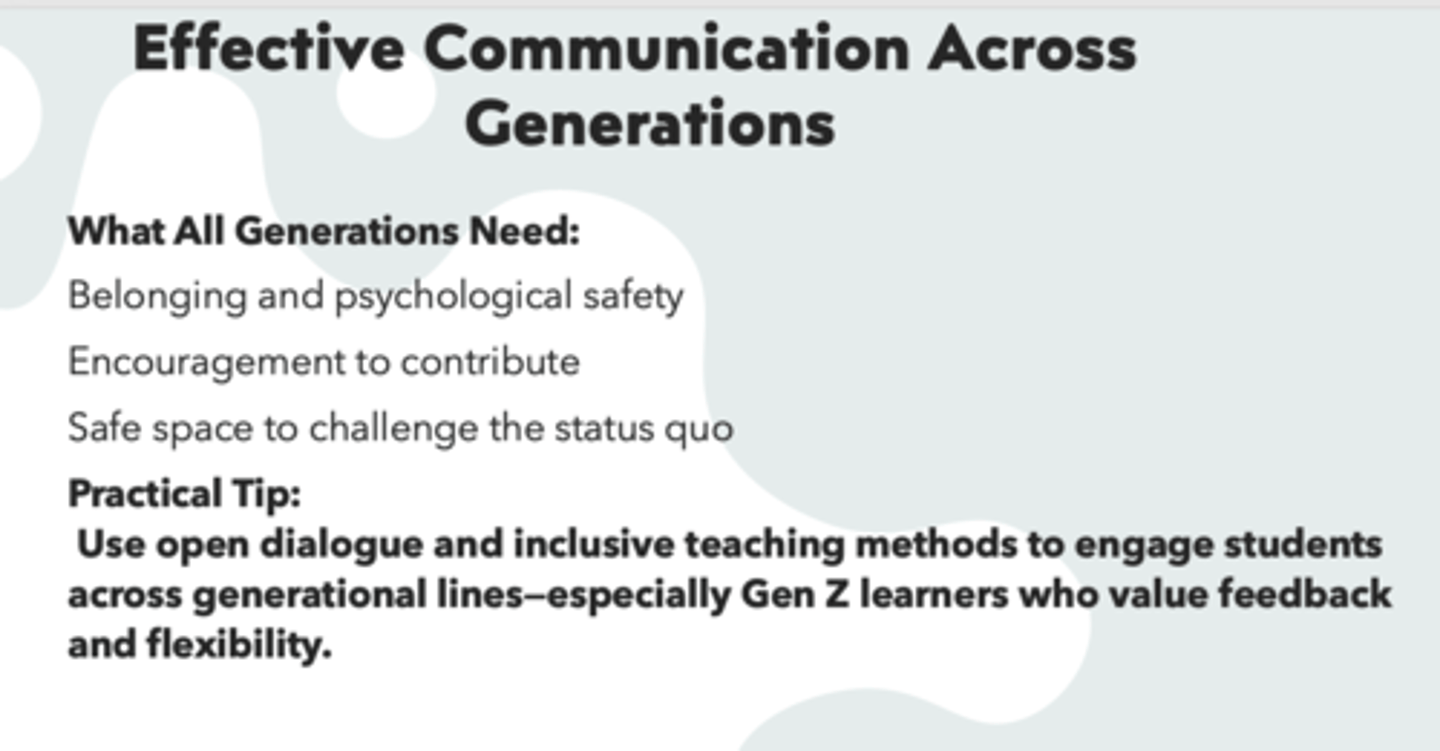
Use _____________ and _____________ to engage students across generational lines—especially Gen Z learners who value feedback and flexibility.
Open dialogue, inclusive teaching methods

What generation years are baby boomers?
1946-1964
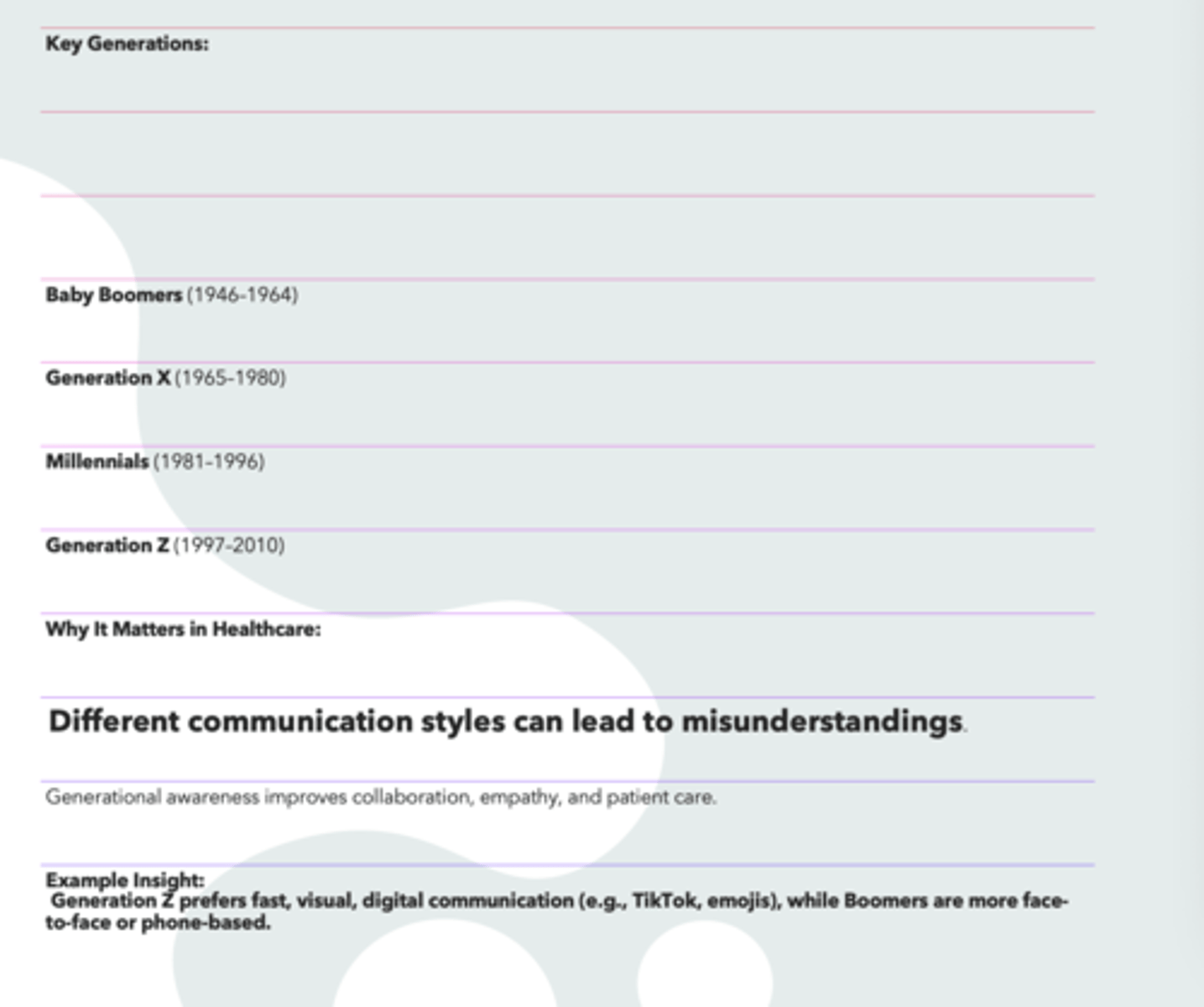
What generation years are Gen X?
1965-1980
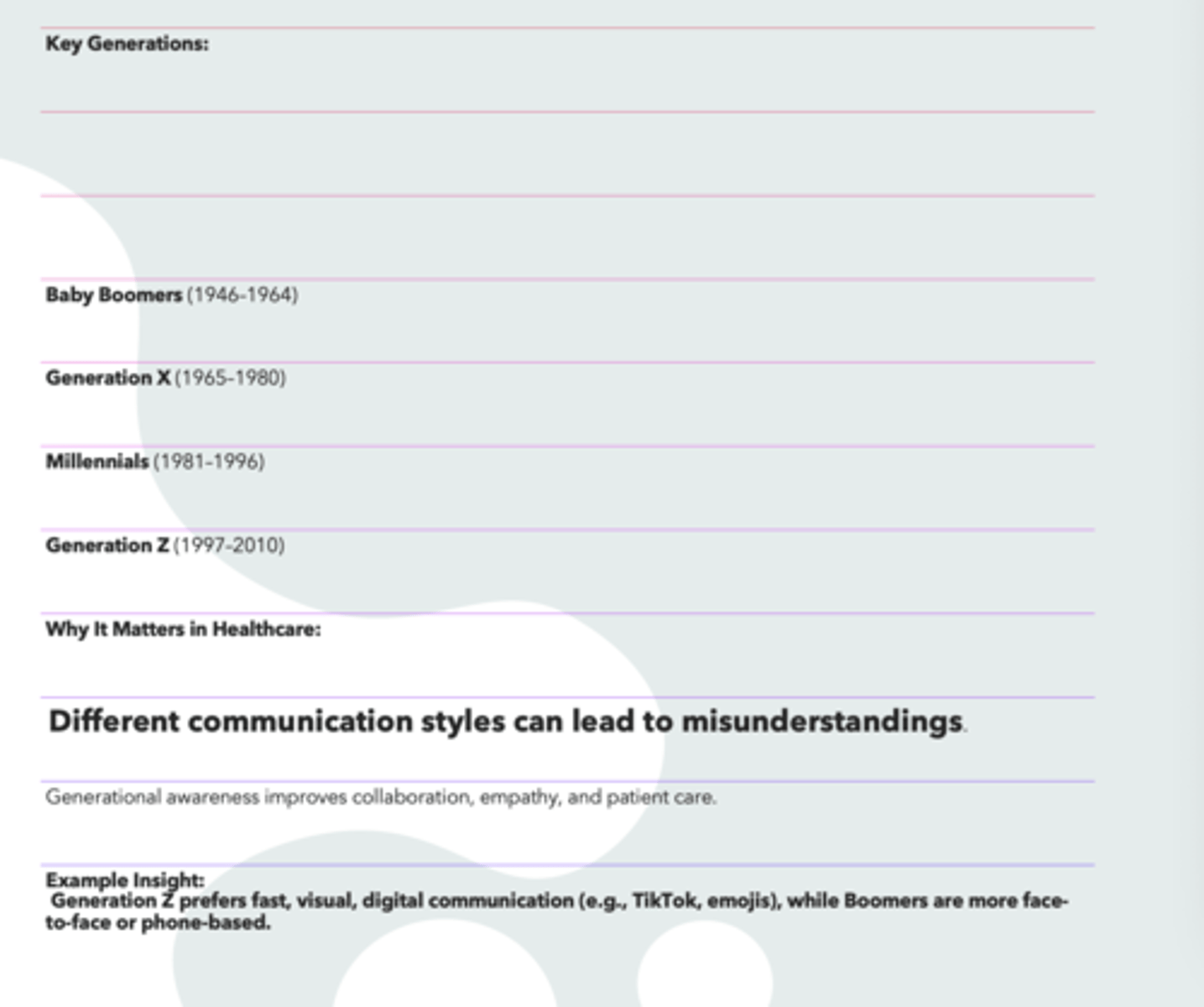
What generation years are millennials?
1981-1996
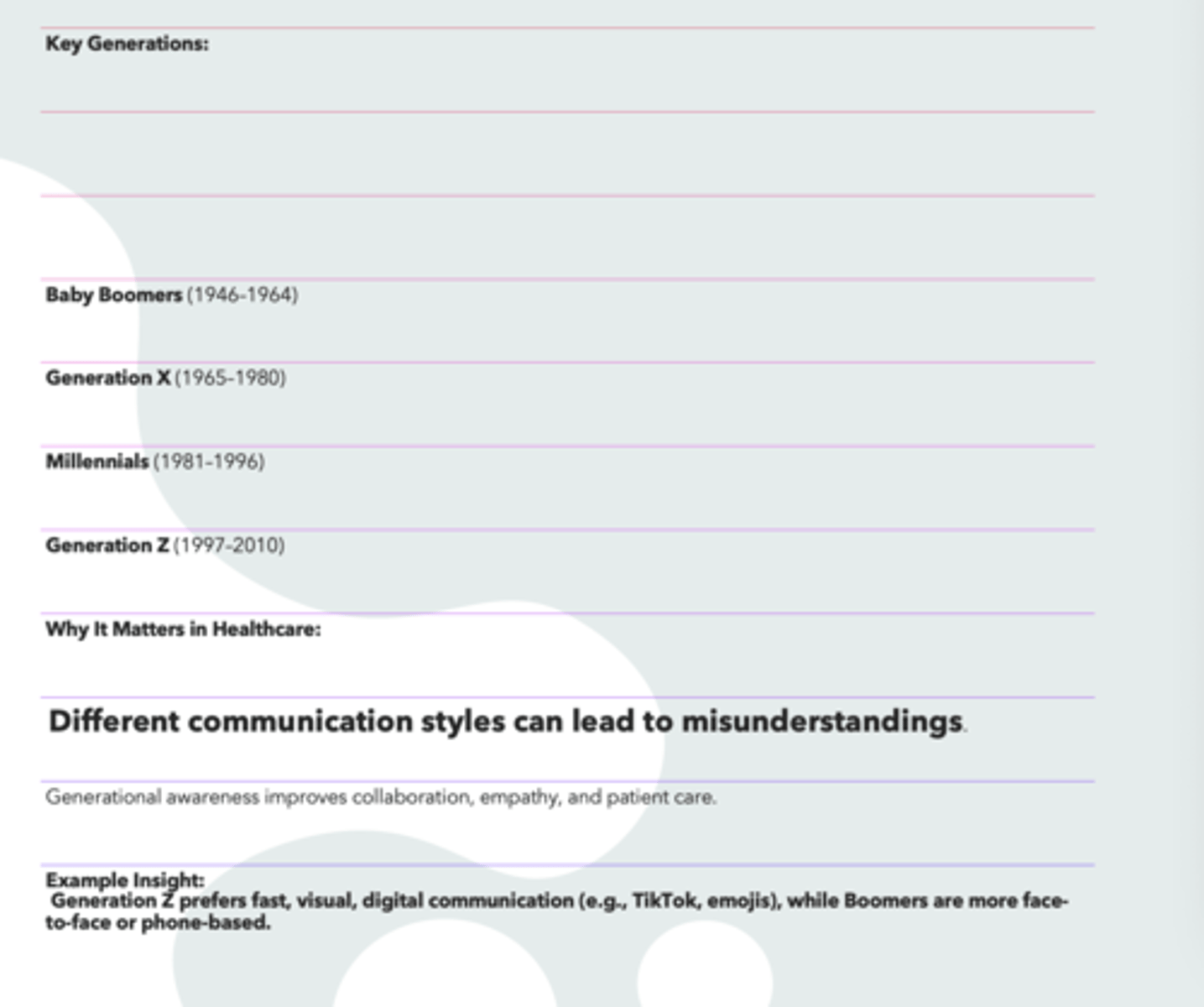
What generation years are Gen Z?
1997-2010
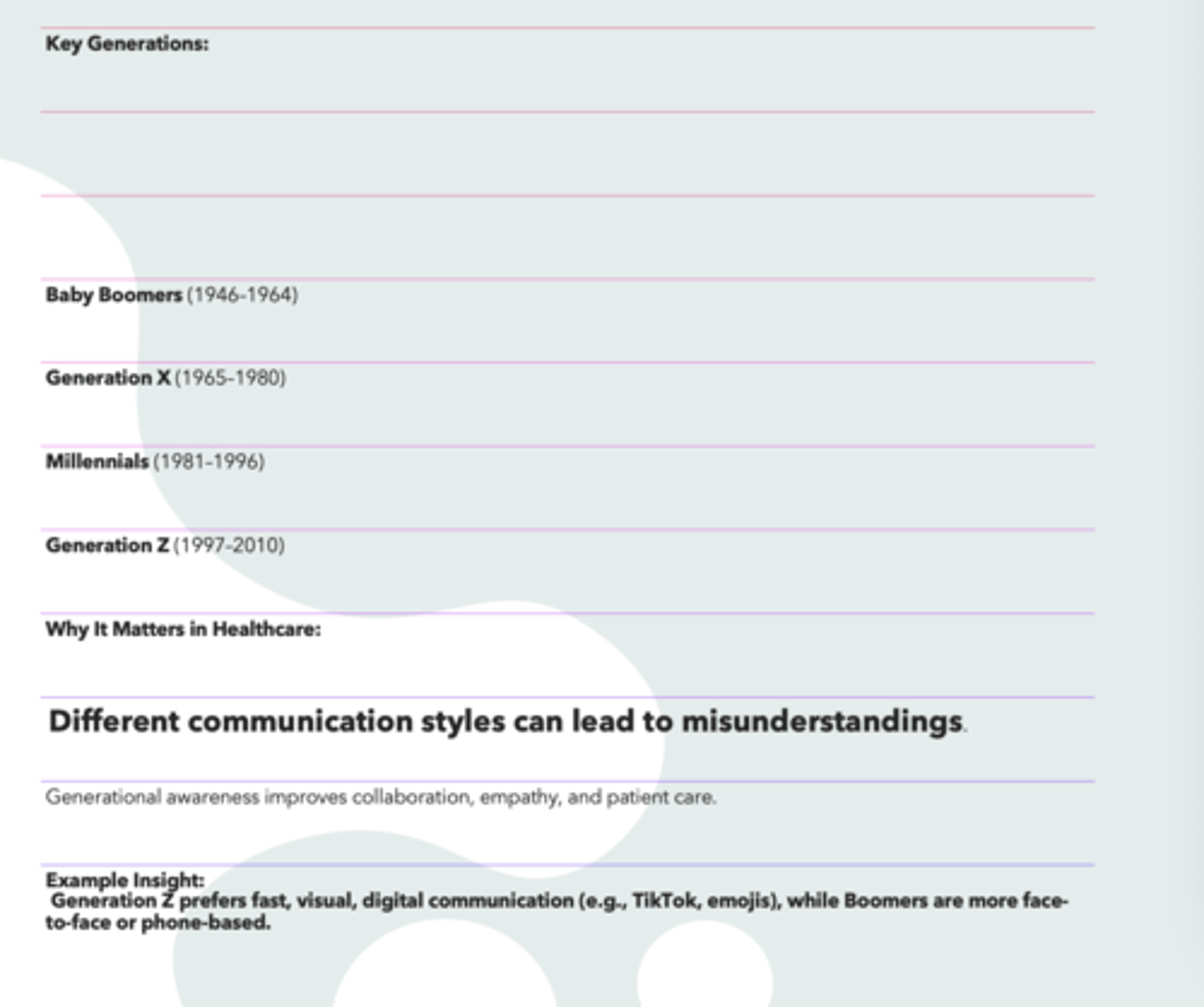
Why do generational years matter in healthcare?
Different communication styles can lead to misunderstandings

T/F: Generational awareness improves collaboration, empathy, and patient care.
True

What are the core values of baby boomers?
- Discipline
- Tradition
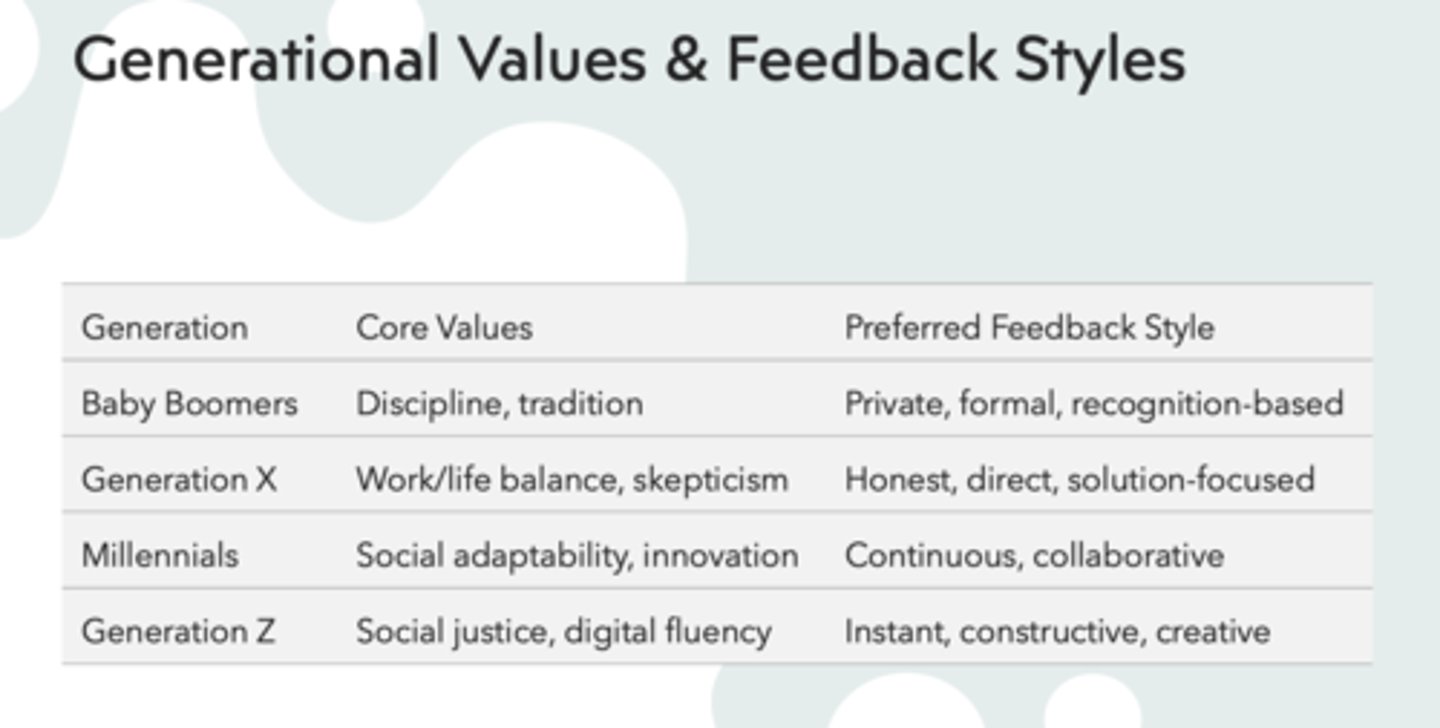
What are the core values of Gen X?
- Work/life balance
- Skepticism

What are the core values of millennials?
- Social adaptability
- Innovation
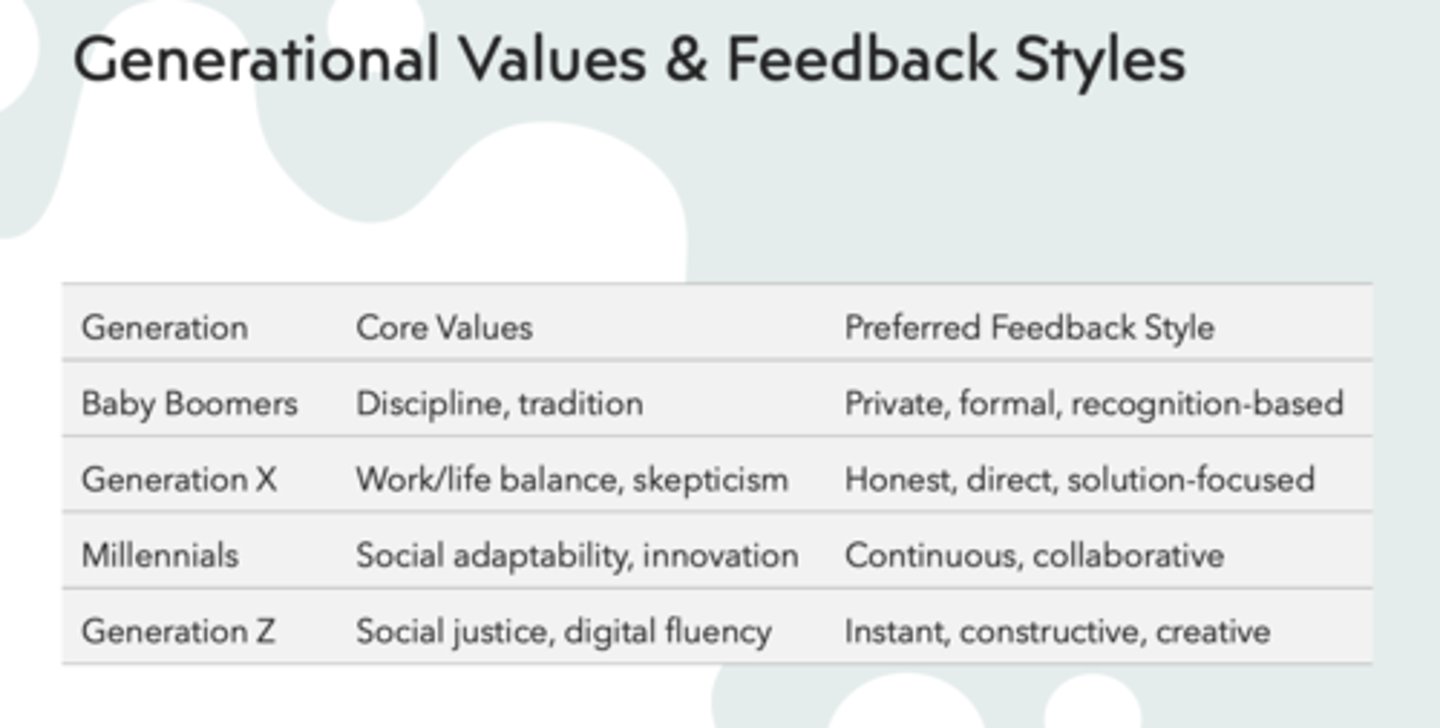
What are the core values of Gen Z?
- Social justice
- Digital fluency
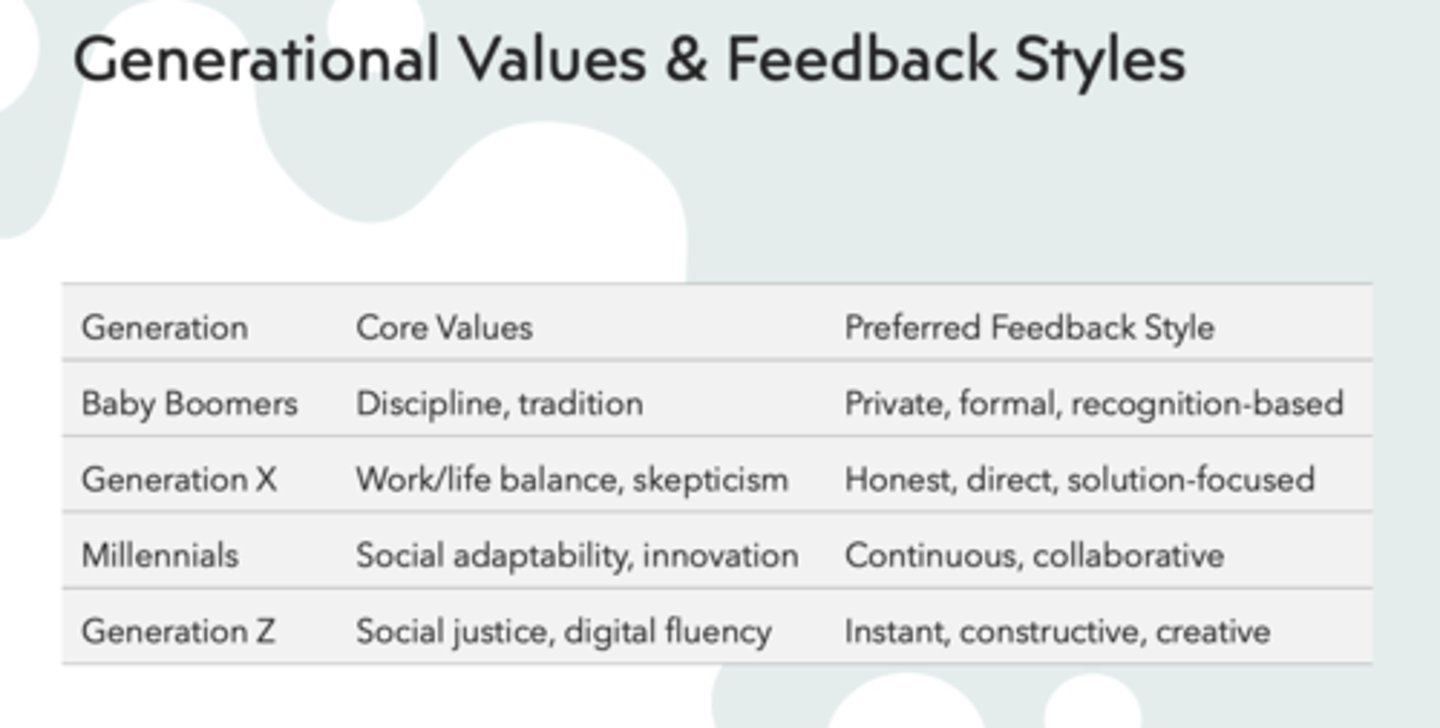
What are the preferred feedback styles for baby boomers?
- Private
- Formal
- Recognition-based
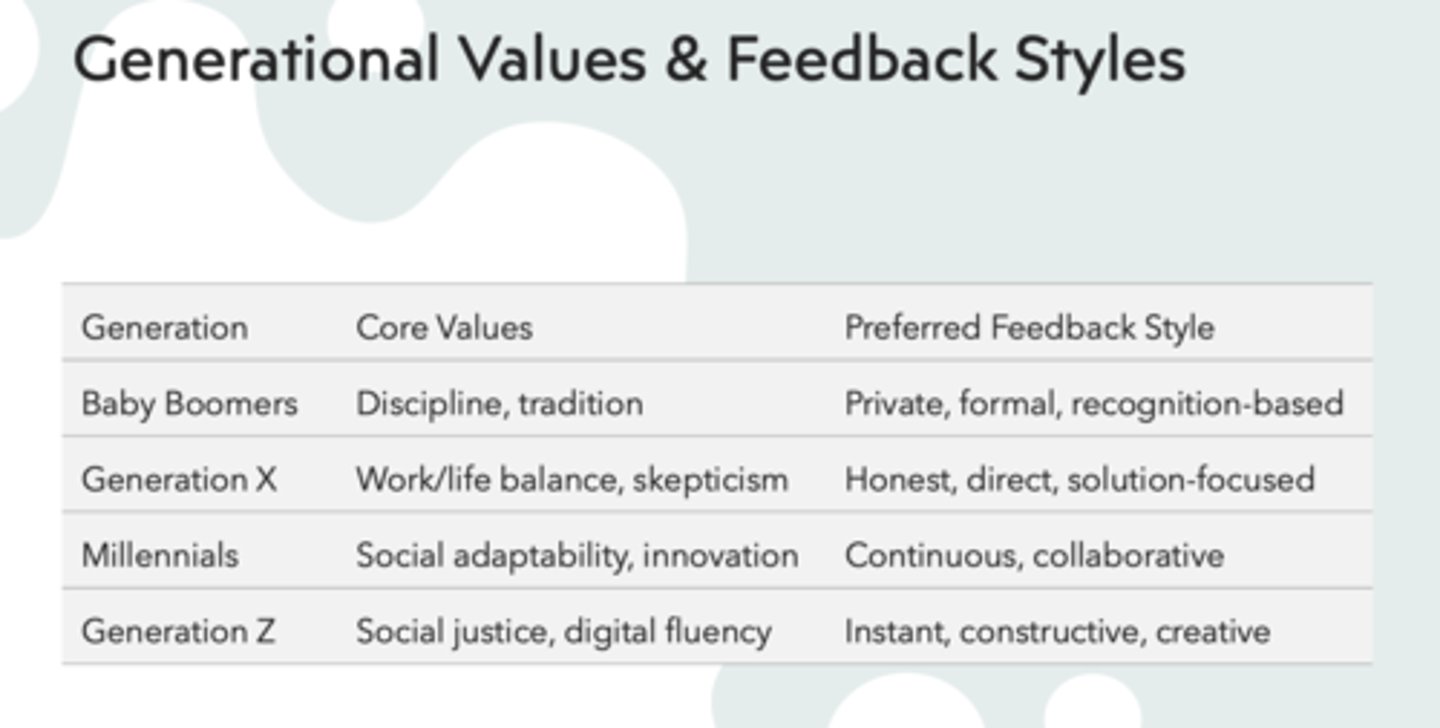
What are the preferred feedback styles for Gen X?
- Honest
- Direct
- Solution-focused

What are the preferred feedback styles for millennials?
- Continuous
- Collaborative

What are the preferred feedback styles for Gen Z?
- Instant
- Constructive
- Creative
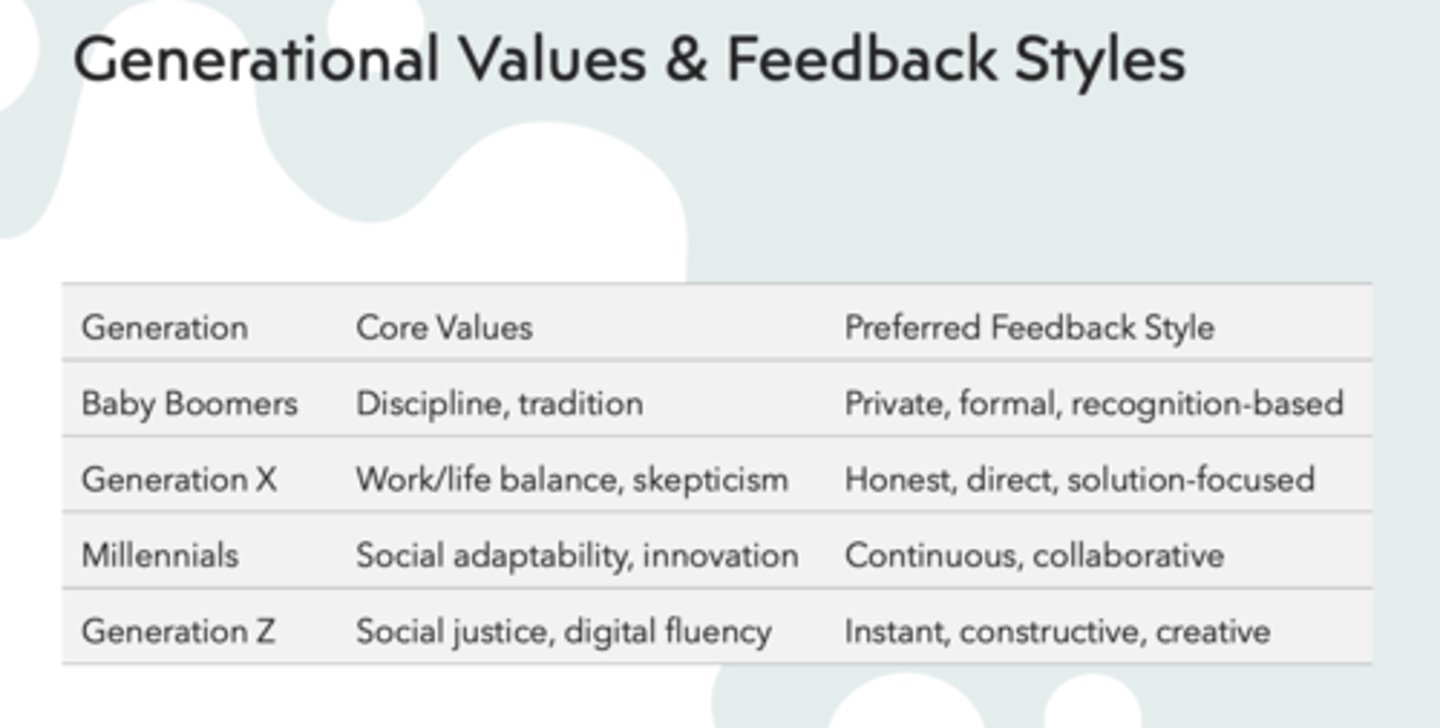
Dialogue is a two-way process that requires what three things?
- Mutual respect
- Willingness to challenge assumptions
- Creating space for differing experiences and views

All of the following are effective dialogue outcomes except:
A. Reduces miscommunication
B. Increases inclusion and empathy
C. Competitive classroom dynamics
D. Promotes psychological safety in learning environments
C. Competitive classroom dynamics
(Read A, B, and D!)
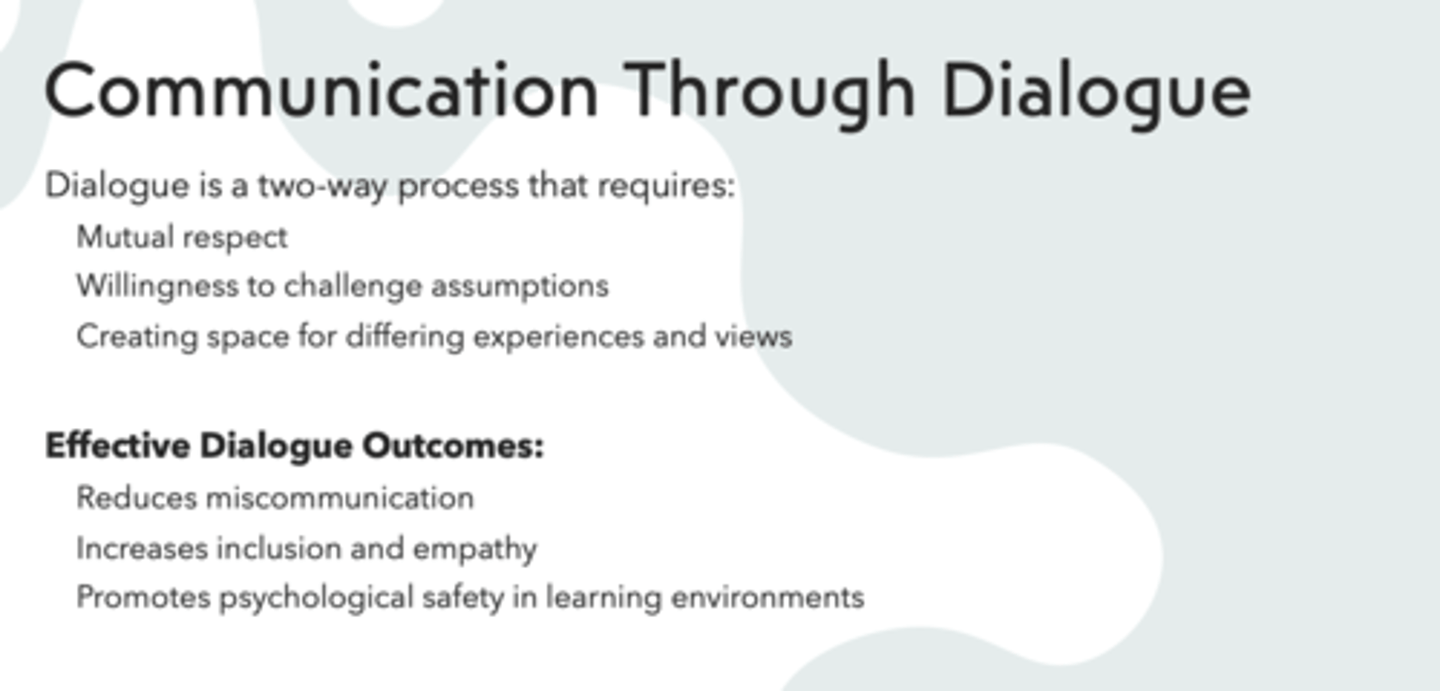
In ____________, one submits one's best thinking, knowing that other peoples' reflections will help improve it rather than destroy it
Dialogue

What has the following the following characteristics:
- Calls for temporarily suspending judgments
- Reveals assumptions and biases for reevaluation
- Causes introspection on one's own position
Dialogue
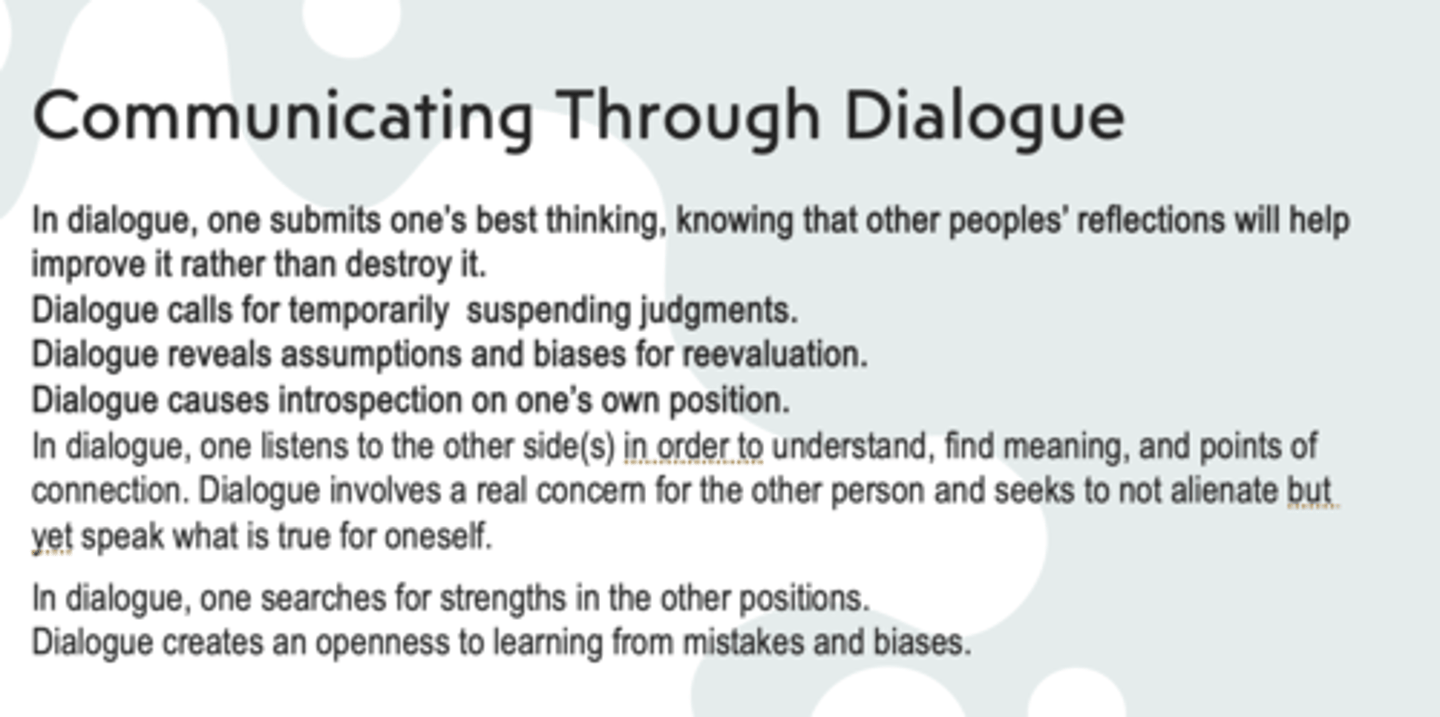
In ____________, one listens to the other side(s) in order to understand, find meaning, and points of connection. It involves a real concern for the other person and seeks to not alienate but yet speak what is true for oneself
Dialogue

In ___________, one searches for strengths in the other positions. It creates an openness to learning from mistakes and biases.
Dialogue
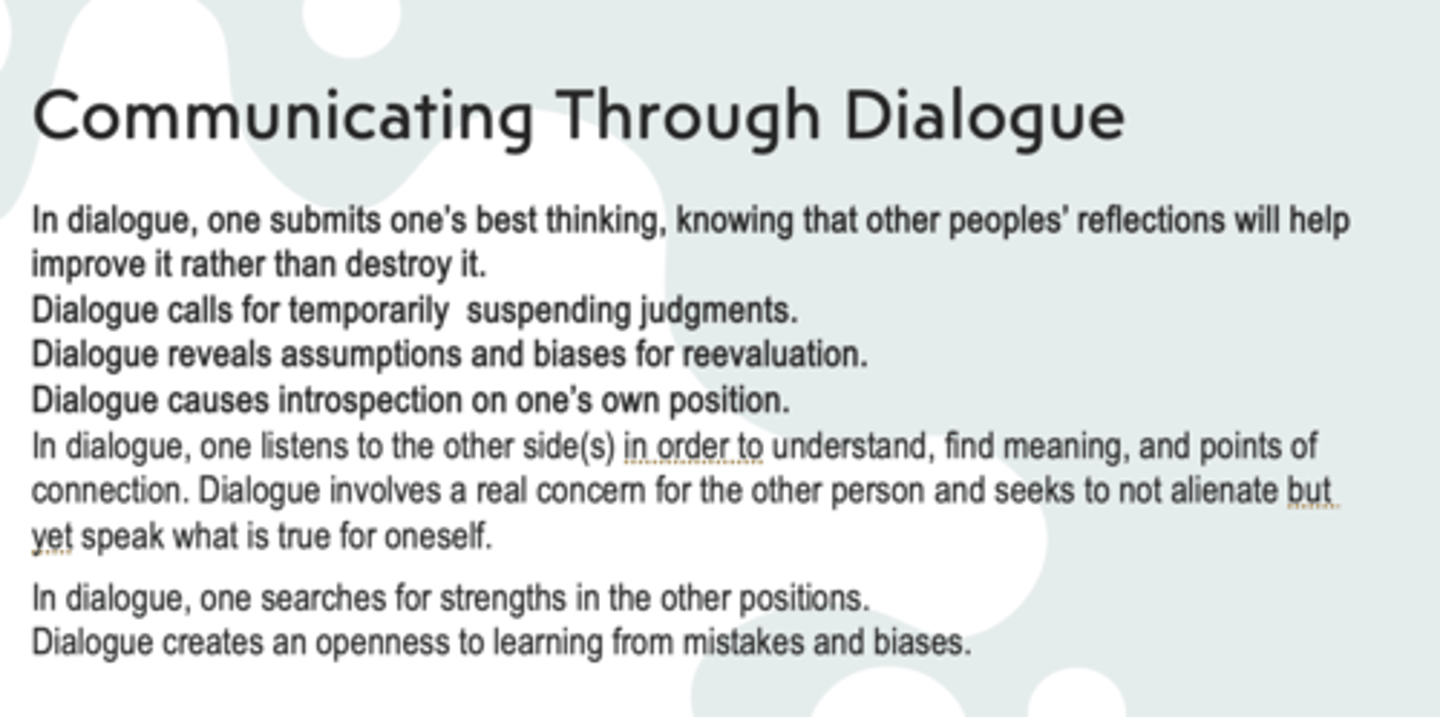
Define the following:
Fully attending to the speaker with openness, without judgment or distraction
Generous Listening
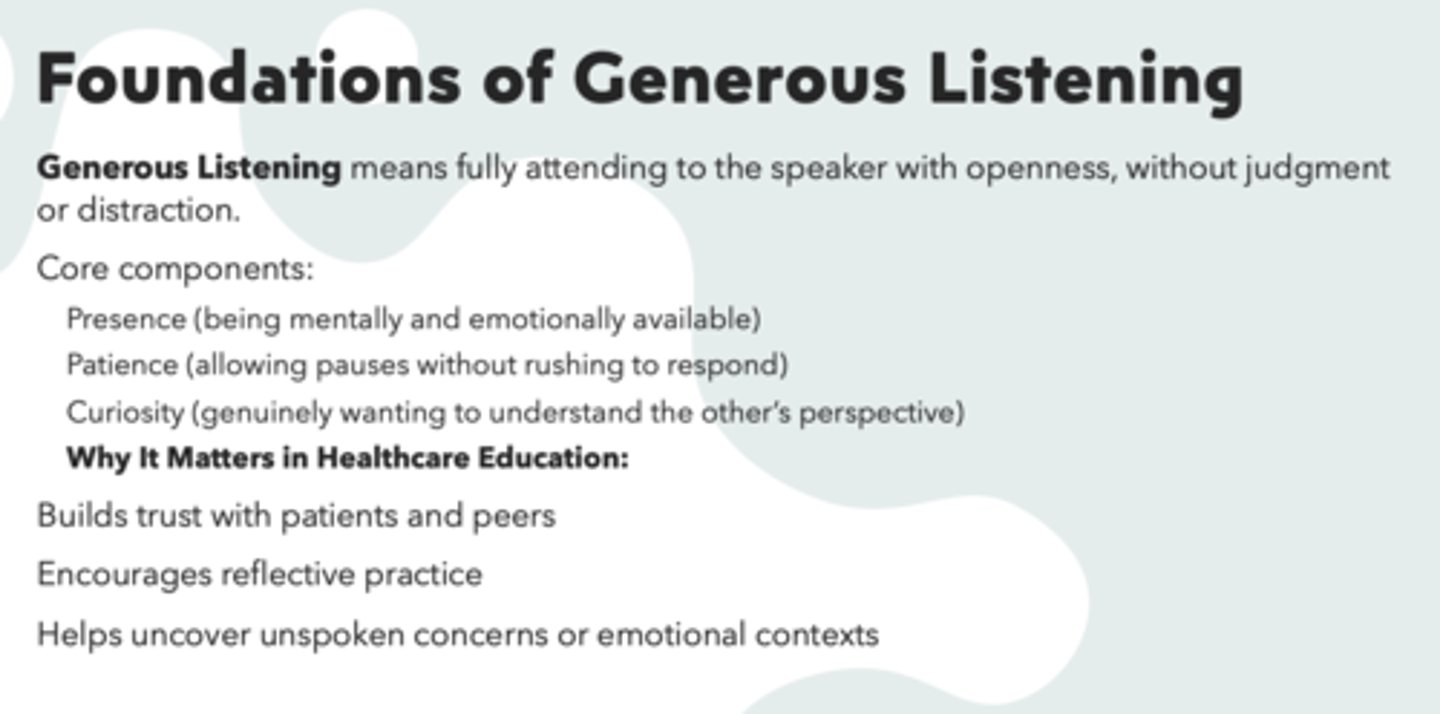
What has the following core components?
- Presence (being mentally and emotionally available)
- Patience (allowing pauses without rushing to respond)
- Curiosity (genuinely wanting to understand the other’s perspective)
Generous Listening
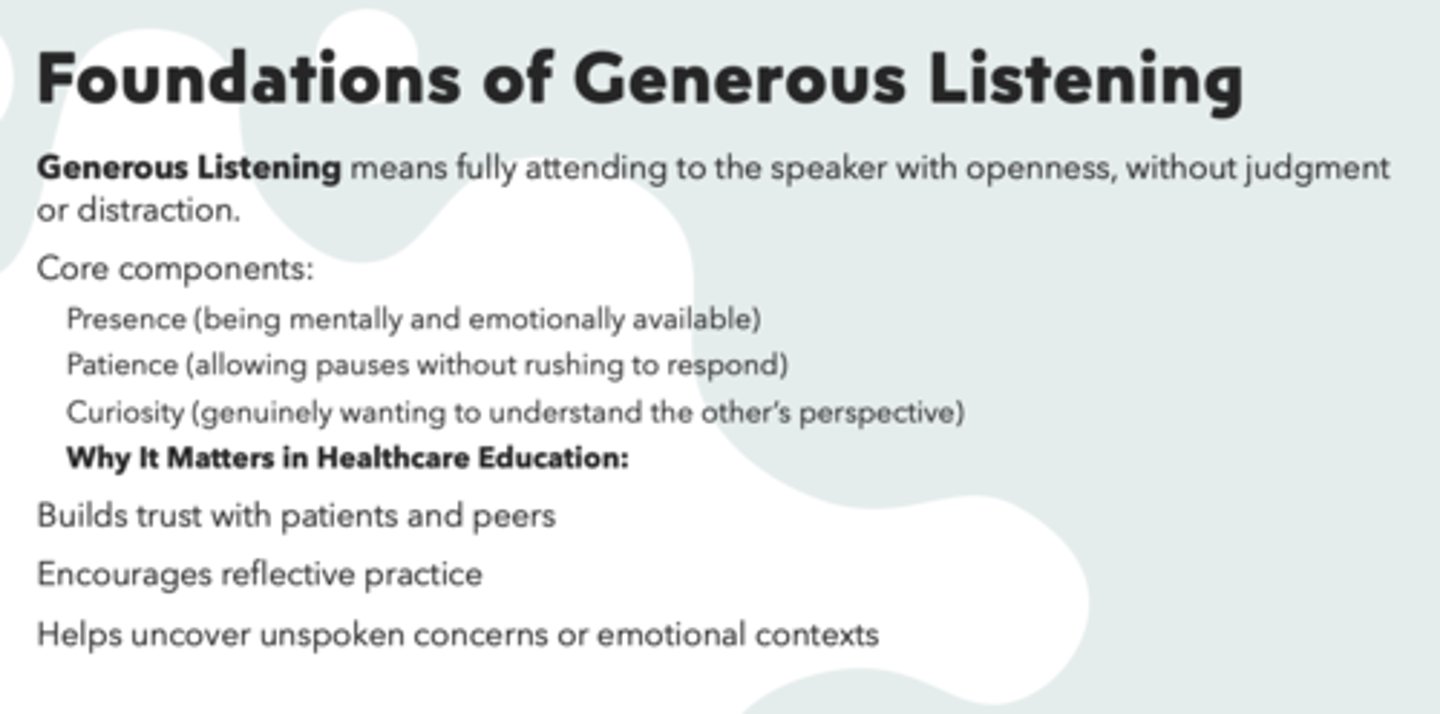
Why does generous listening matter in healthcare education?
- Builds trust with patients and peers
- Encourages reflective practice
- Helps uncover unspoken concerns or emotional contexts

What are three truths of human development?
1. Each person is like every other person
2. Each person is like some other people
3. Each person is like no other person
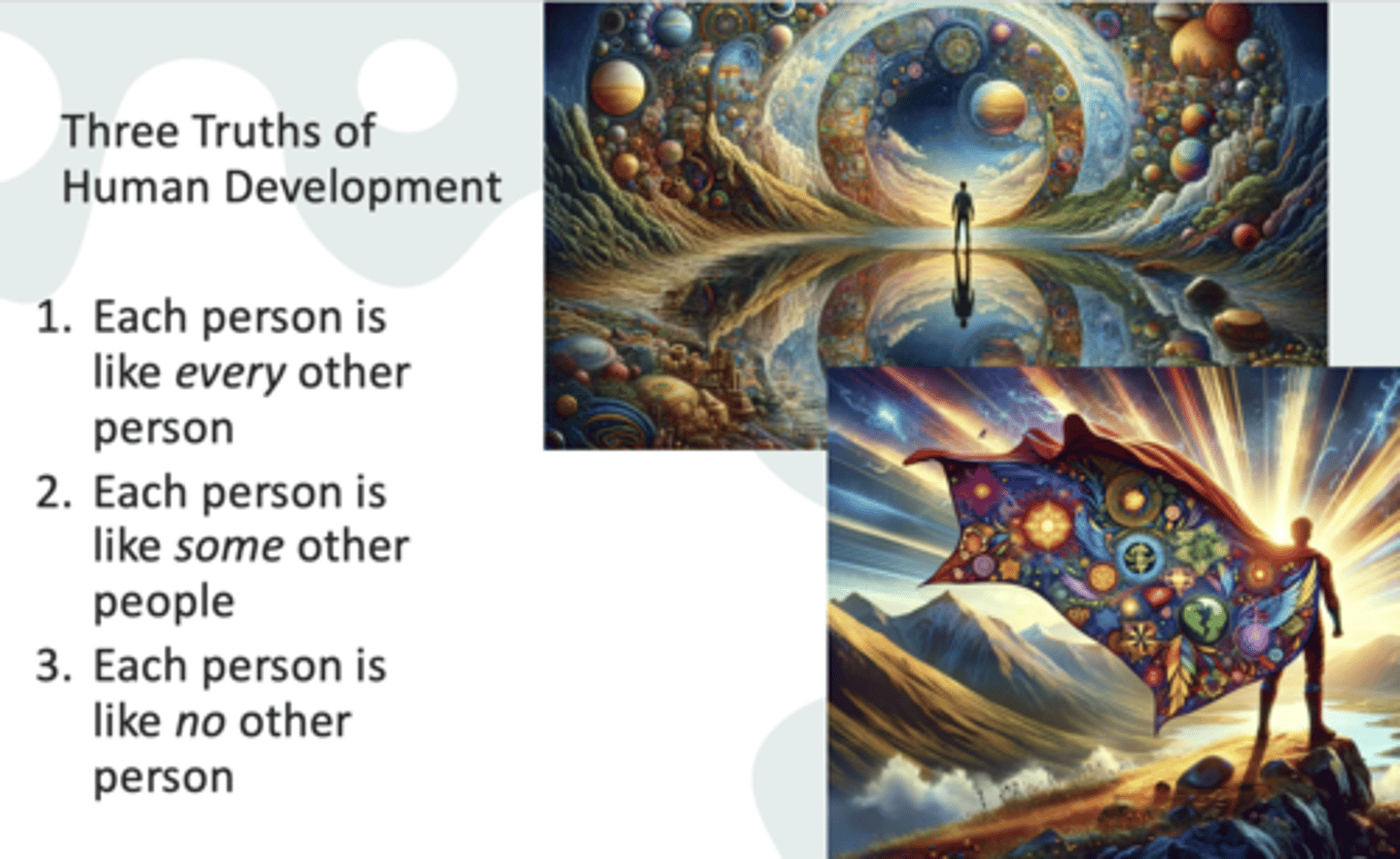
What population is the following:
Over 62 million individuals (~19% of U.S. population)
Hispanic/Latino Americans
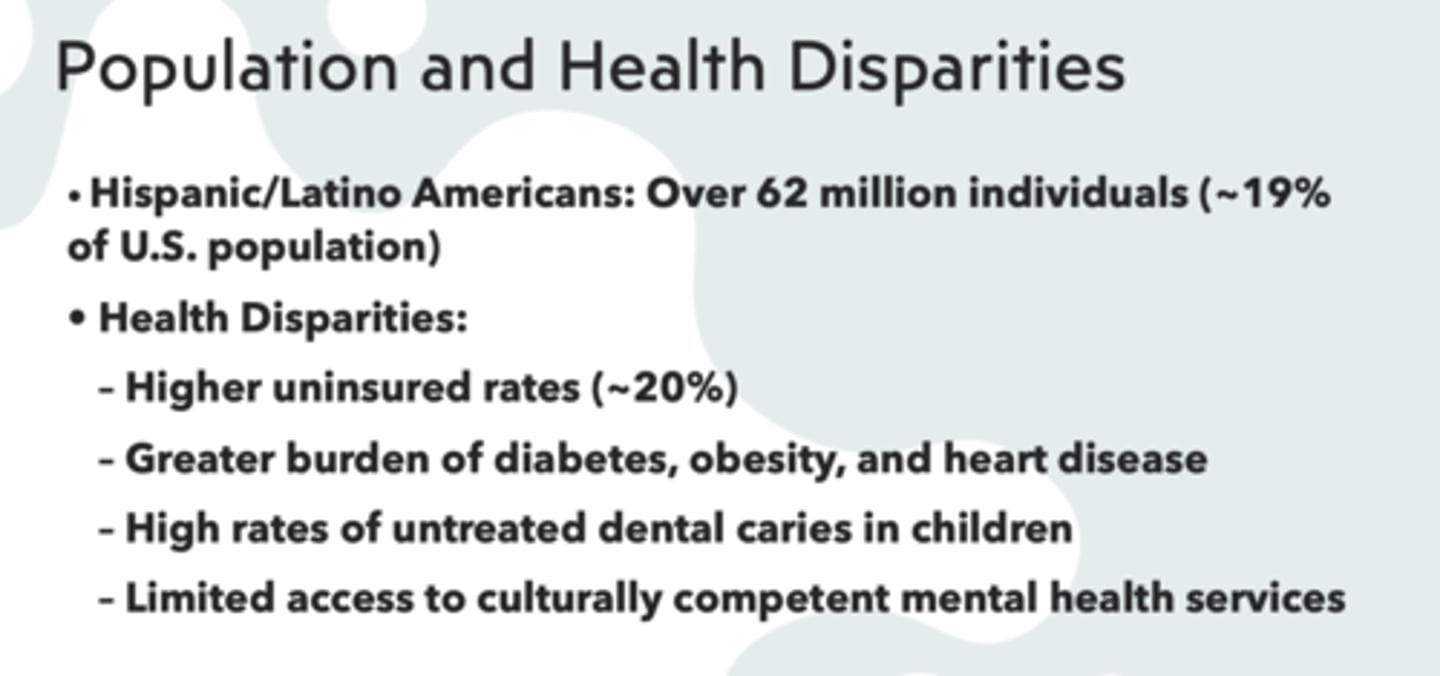
What population has the following health disparities?
- Higher uninsured rates (~20%)
- Greater burden of diabetes, obesity, and heart disease
- High rates of untreated dental caries in children
- Limited access to culturally competent mental health services
Hispanic/Latino Americans

What are four solutions for advancing health equity for Hispanic/Latino communities?
- Increase Hispanic/Latino representation in healthcare workforce
- Expand cultural competence training and bilingual services
- Engage community health workers as cultural liaisons
- Promote policy changes to improve access for low-income and immigrant populations
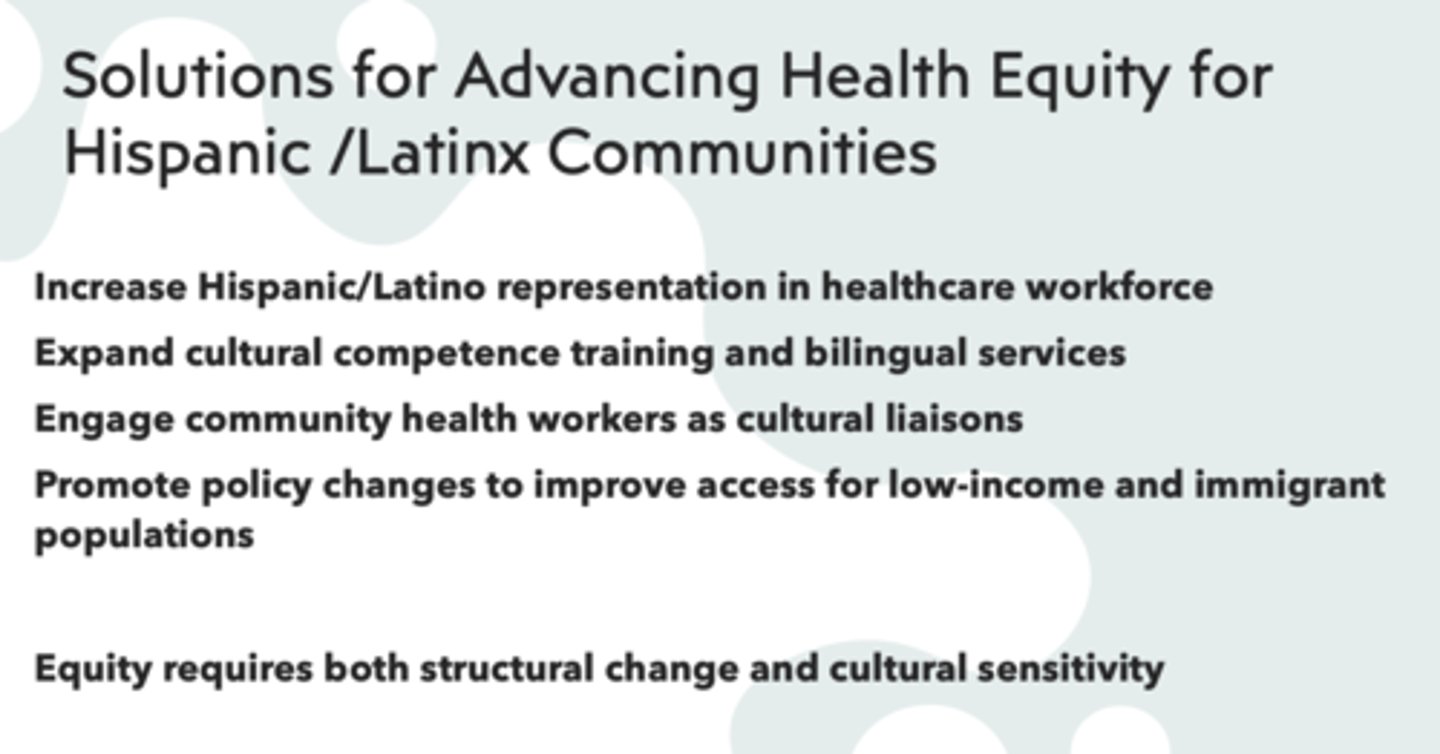
__________ requires both structural change and cultural sensitivity
Equity
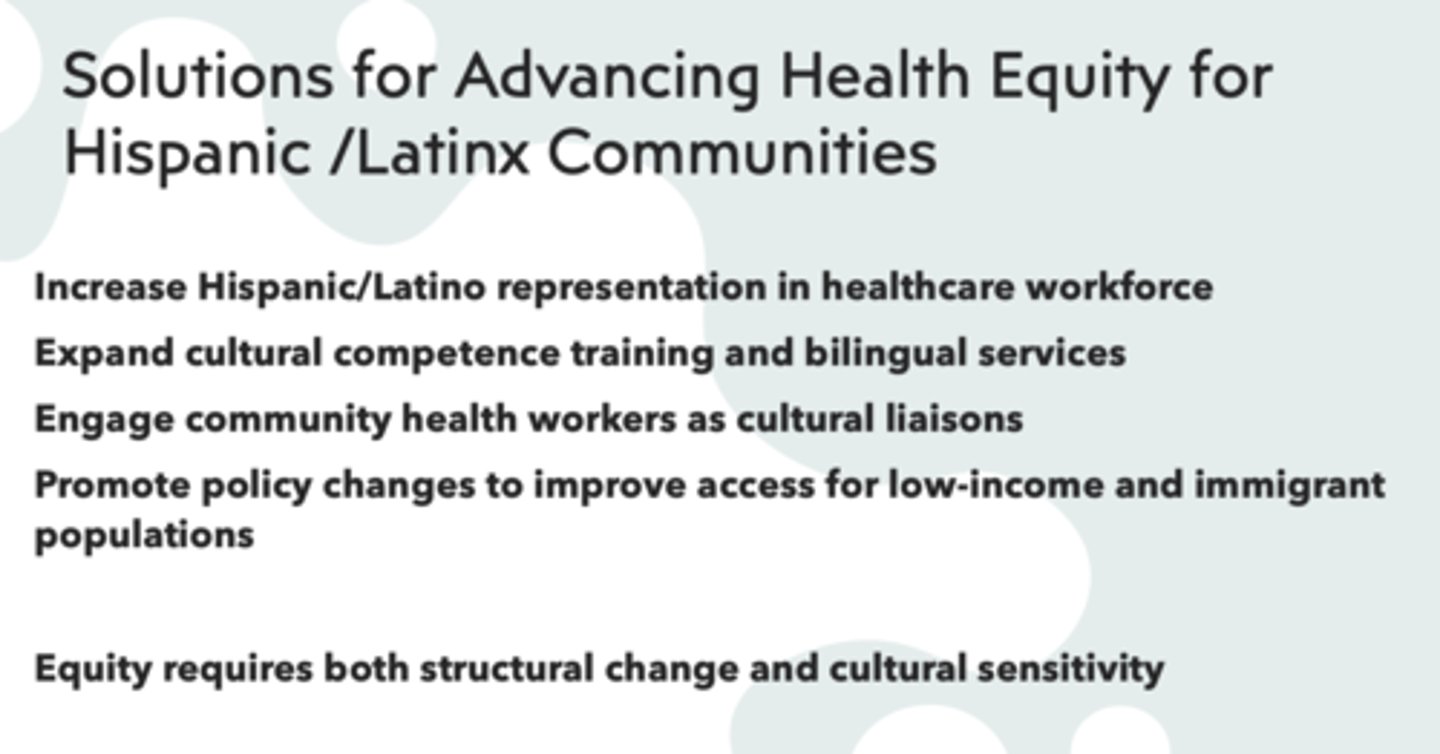
What are five barriers to healthcare access in Hispanic communities?
- Language barriers and limited English proficiency
- Financial limitations and low insurance coverage
- Immigration-related fear (e.g., deportation concerns)
- Cultural differences and mistrust in healthcare systems
- Impact: Leads to delayed care, poor communication, and worse outcomes

What was the approximate IHS dentist vacancy rate in 2021?
30%
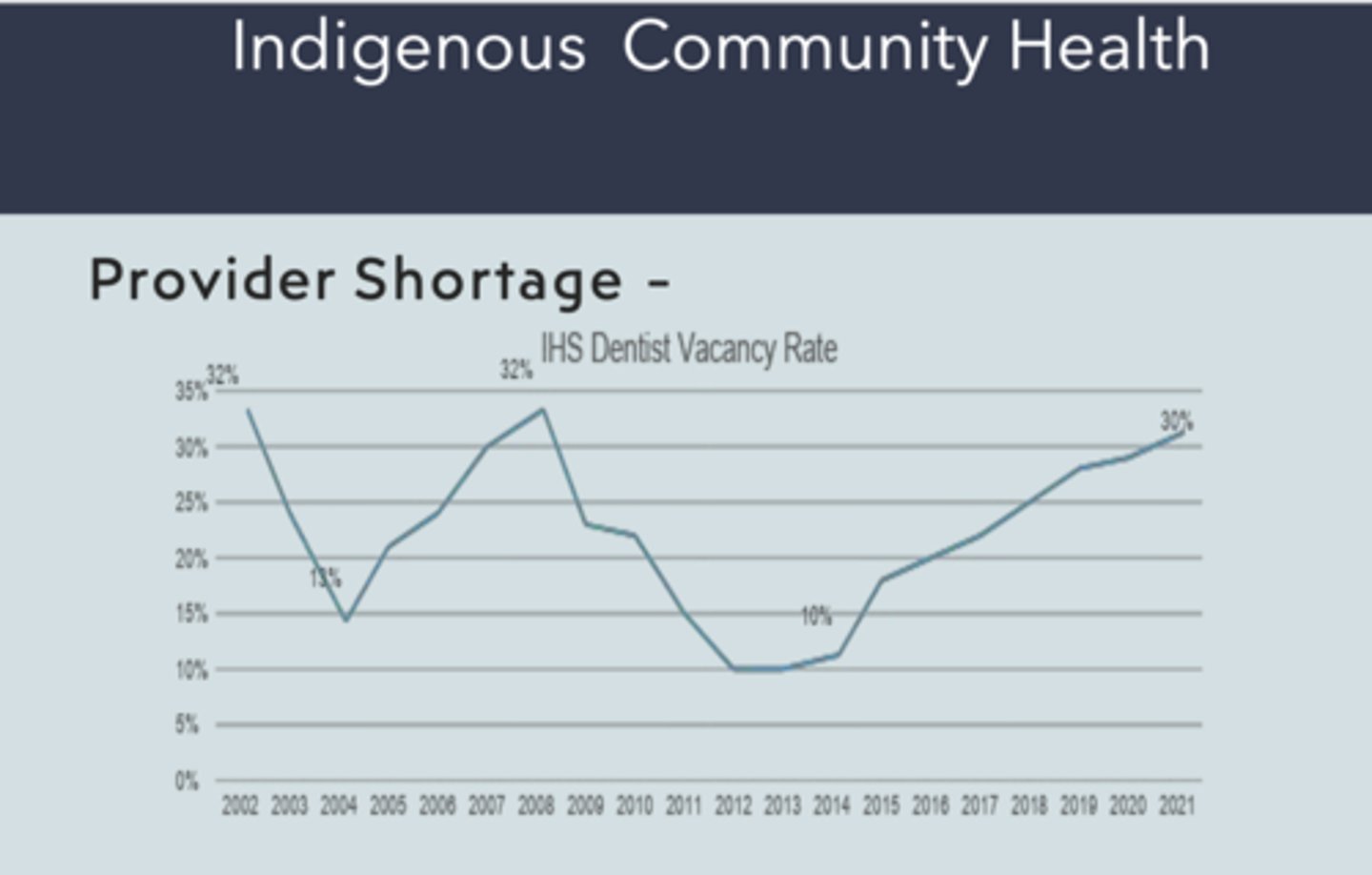
In which year did the IHS dentist vacancy rate reach its lowest point on the chart?
2012
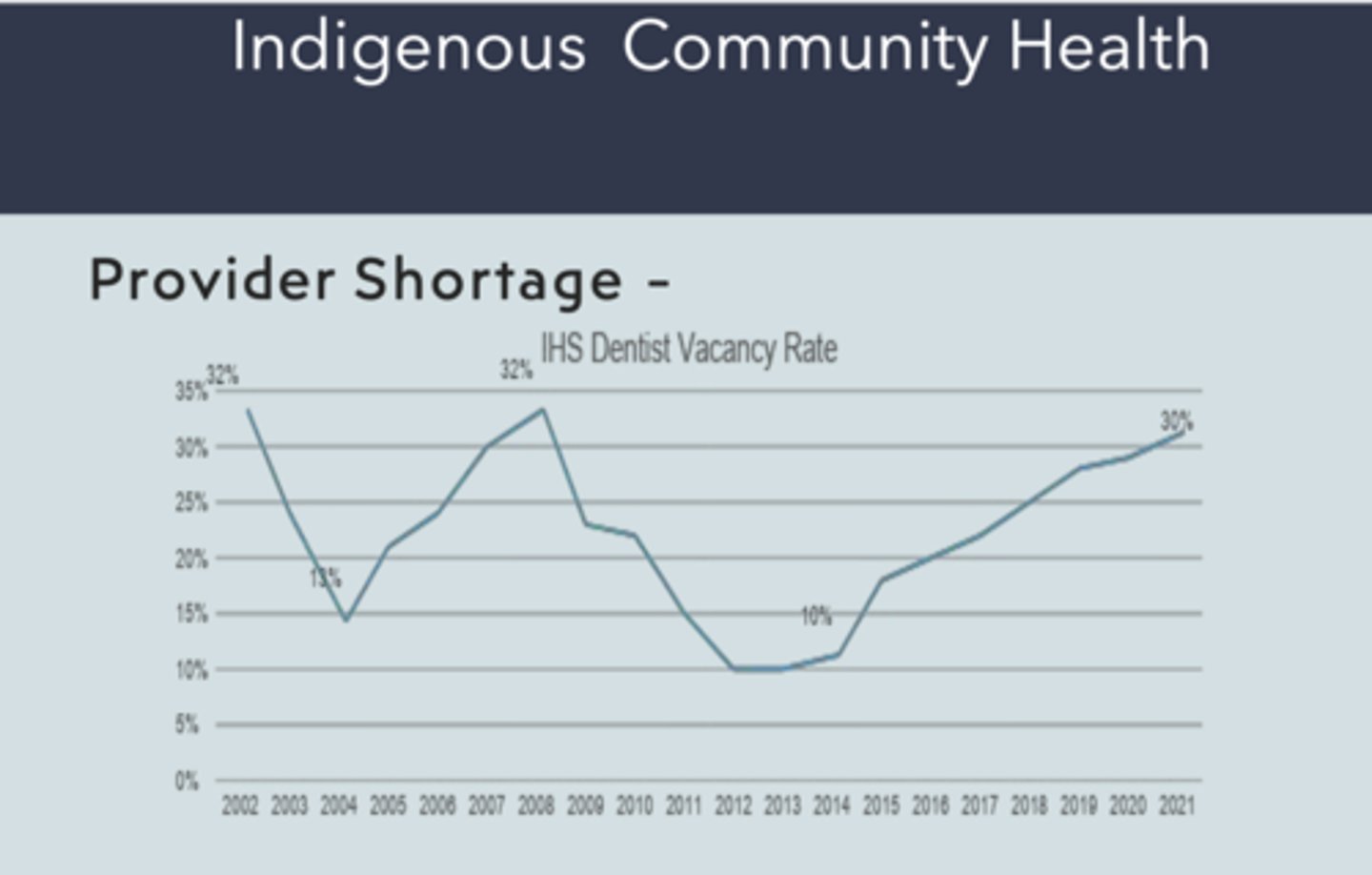
What is the overall trend in the IHS dentist vacancy rate from 2002 to 2021?
The vacancy rate showed a fluctuating pattern but ultimately increased by 2021
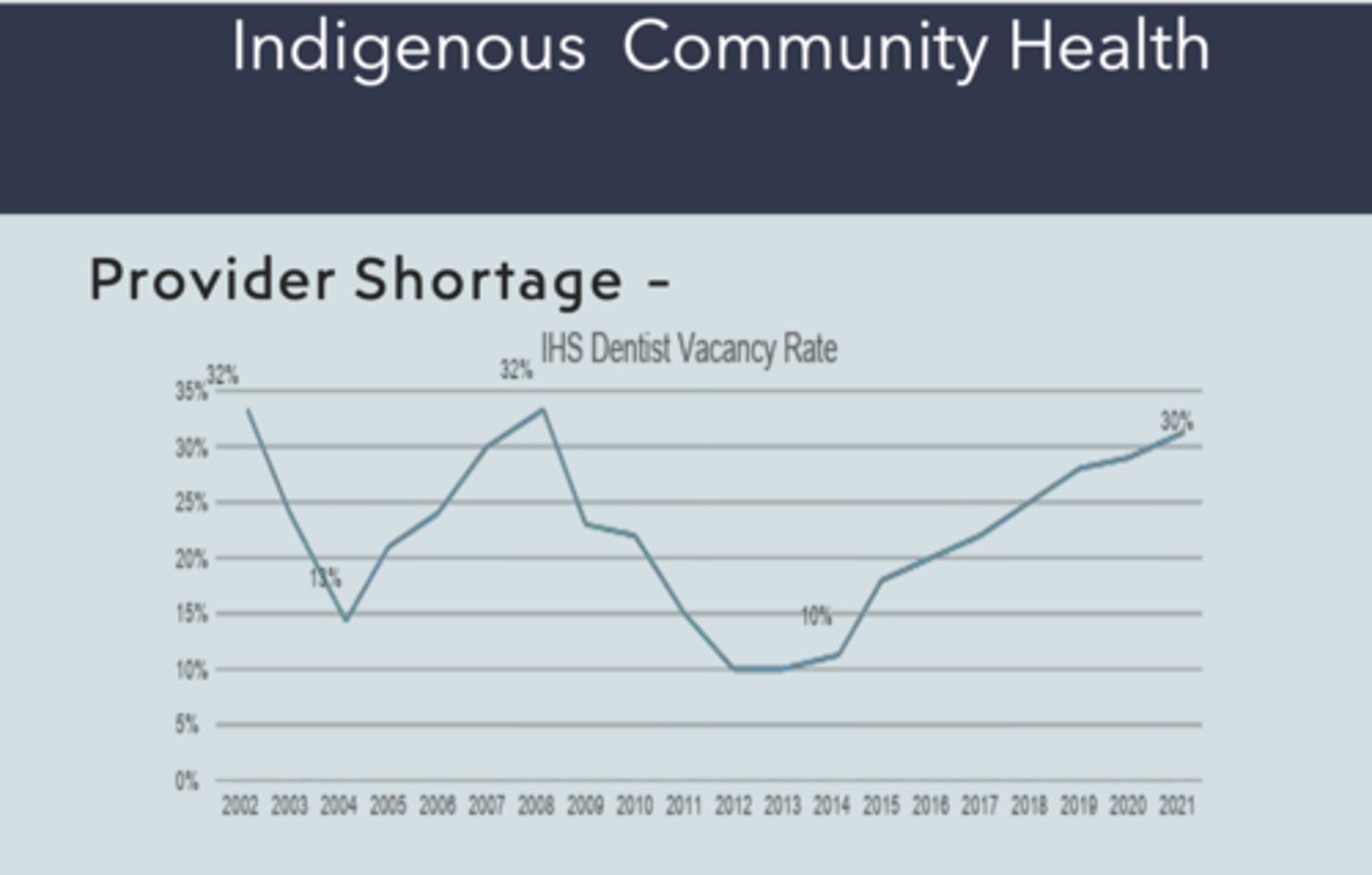
How much more likely were AI/AN individuals to visit the emergency department (ED) for dental care or mouth pain compared to non-AI/AN adults?
Three and a half times as likely
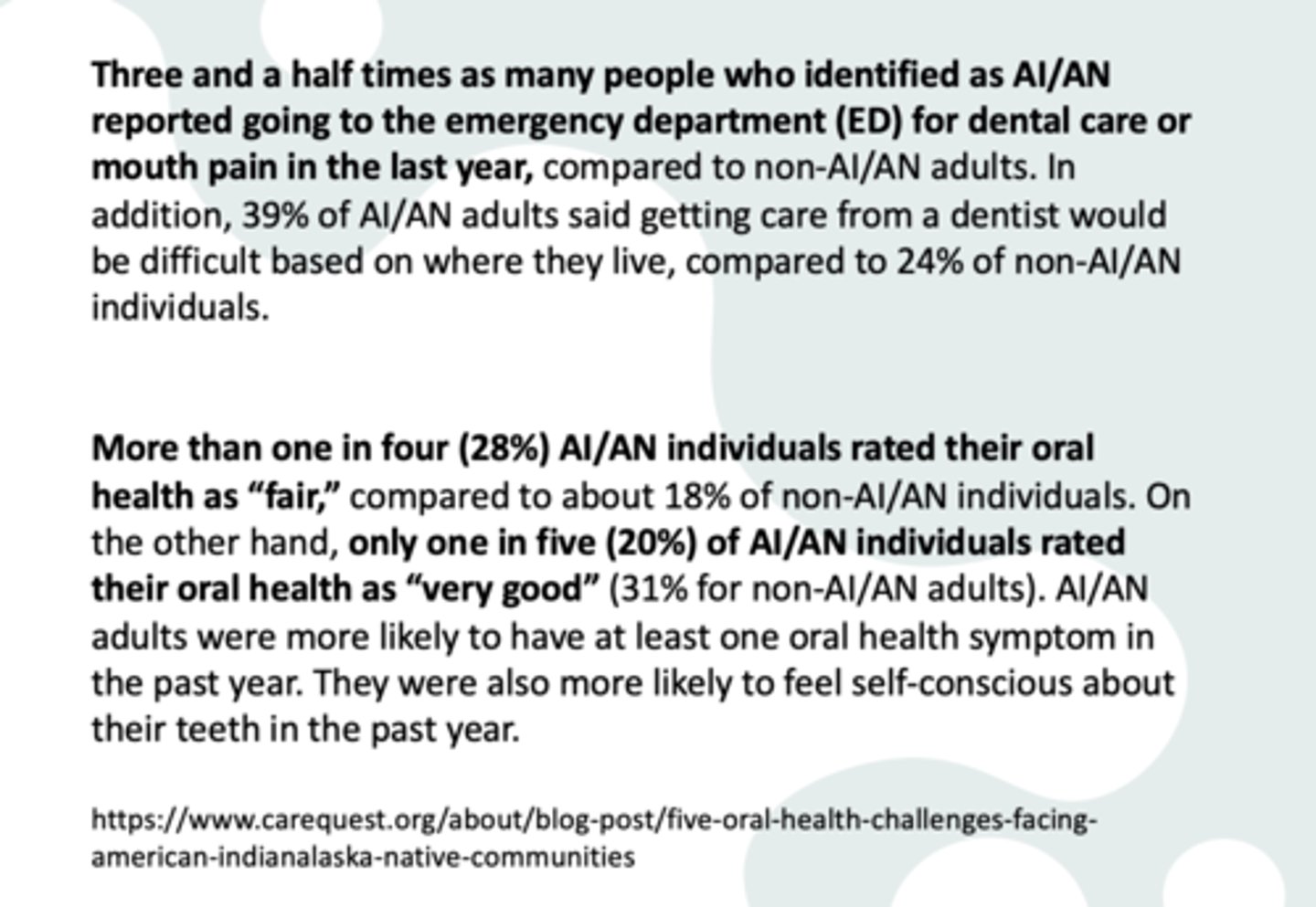
What percentage of AI/AN adults reported difficulty accessing dental care based on where they live?
39%
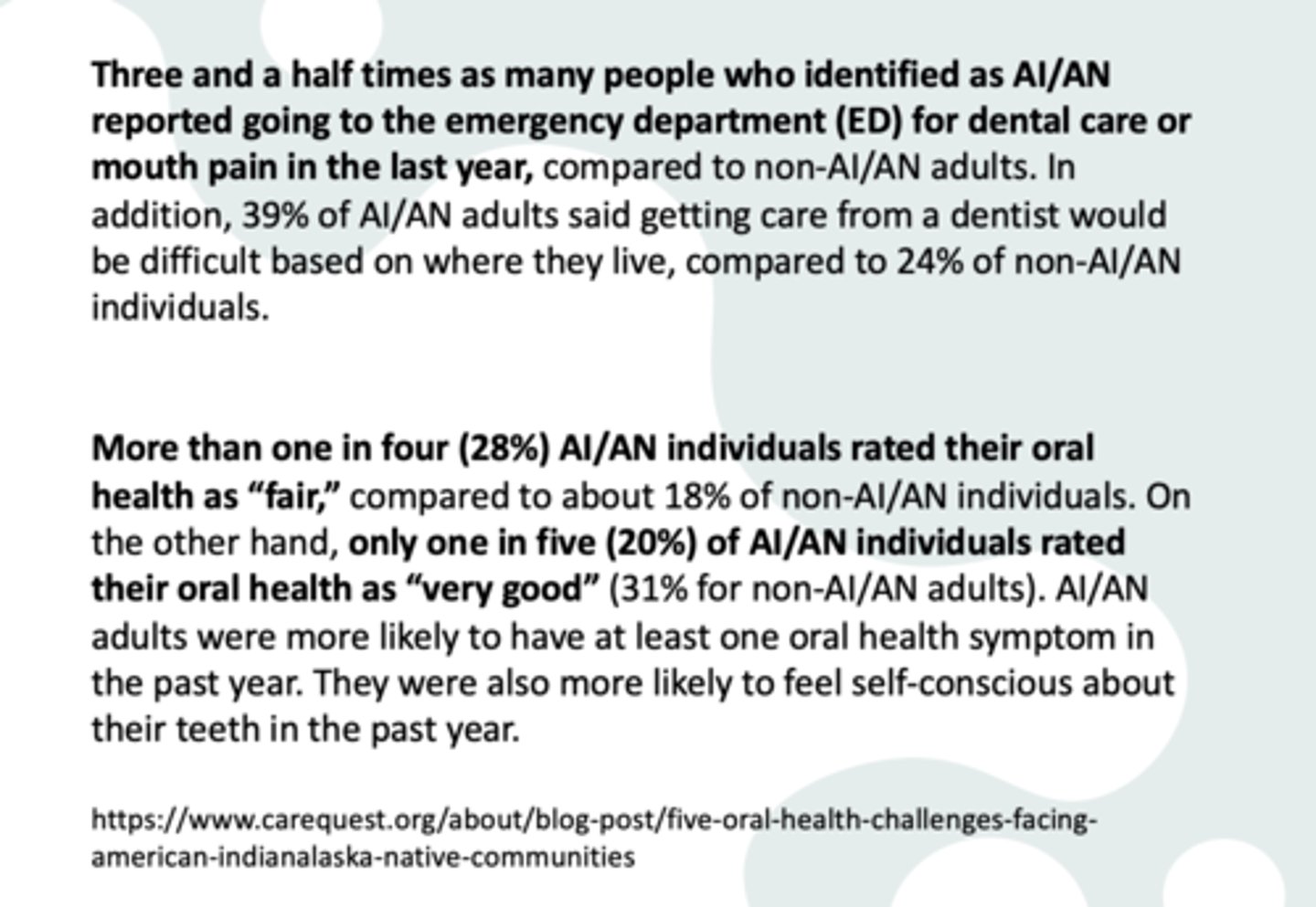
What percentage of non-AI/AN adults reported difficulty accessing dental care based on where they live?
24%
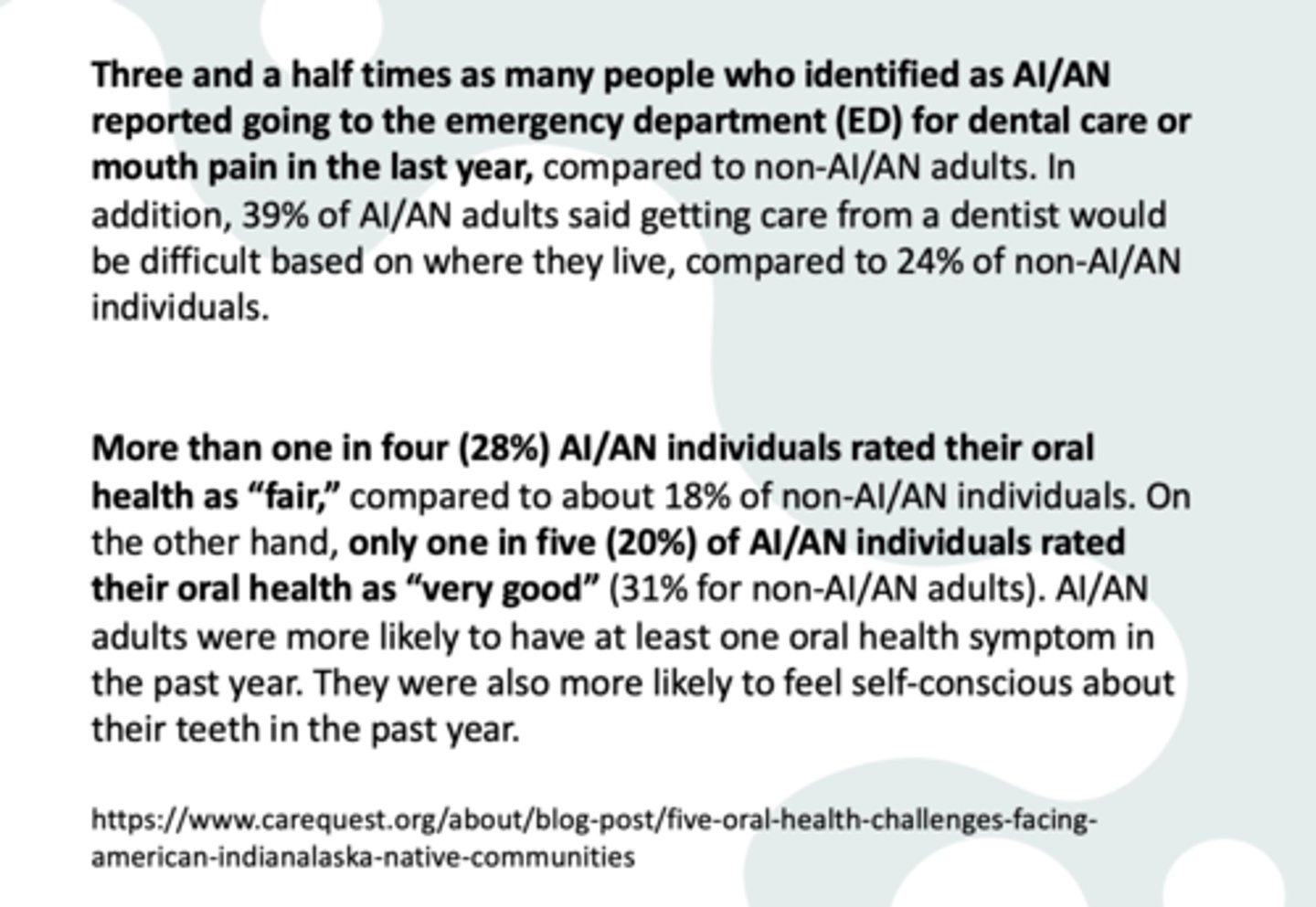
What proportion of AI/AN individuals rated their oral health as "fair"?
28%

What proportion of non-AI/AN individuals rated their oral health as "fair"?
18%
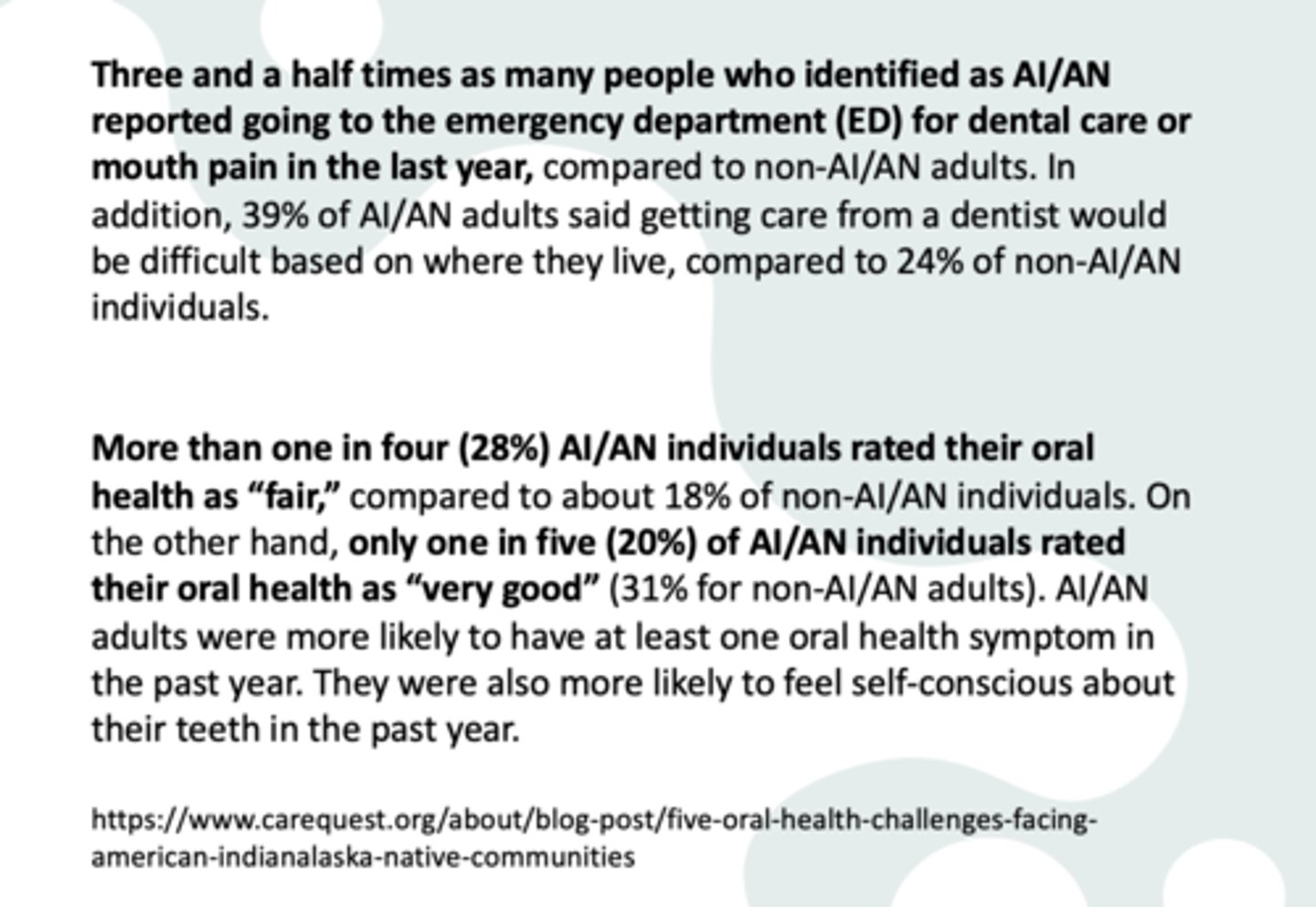
Which of the following best describes the difference in perception of "very good" oral health between AI/AN and non-AI/AN individuals?
A. AI/AN: 31%, Non-AI/AN: 20%
B. AI/AN: 20%, Non-AI/AN: 31%
C. AI/AN: 18%, Non-AI/AN: 28%
D. AI/AN: 39%, Non-AI/AN: 24%
B. AI/AN: 20%, Non-AI/AN: 31%
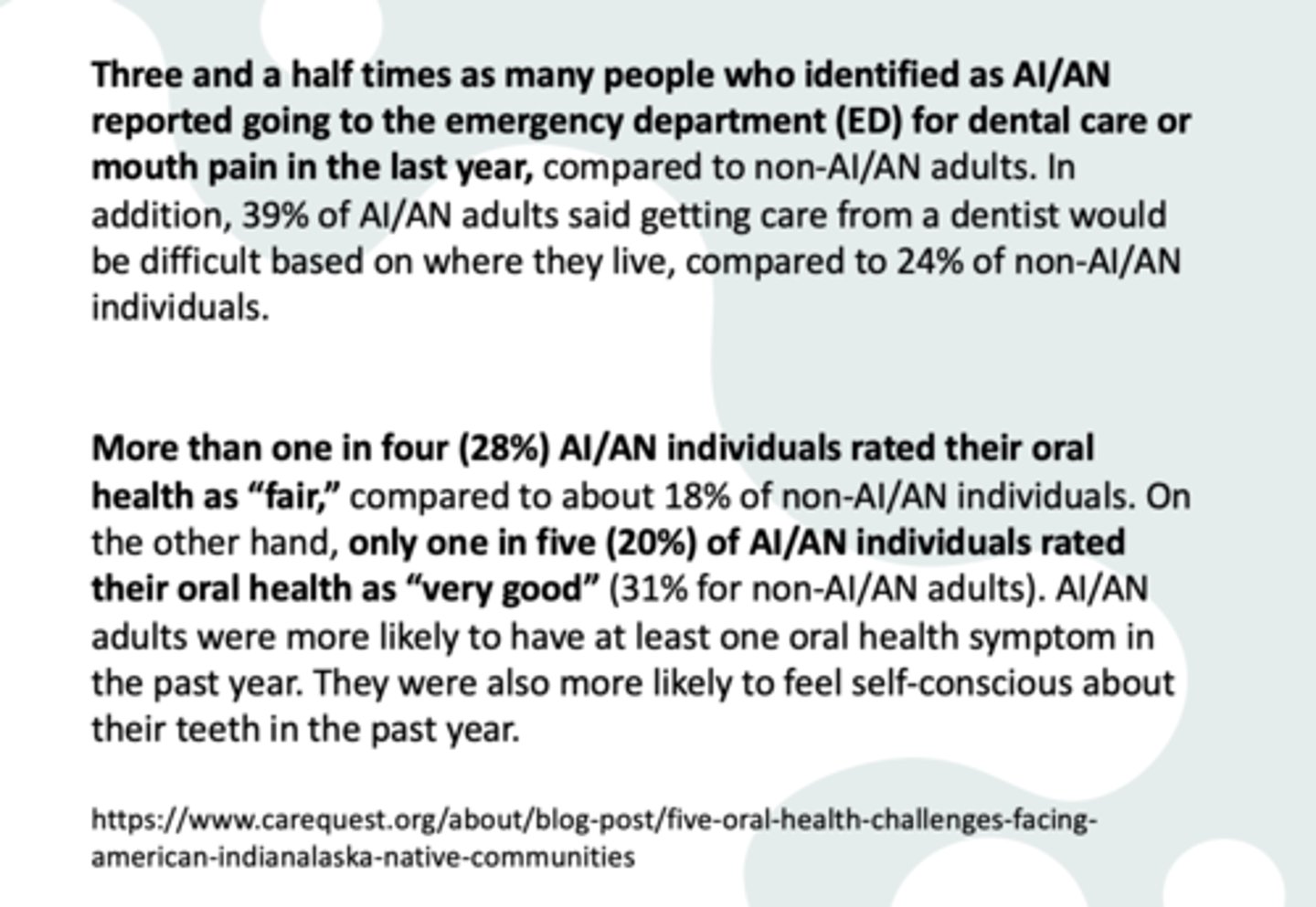
T/F: AI/AN adults were more likely to have at least one oral health symptom in the past year. They were also more likely to feel self-conscious about their teeth in the past year.
True

Which population had the highest rate of early childhood caries?
A. NH White
B. NH Black
C. Mexican American
D. AI/AN
D. AI/AN

How can you, or your organization be supportive of Indigenous Communities through policy and advocacy?
Support legislation that supports Indigenous communities and access to oral health care
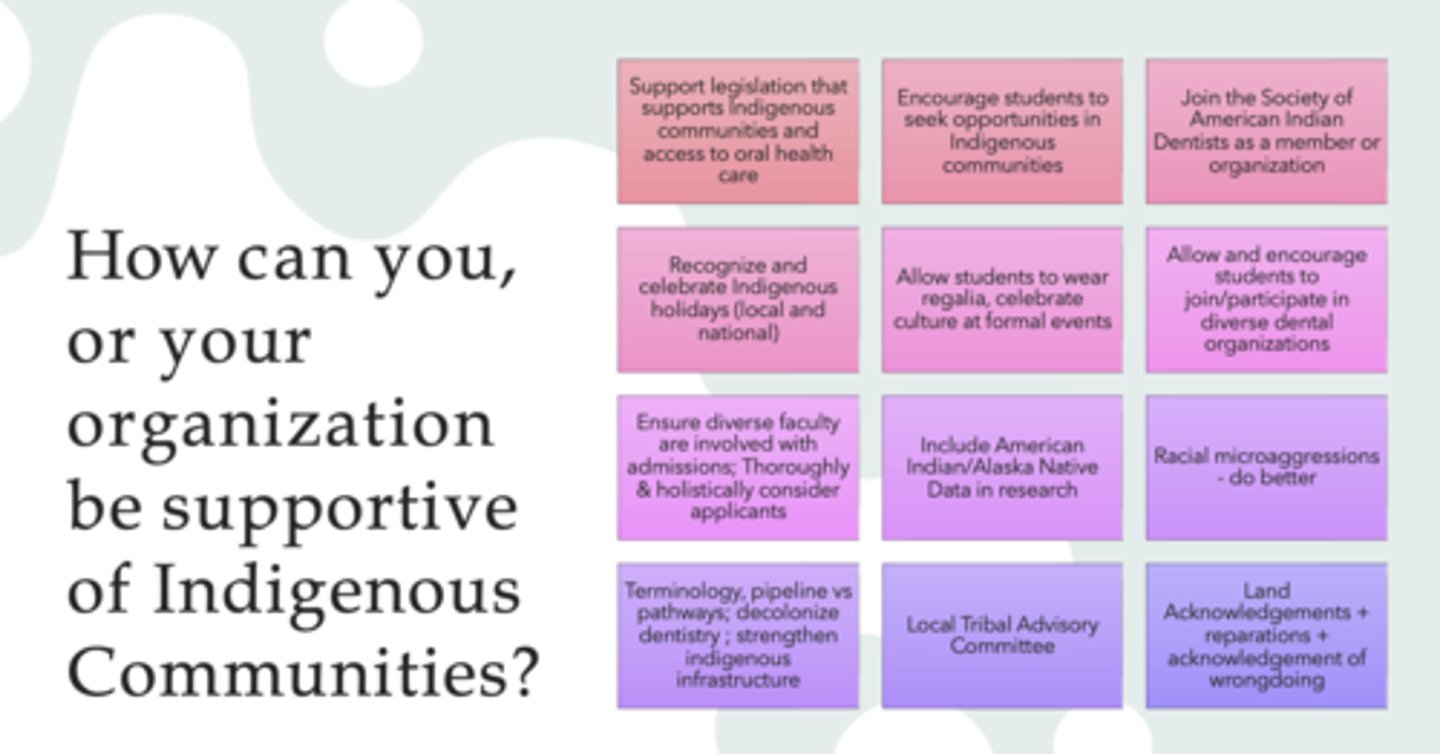
What are effective ways educational institutions can better support Indigenous representation?
Ensure diverse faculty are involved with admissions; Thoroughly & holistically consider applicants
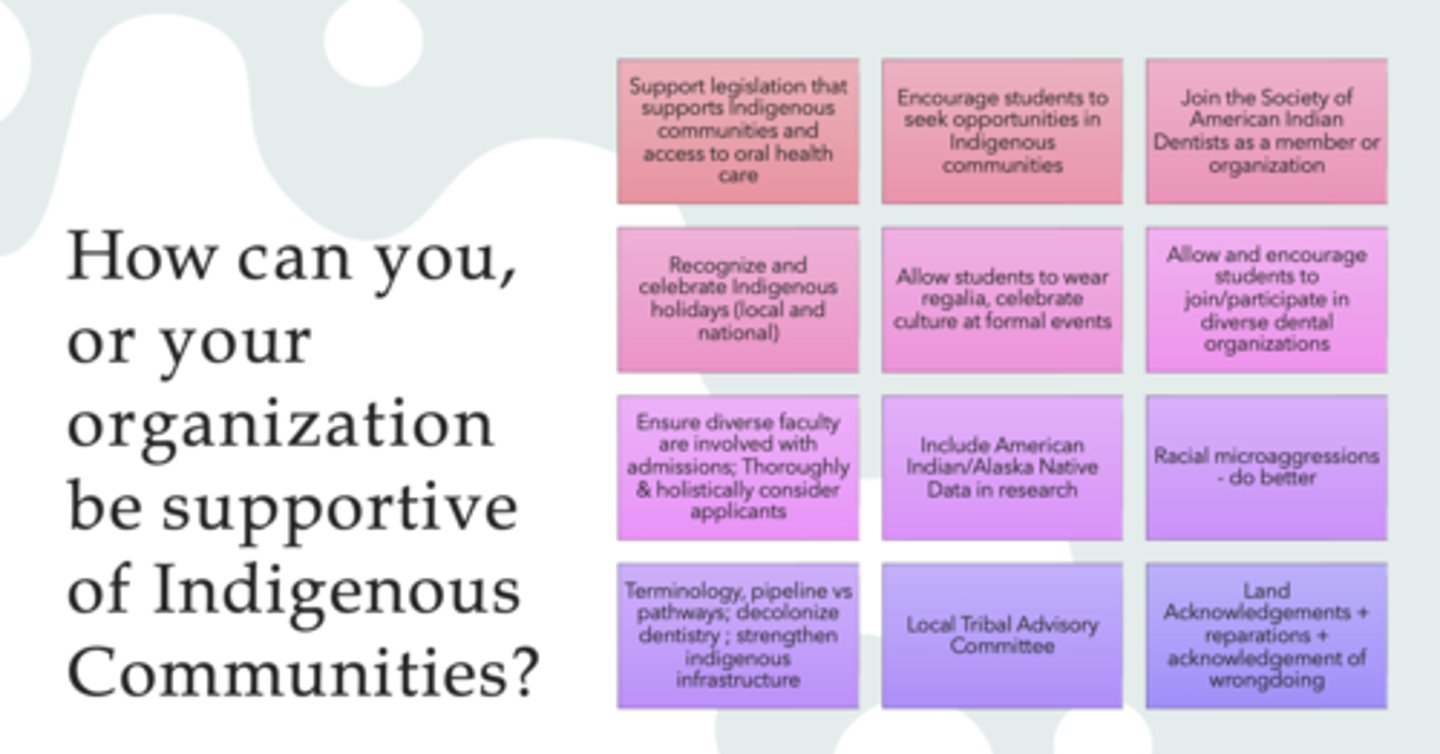
How can students and professionals be encouraged to engage with Indigenous communities?
Encourage students to seek opportunities in Indigenous communities
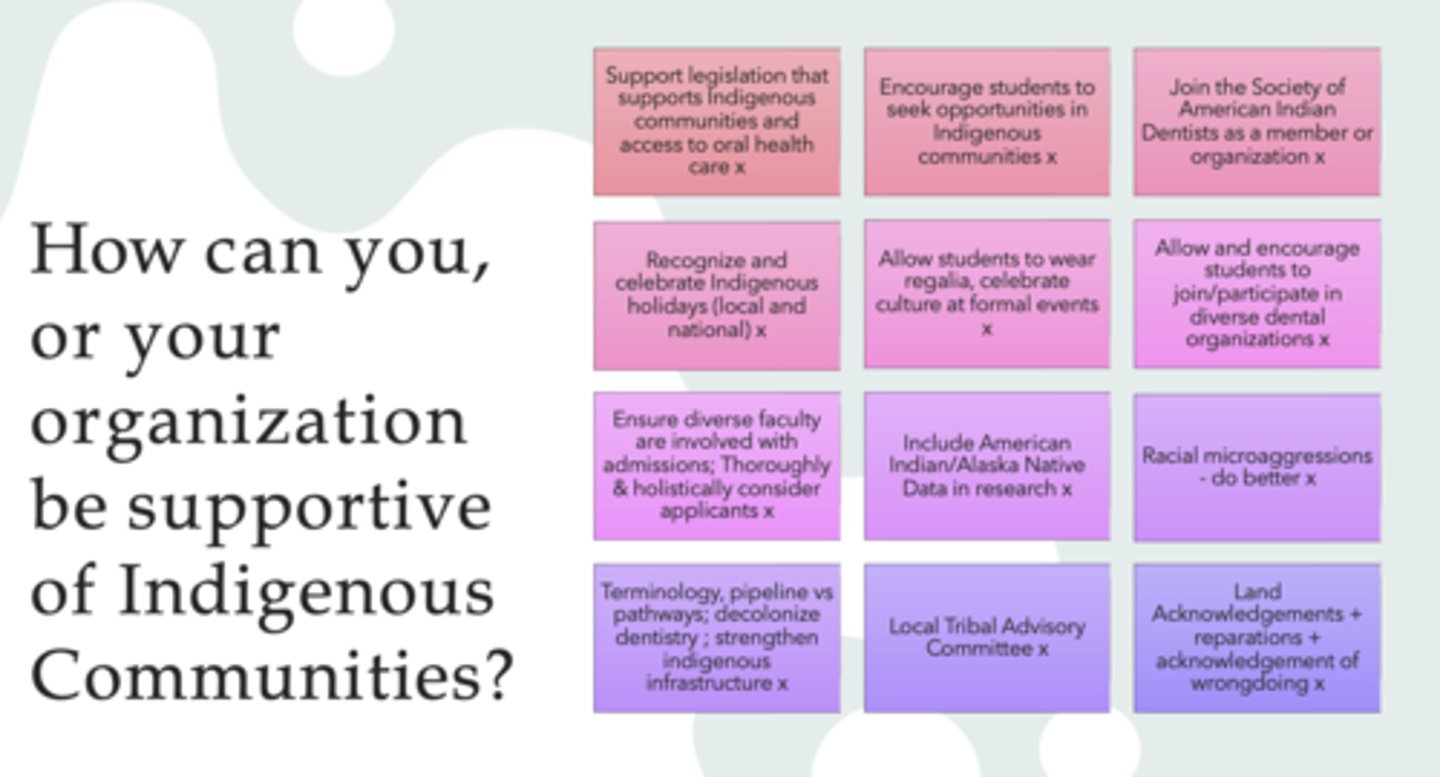
Which of the following practices promote respect for Indigenous culture in educational settings?
A. Maintain a uniform dress code and formal decorum only
B. Recognize Indigenous holidays and allow cultural regalia at formal events
C. Exclude cultural considerations from official events
D. Limit Indigenous celebrations to off-campus activities
B. Recognize Indigenous holidays and allow cultural regalia at formal events

What are meaningful ways institutions can incorporate Indigenous voices into research and decision-making?
Include American Indian/Alaska Native data in research and collaborate with Local Tribal Advisory Committees
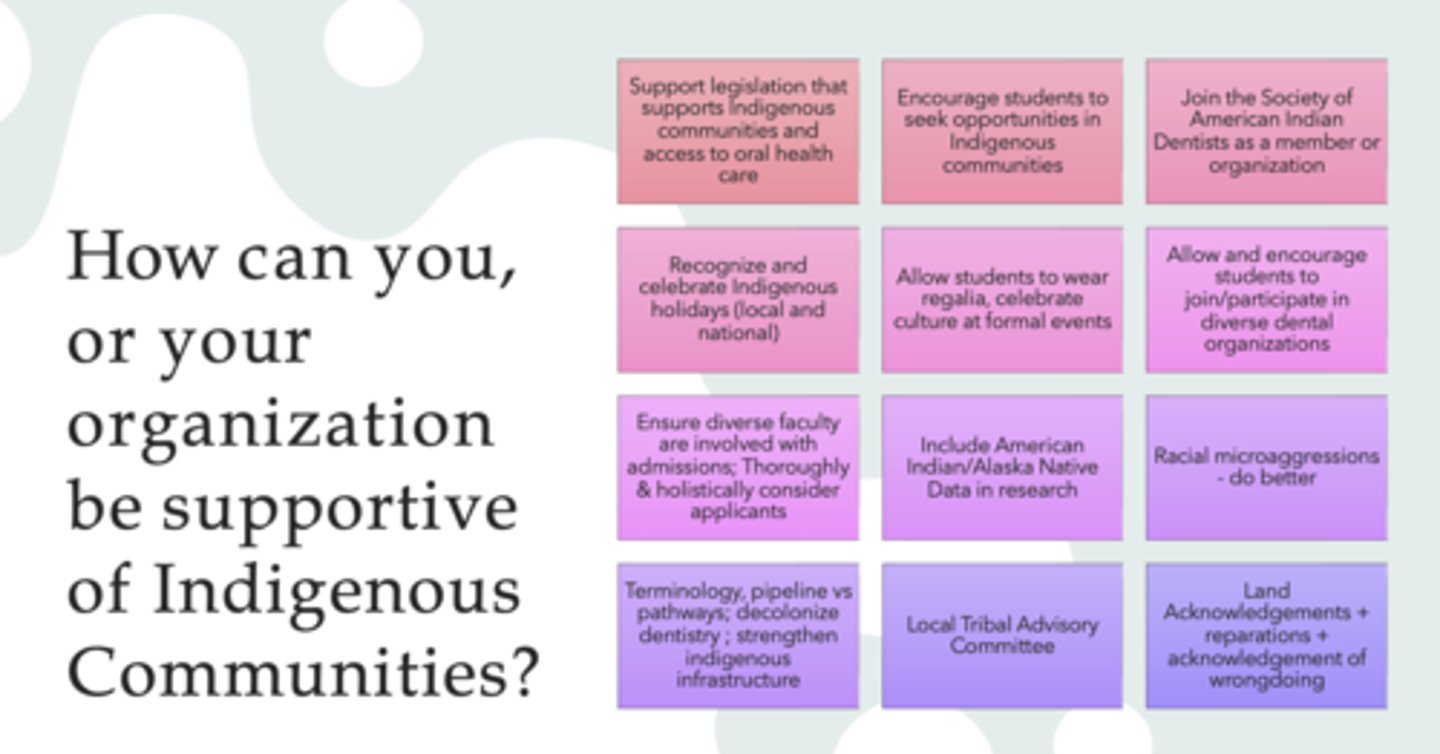
Which approach(s) helps decolonize dentistry and strengthen Indigenous communities?
A. Allow and encourage students to join/participate in diverse dental organizations
B. Use the term "pipeline" to describe student progression
C. Embrace pathway-based models, rethink terminology, and invest in Indigenous infrastructure
D. Join the Society of American Indian Dentists as a member or organization
A, C, & D
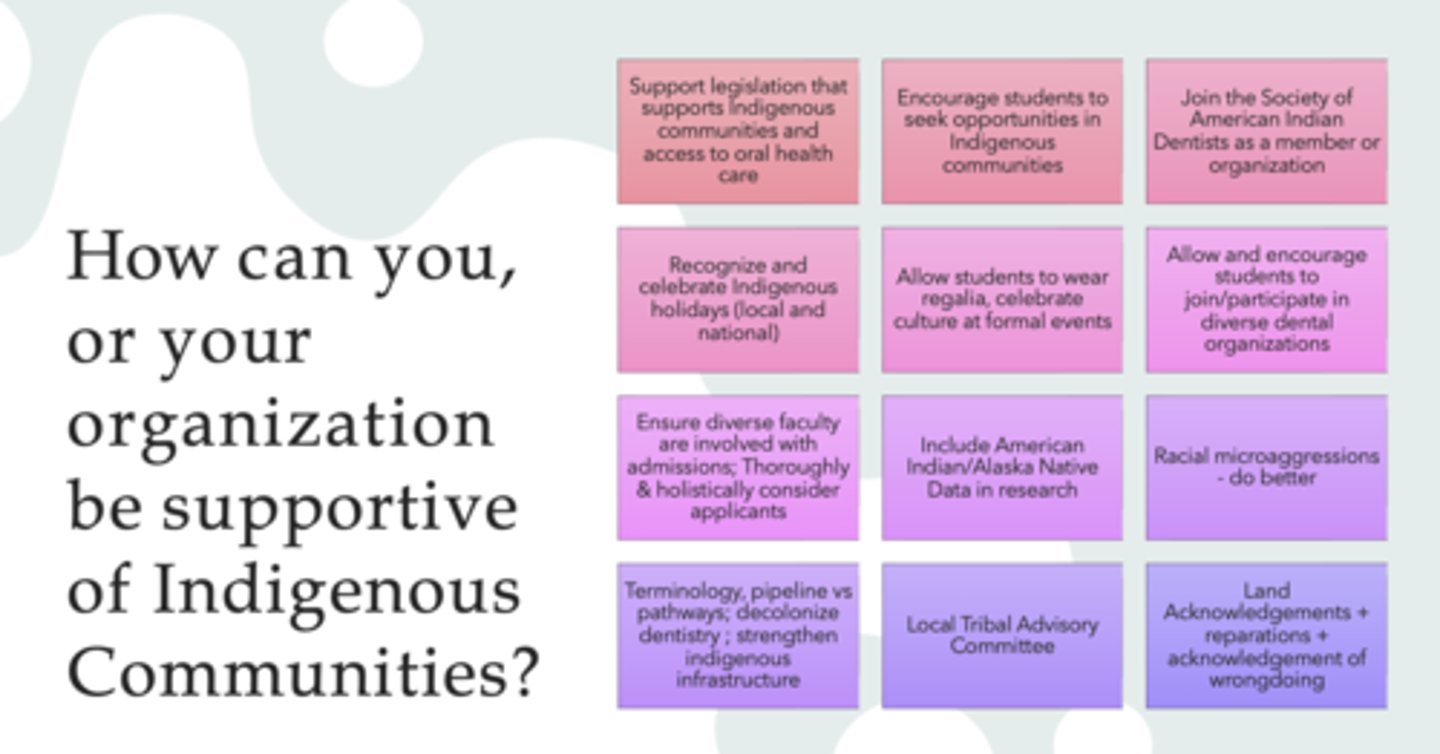
How can organizations address harm and support healing for Indigenous communities?
A. Recognize racial microaggressions
B. Include land acknowledgments and reparations while taking responsibility for historical harm
C. Avoid discussions about wrongdoing to prevent discomfort
D. Focus on general diversity without addressing specific harms
A, B
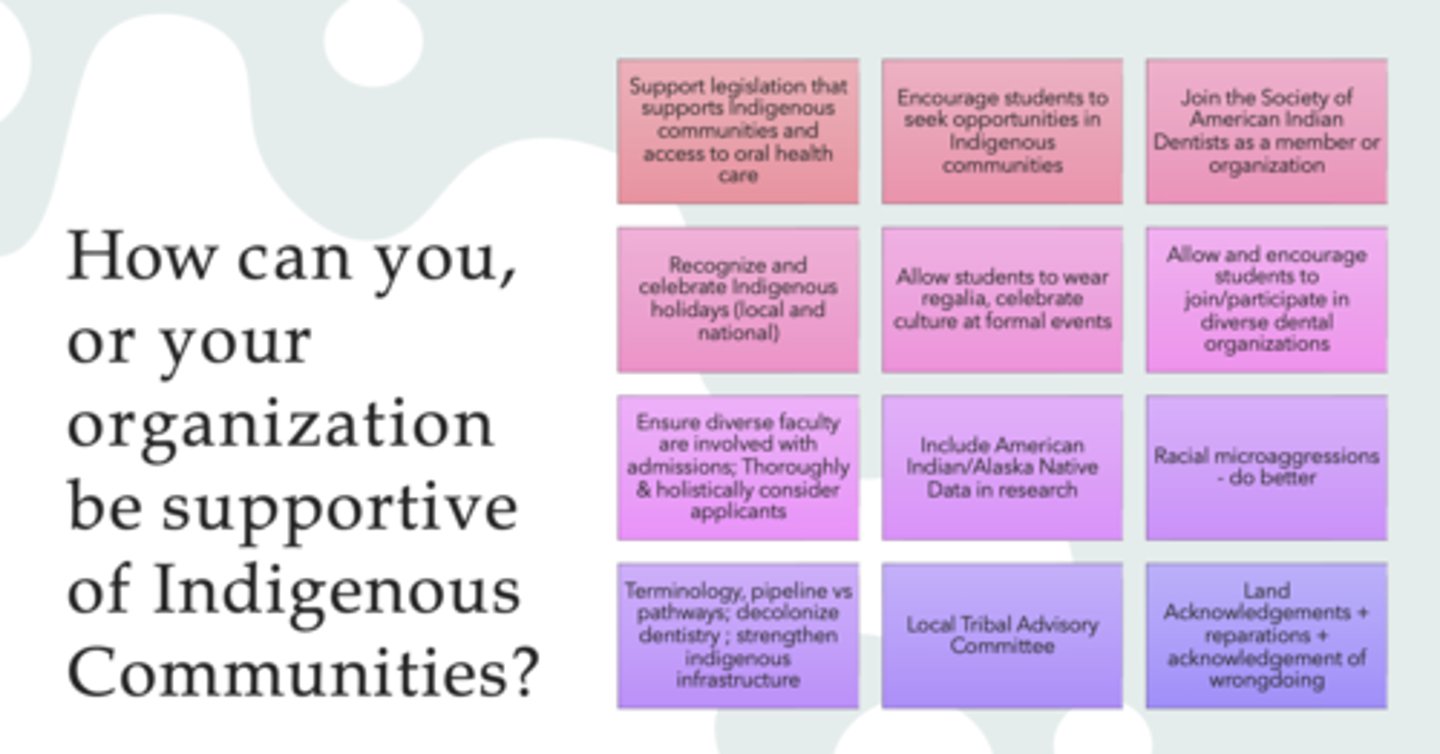
Define the following:
1) The social and political context that creates your identity and
2) How your identity influences and biases your perception of and outlook on the world
Positionality

Define the following:
A series of interrelated hierarchies and power dynamics that touch all facets of social life: race, class, gender, sexual orientation, religion, education, gender identity, age, physical ability, passing, etc.
Privilege
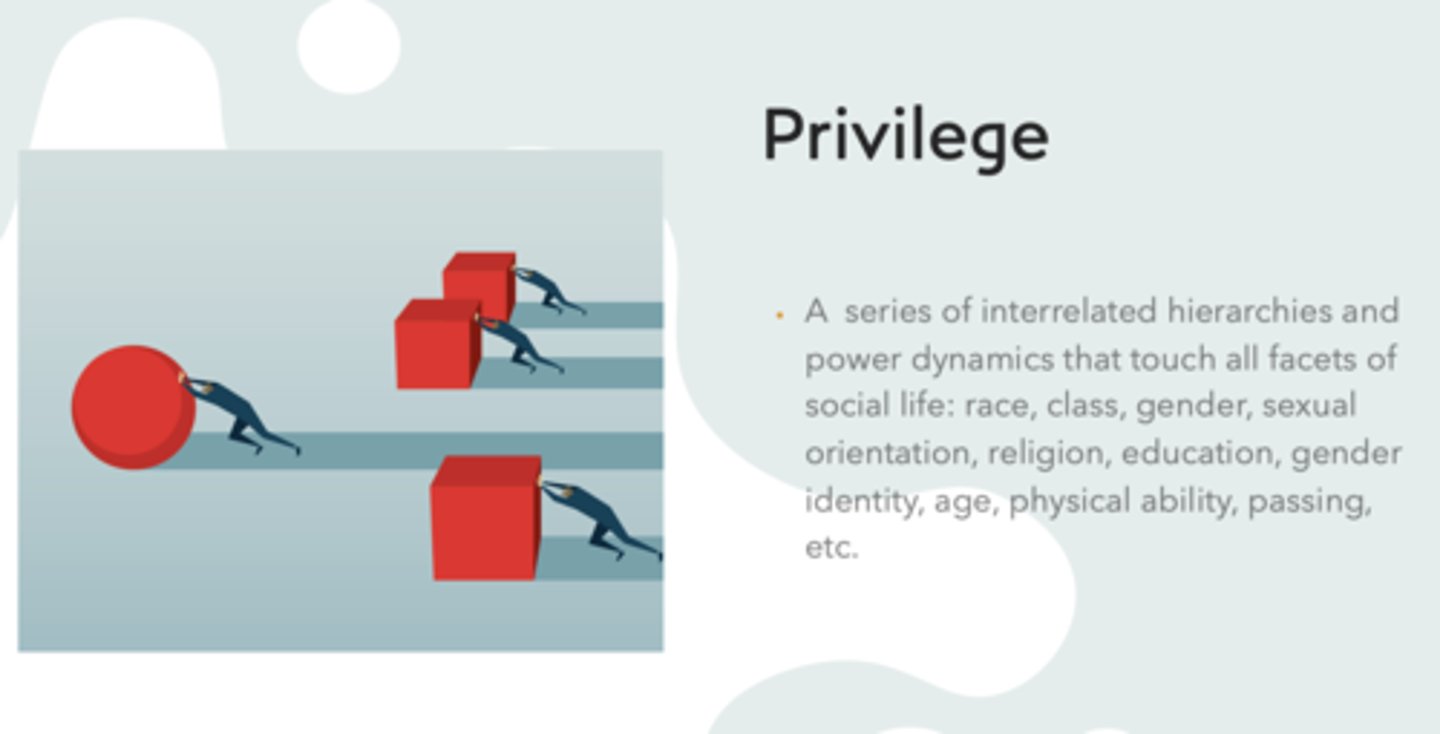
Define the following:
People are often disadvantaged by multiple sources of oppression: their race, class, gender identity, sexual orientation, religion, and other identity markers.
Intersectional theory

_____________ showed up in queer theory, feminist legal theory, studies on race and gender and sexuality. It was a useful word, one that provided a framework for discussing broader patterns of oppression, power, discrimination — but one that remained in academia for years. It takes into account people's overlapping identities and experiences in order to understand the complexity of prejudices they face.
Intersectional theory

Define the following:
A key concept used to explain how social categories interact and constitute multiple systems of privilege experienced by individuals and groups
Intersectionality
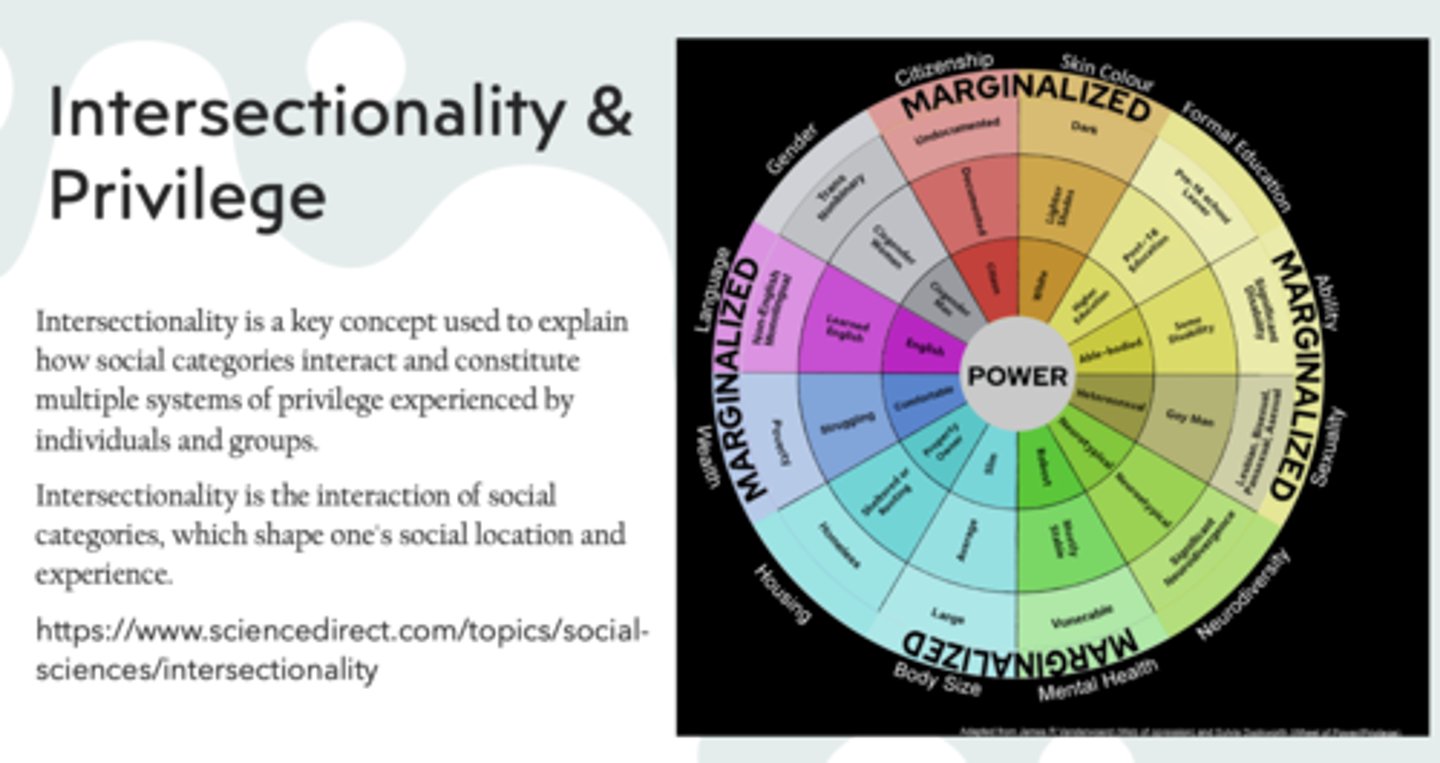
Define the following:
The interaction of social categories, which shape one's social location and experience
Intersectionality
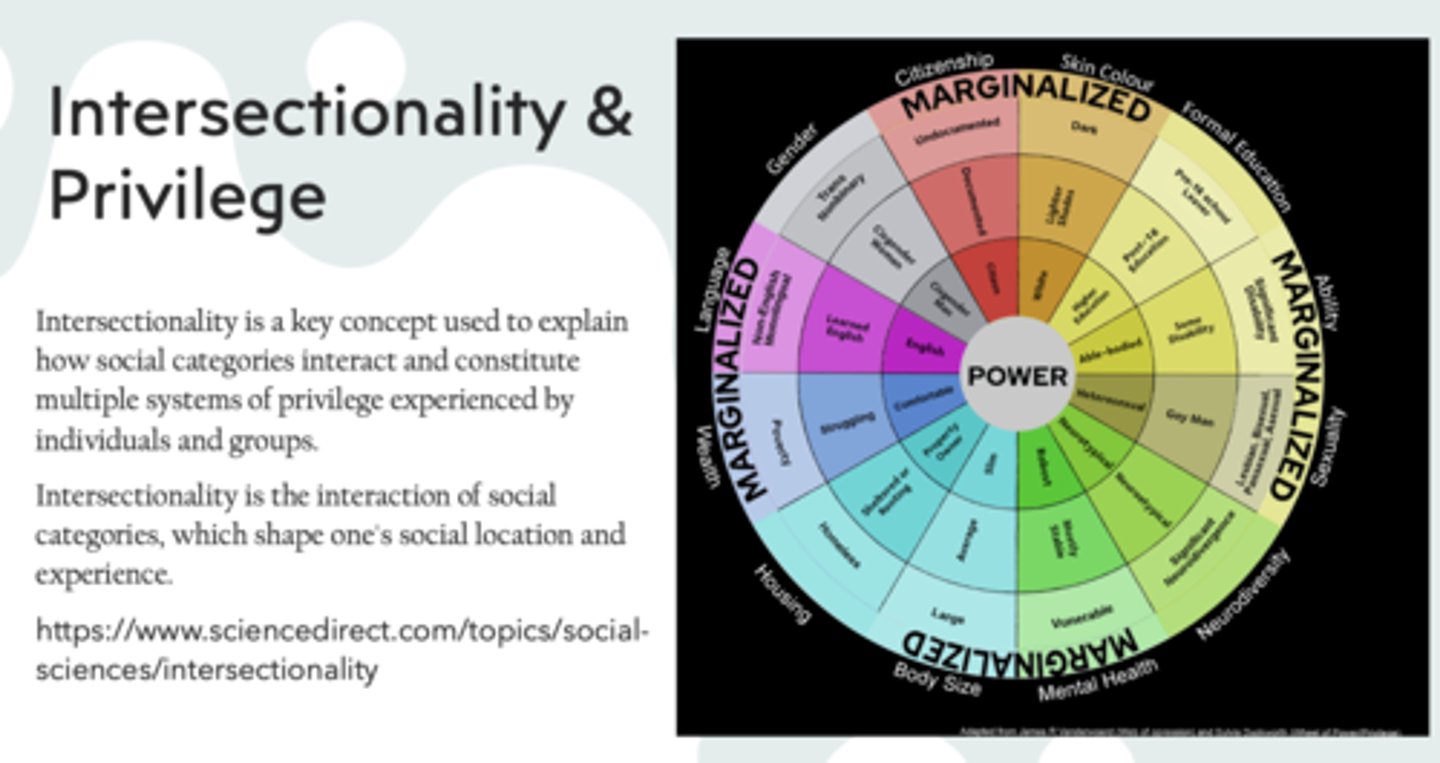
Define the following:
A philosophy emphasizing self-sufficiency and meritocracy, where advancement is based on personal capabilities rather than family or social background. However, it overlooks group domination dynamics, particularly socioeconomic privilege and racism.
Individualism
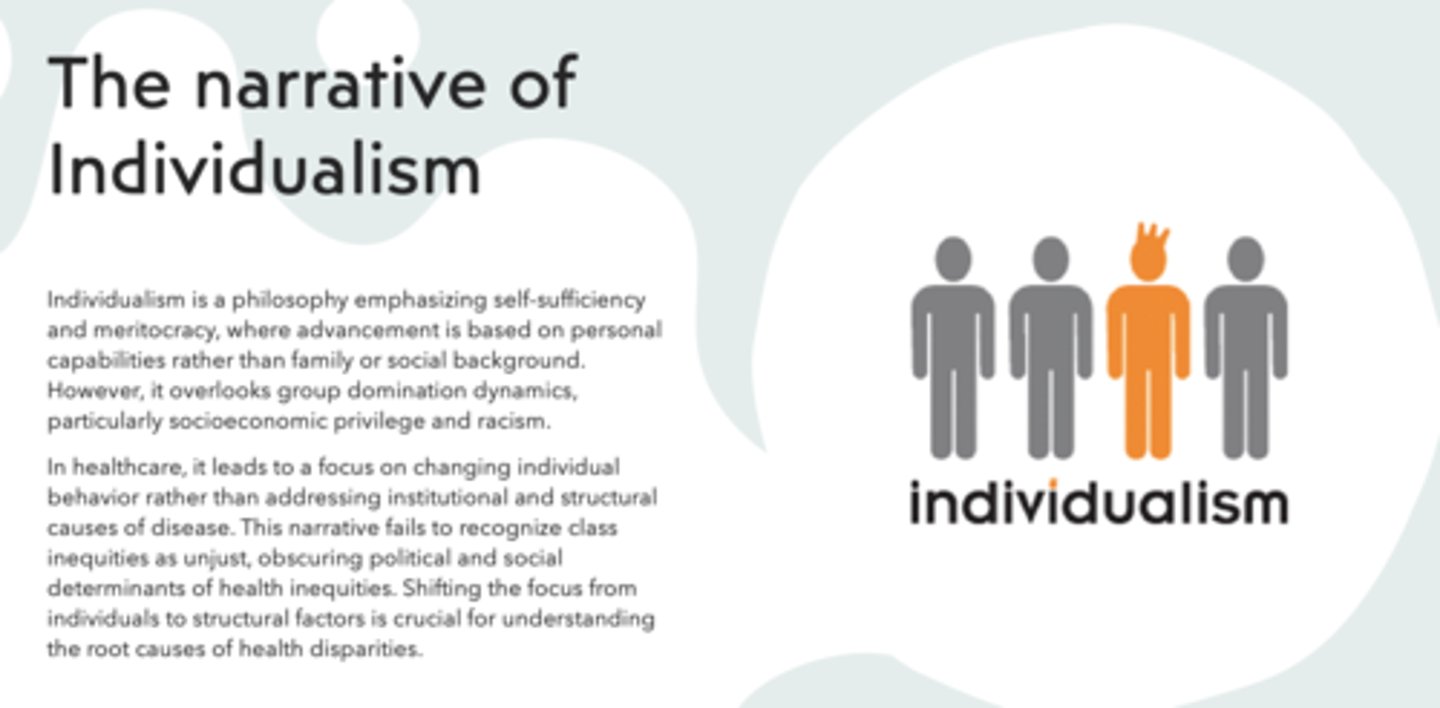
In healthcare, _____________ leads to a focus on changing individual behavior rather than addressing institutional and structural causes of disease. This narrative fails to recognize class inequities as unjust, obscuring political and social determinants of health inequities. Shifting the focus from individuals to structural factors is crucial for understanding the root causes of health disparities.
Individualism

Define the following:
An active, consistent, and arduous practice of unlearning and re-evaluating, in which a person in a position of privilege and power seeks to operate in solidarity with a marginalized group.
Allyship
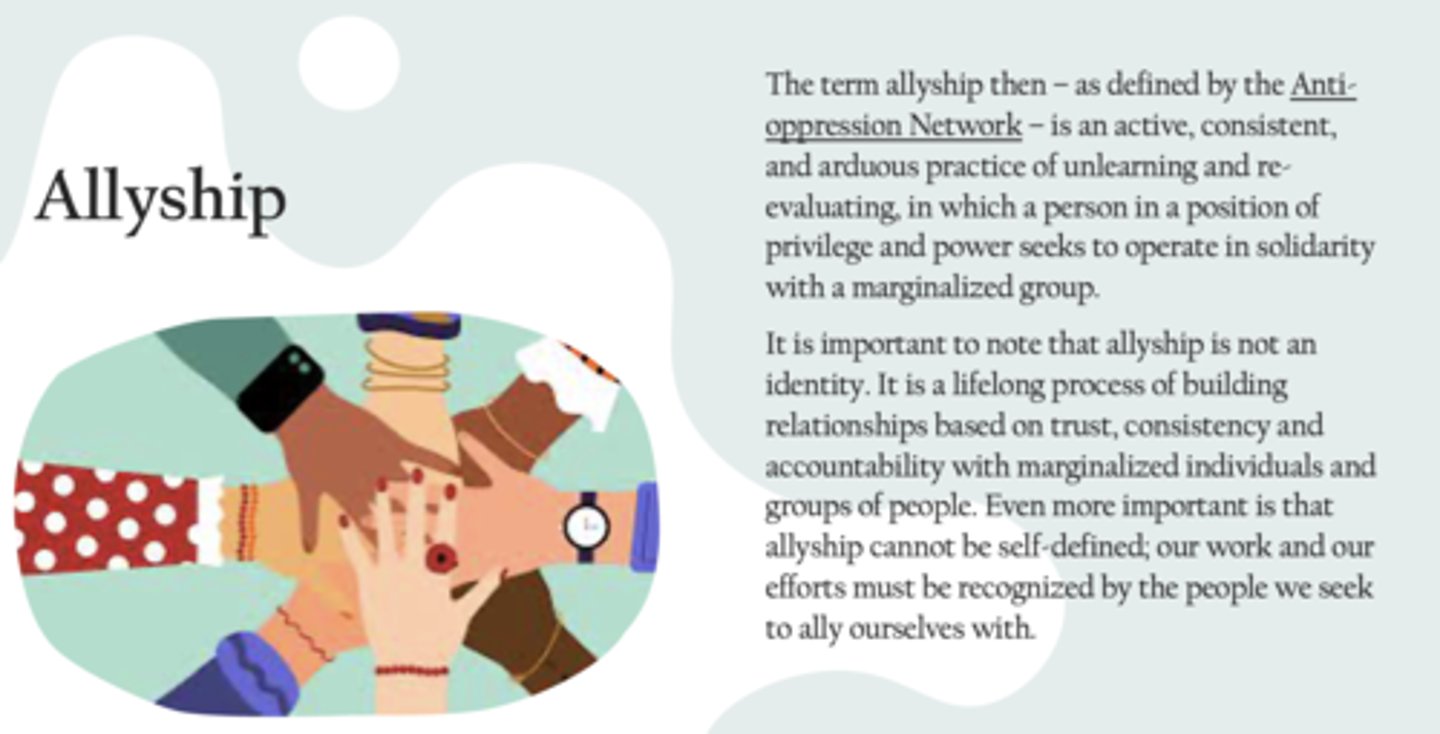
What define allyship?
Anti-oppression Network
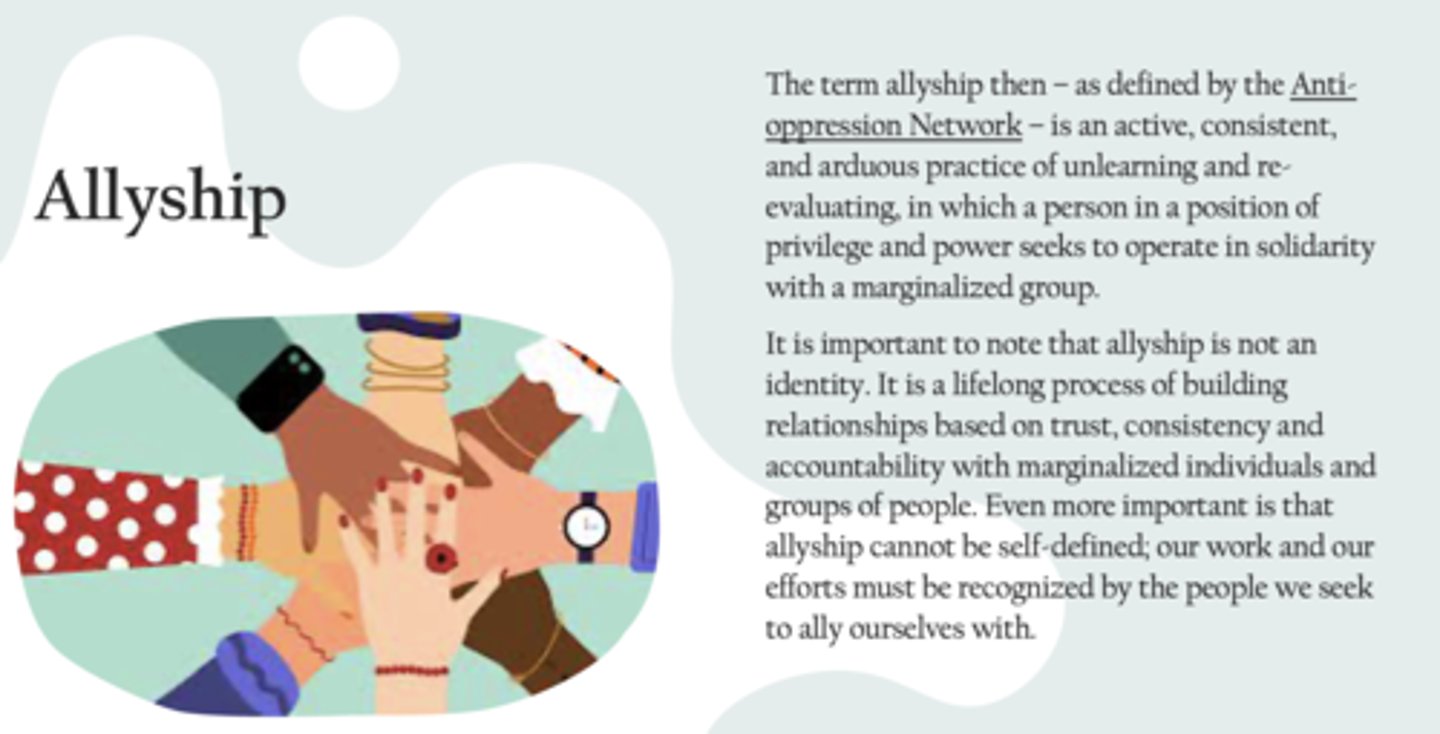
T/F: Allyship is an identity
False (Allyship is not an identity)

Define the following:
It is a lifelong process of building relationships based on trust, consistency and accountability with marginalized individuals and groups of people. Even more important is that ___________ cannot be self-defined; our work and our efforts must be recognized by the people we seek to ally ourselves with.
Allyship
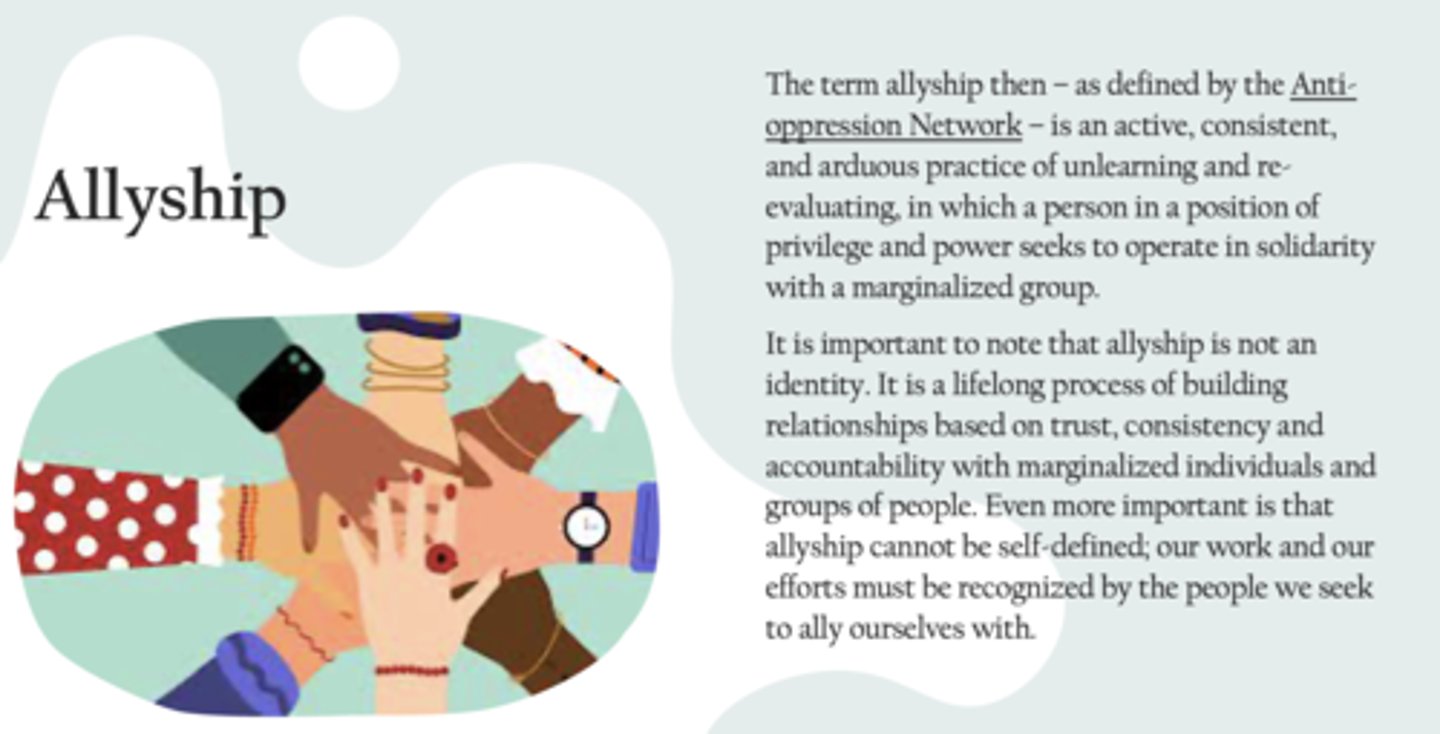
Define the following:
How a person presents gender outwardly, through behavior, clothing, voice, or other perceived characteristics. Society identifies these cues as masculine or feminine, although what is considered masculine or feminine changes over time and varies by culture
Gender Expression
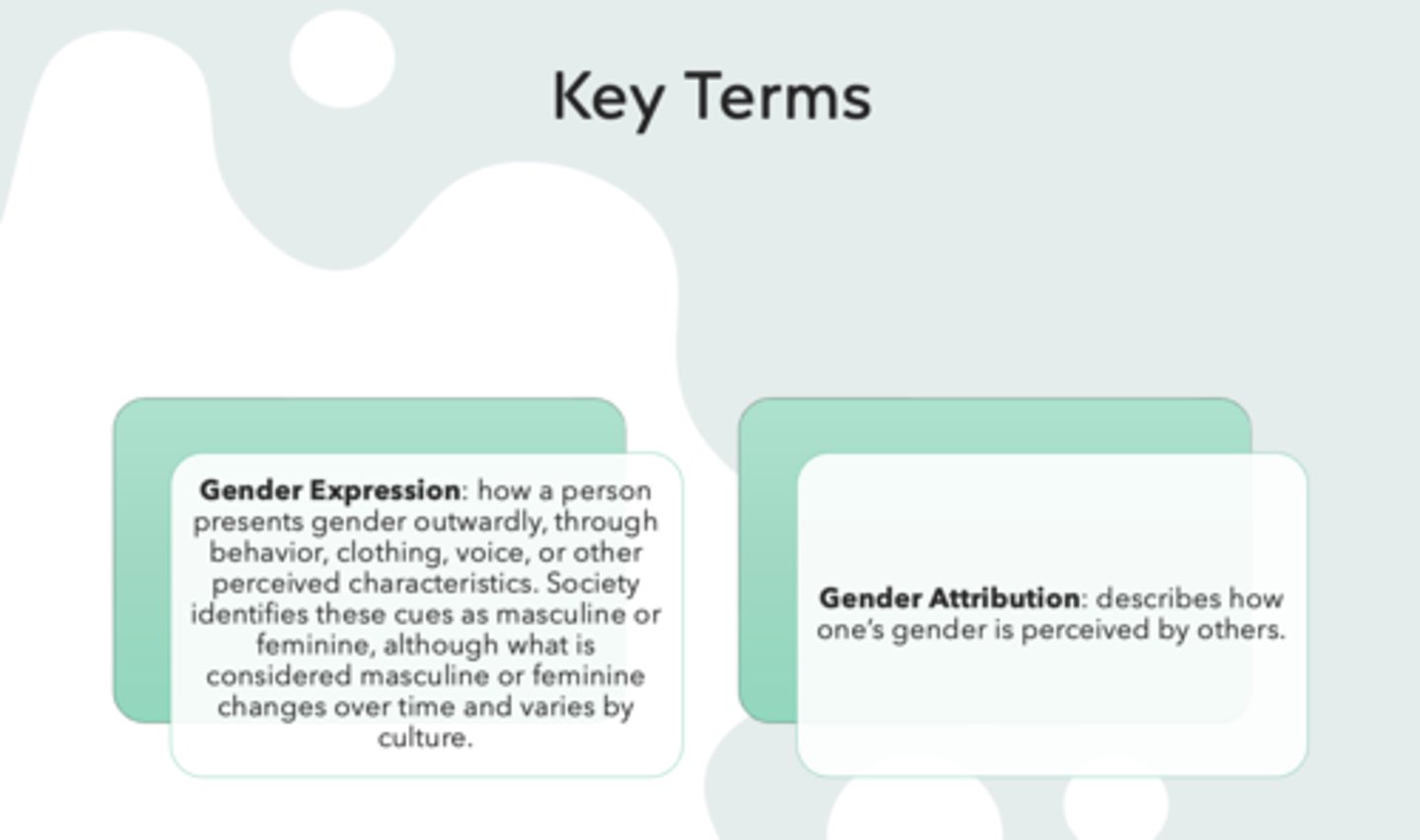
Define the following:
Describes how one's gender is perceived by others.
Gender Attribution
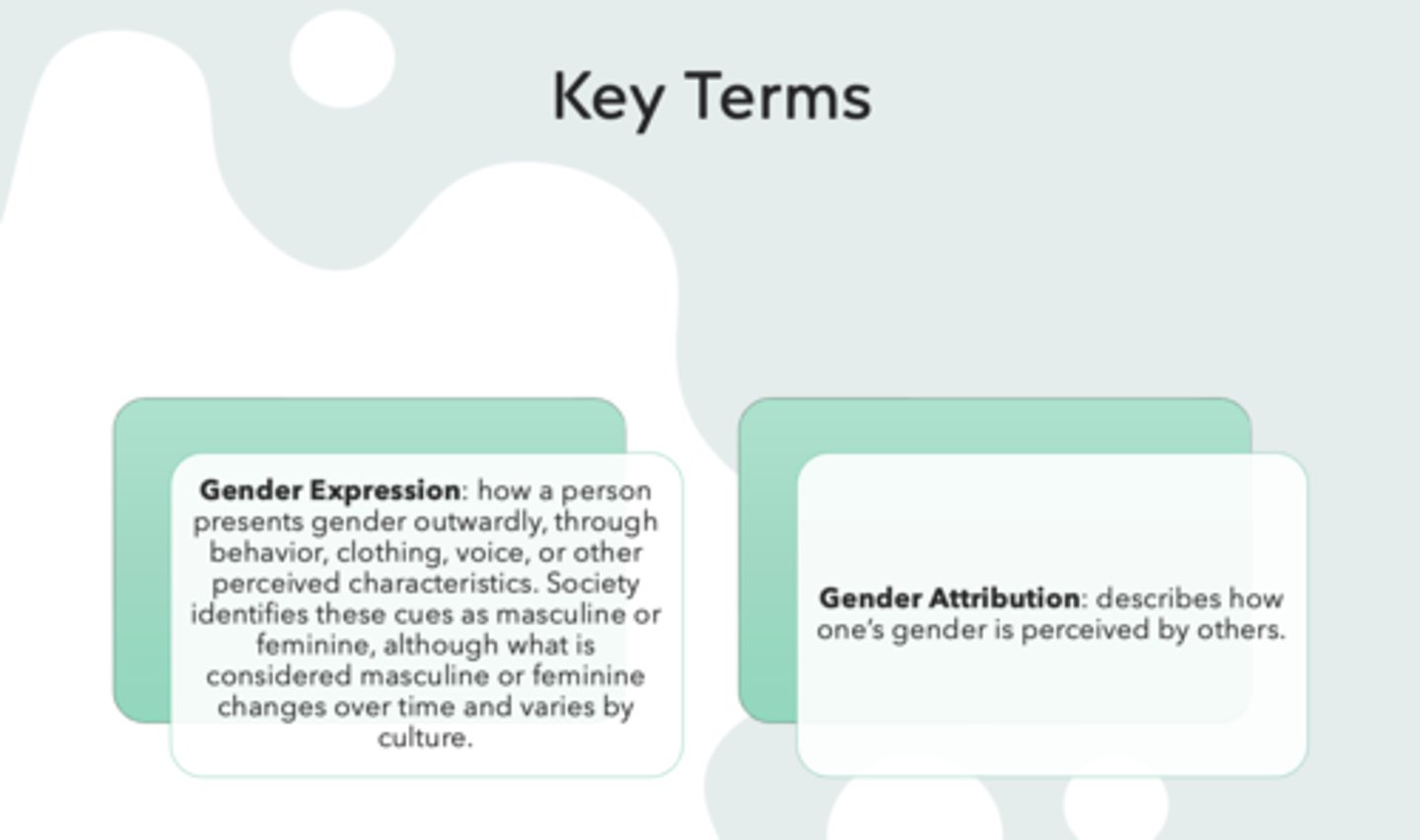
Define the following:
- Refers to a person's biological status and is typically assigned at birth, usually based on external anatomy
- Typically categorized as male, female, or intersex.
Sex
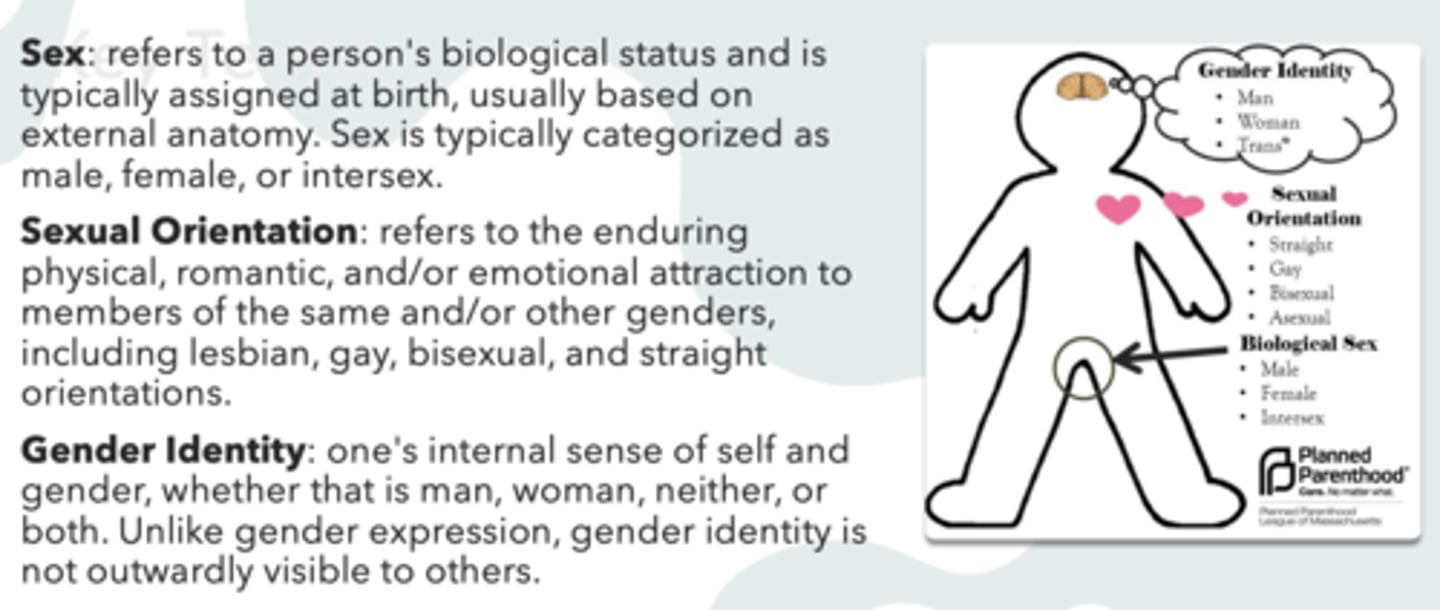
Define the following:
Refers to the enduring physical, romantic, and/or emotional attraction to members of the same and/or other genders, including lesbian, gay, bisexual, and straight orientations.
Sexual Orientation
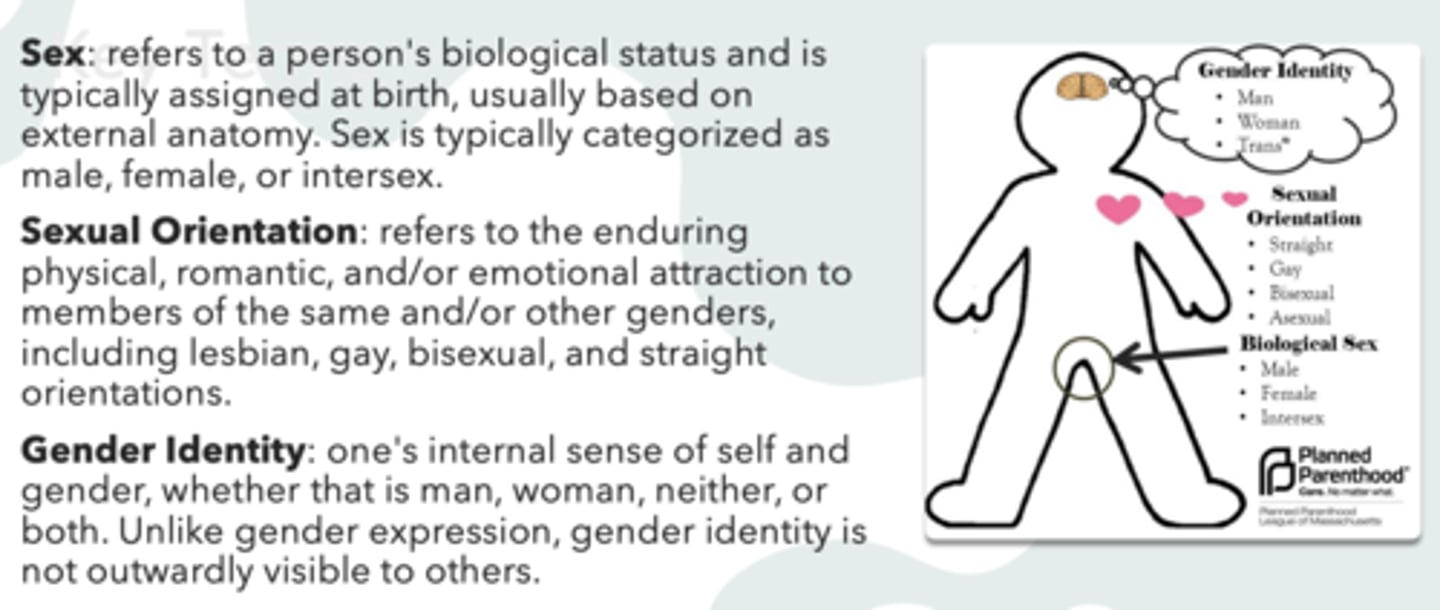
Define the following:
One's internal sense of self and gender, whether that is man, woman, neither, or both. Unlike gender expression, ____________ is not outwardly visible to others.
Gender Identity
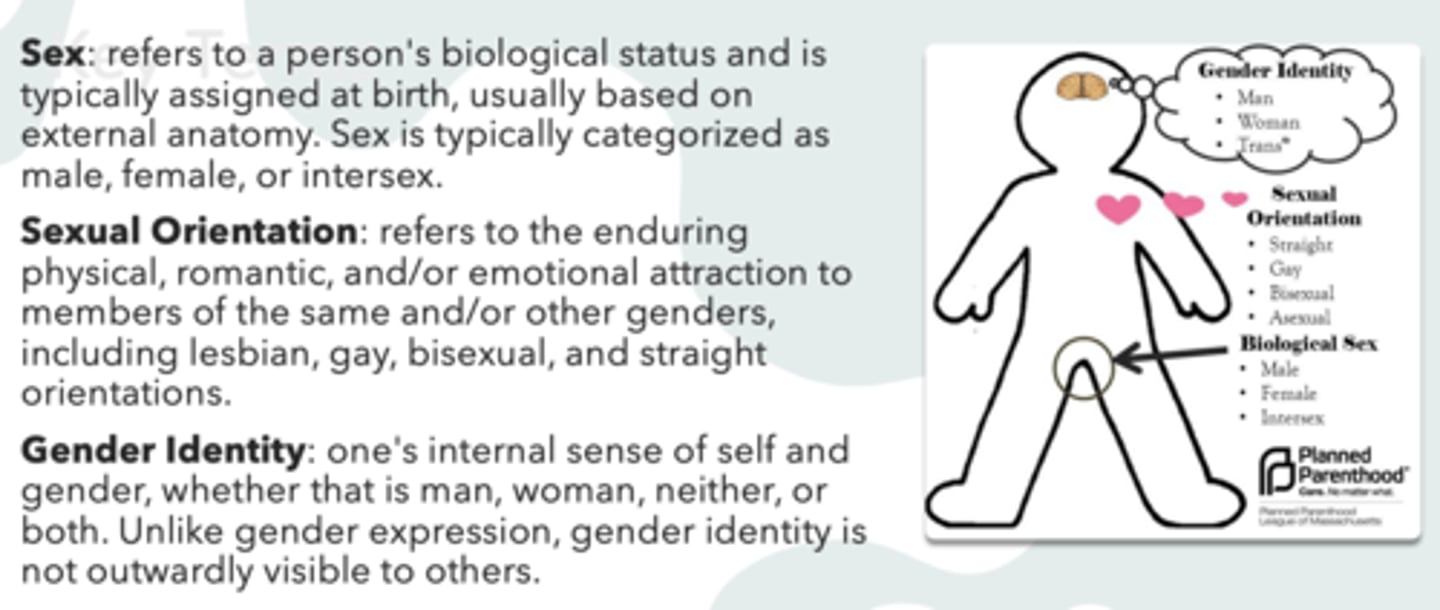
Define the following:
Describes people who identify comfortably with the gender they were assigned at birth
Cisgender ("cis")
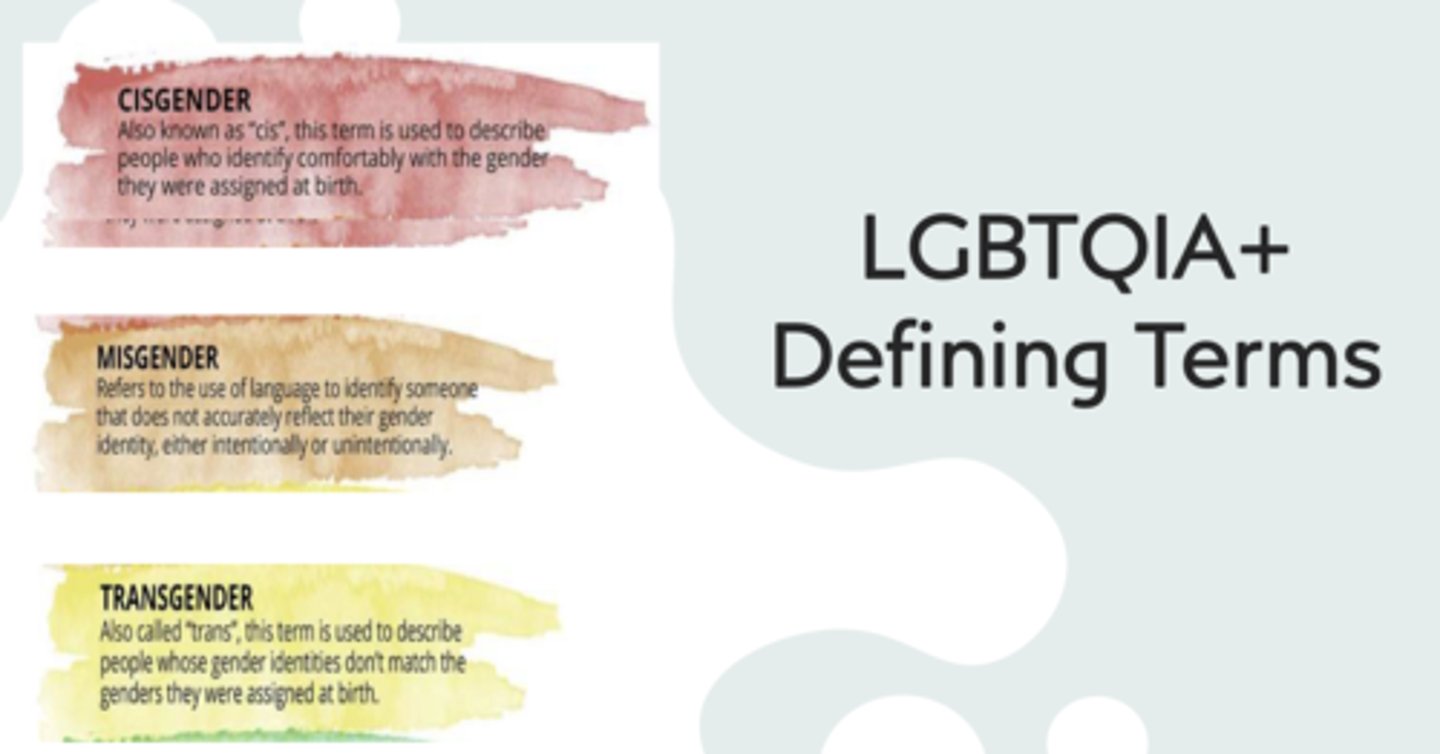
Define the following:
Refers to the use of language to identify someone that does not accurately reflect their gender identity, either intentionally or unintentionally
Misgender
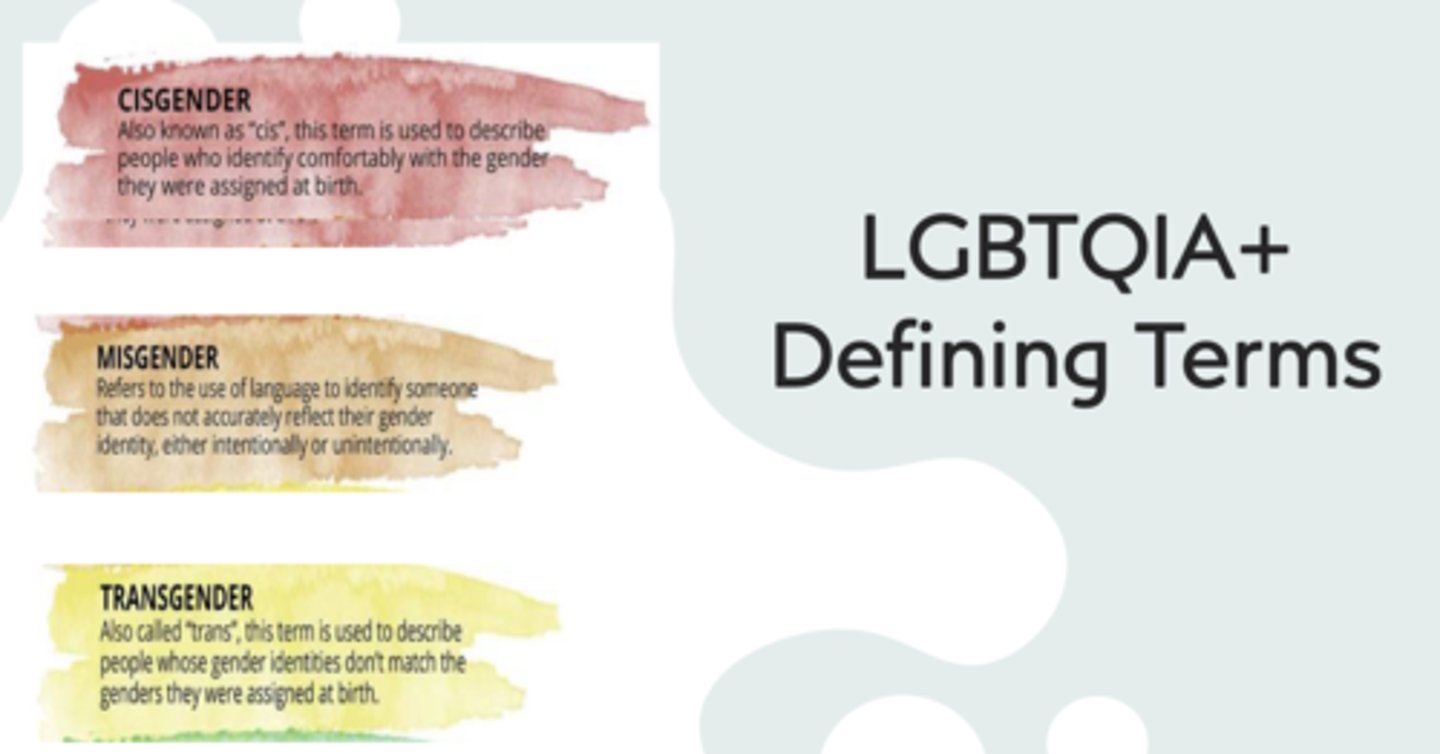
Define the following:
Describes people whose gender identities don't match the genders they were assigned at birth
Transgender ("trans")
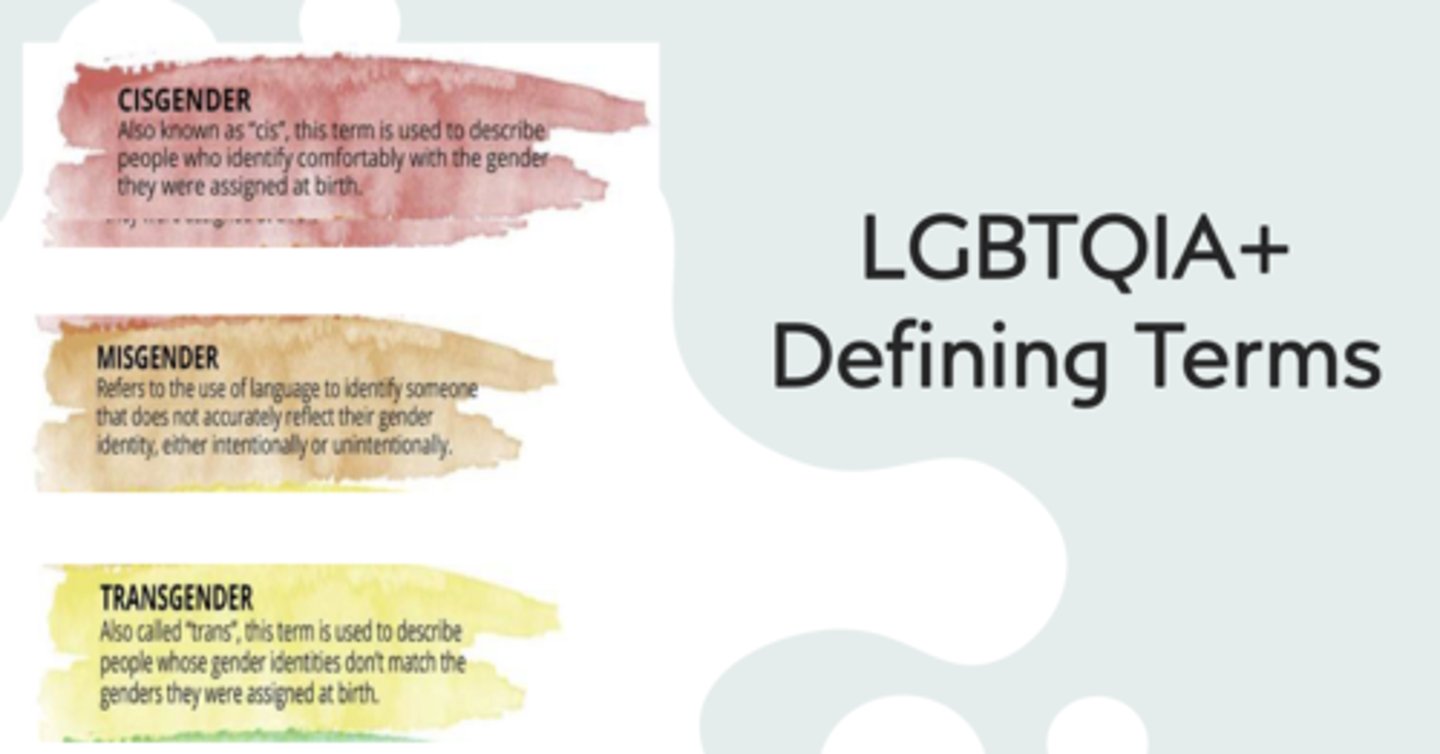
Define the following:
Refers to a person who identifies as either a woman or a man
Binary
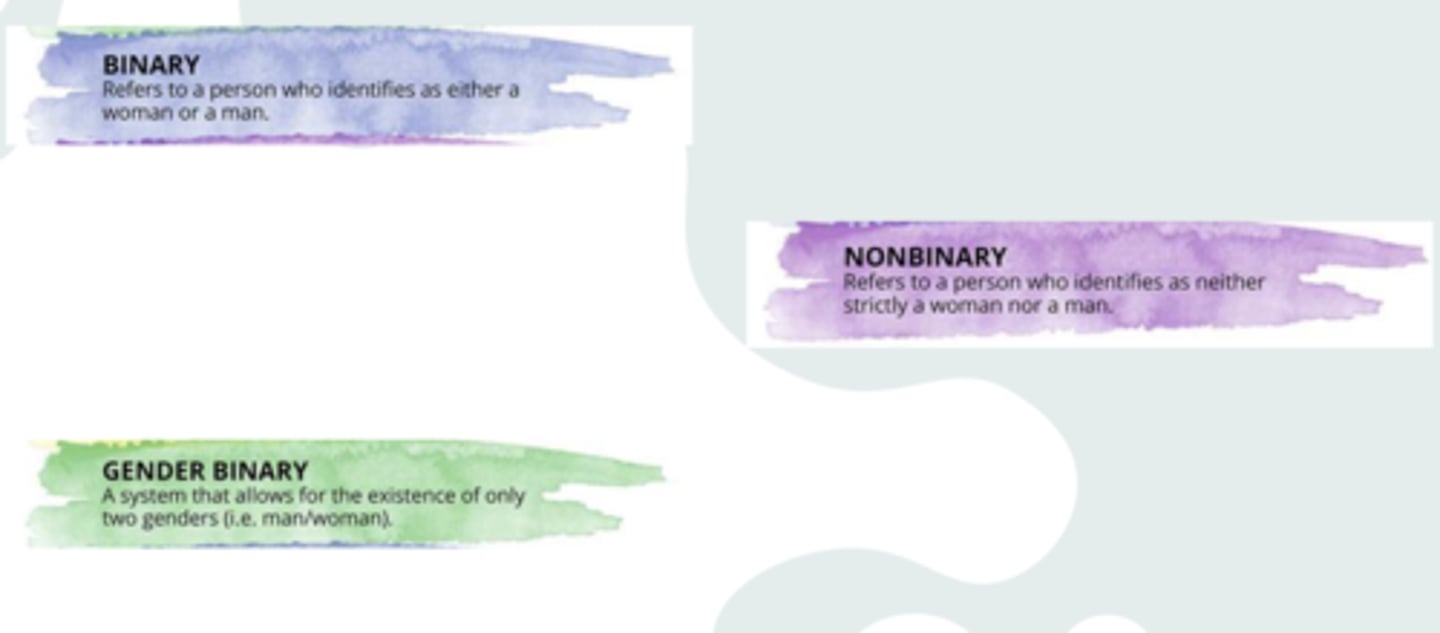
Define the following:
A system that allows for the existence of only two genders (i.e. man/woman)
Gender Binary
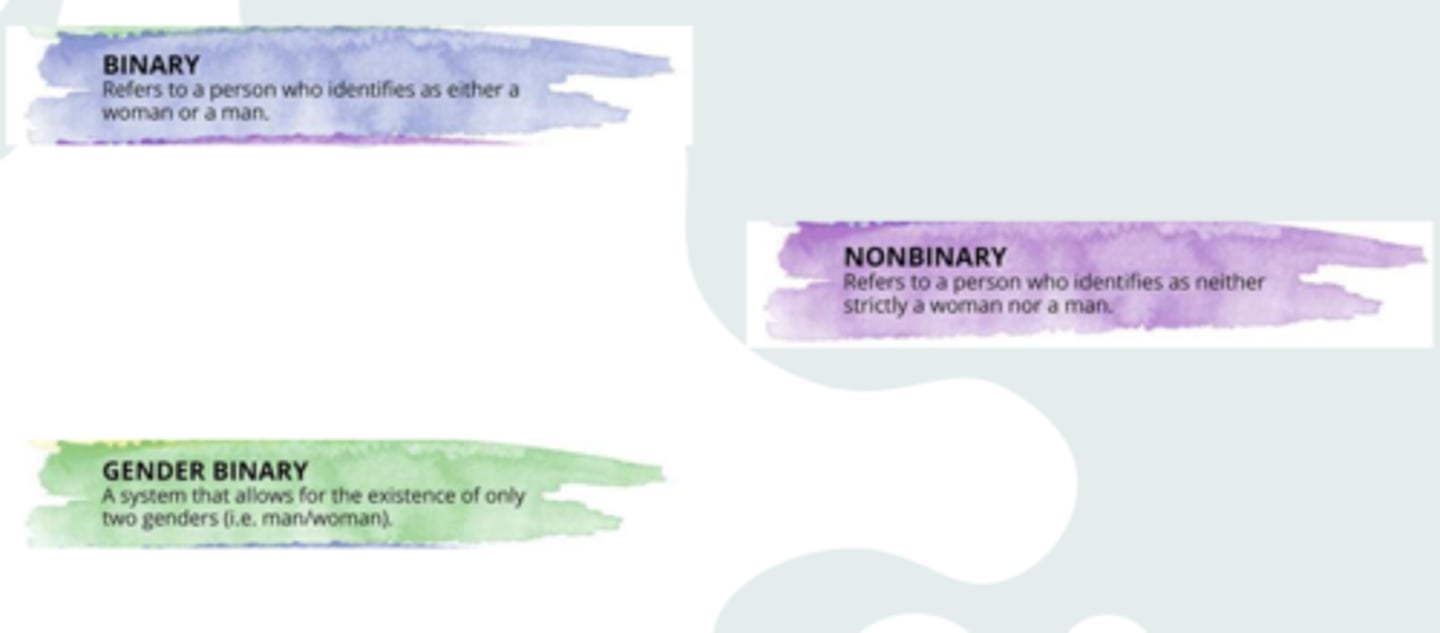
Define the following:
Refers to a person who identifies as neither strictly a woman nor a man
Nonbinary

Which population has higher rates of oral health issues than other racial groups in the US?
African Americans
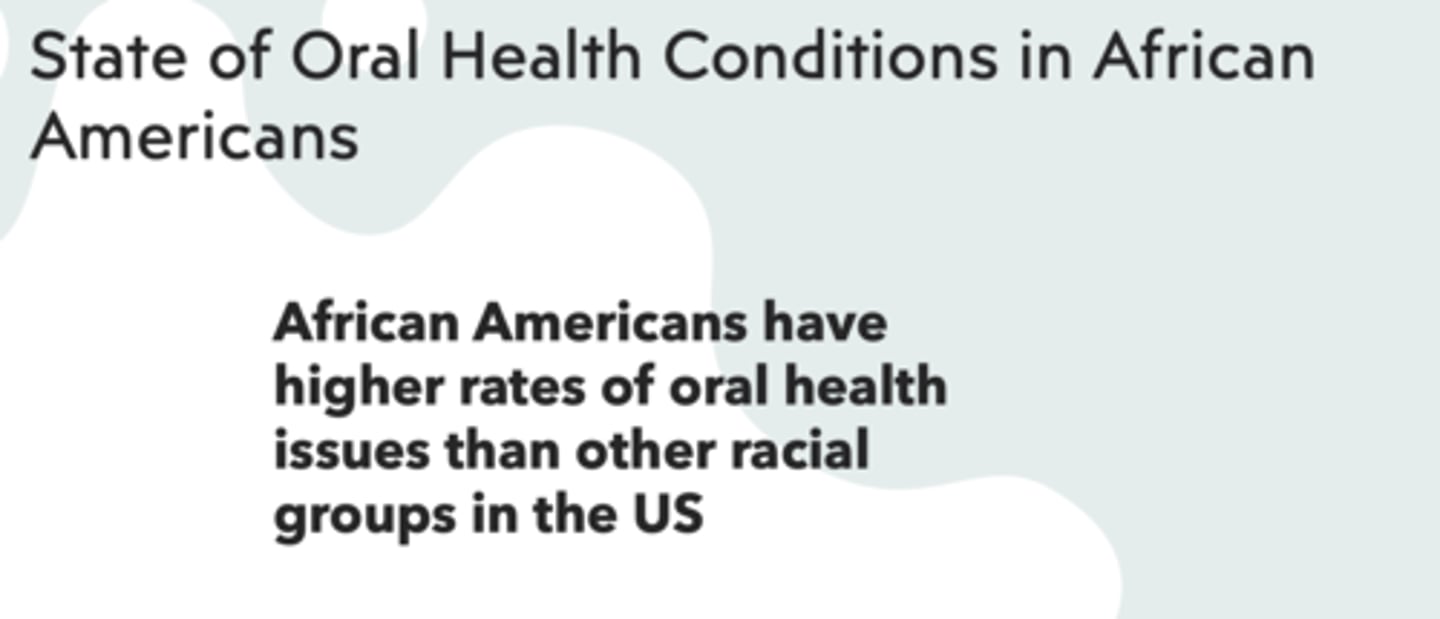
Which group has higher rates of dental caries according to the data?
A. White children
B. White adolescents
C. Black children and adolescents
D. All groups have equal rates
C. Black children and adolescents

T/F: Black Adults have higher rates periodontitis than most other racial groups
True

The 5-year survival rate or oral pharyngeal cancers among African American men is _________ for White Americans
Lower

Which group experiences higher rates of cavities and early childhood tooth decay?
A. White children
B. Hispanic children
C. Black children
D. Asian American children
C. Black children
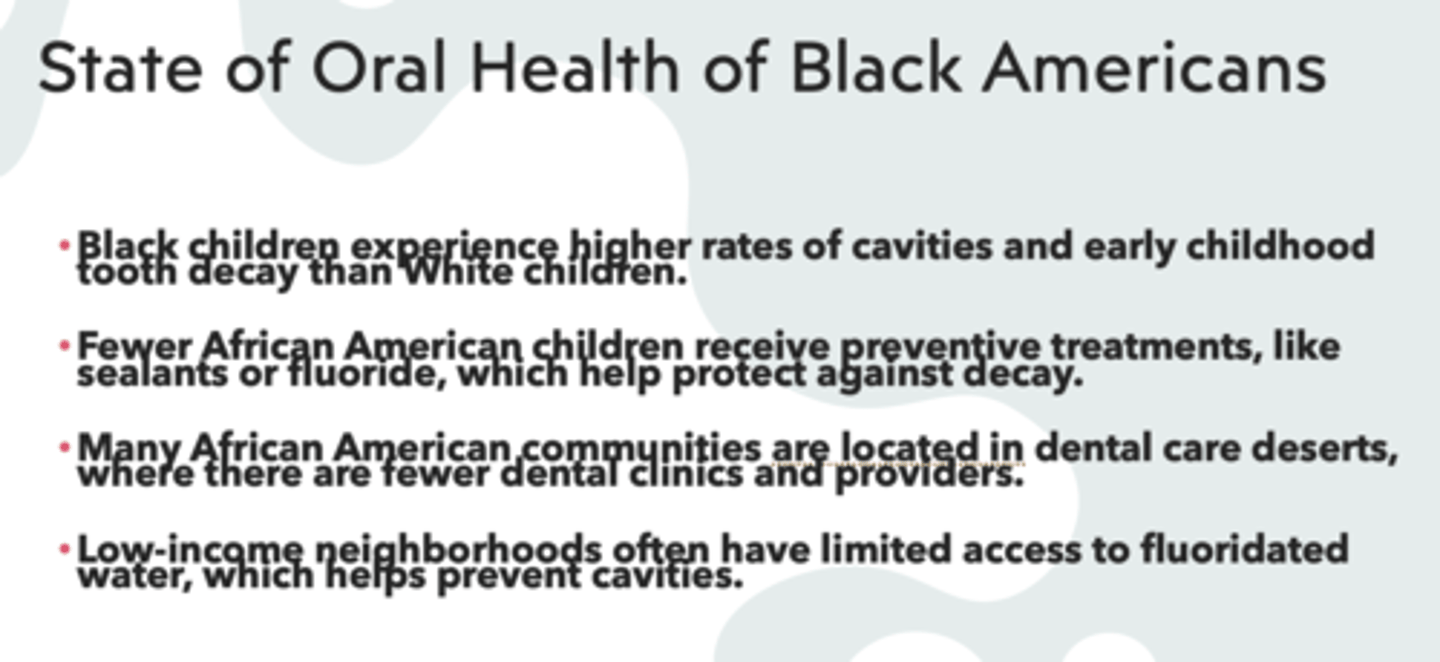
Fewer African American children receive preventative treatments like what?
Sealants or flouride (help protect against decay)

What is a key barrier to oral health care for many African American communities?
Dental care deserts with few clinics and providers

Why do low-income neighborhoods face higher risk of cavities?
Limited access to fluoridated water, which helps prevent cavities
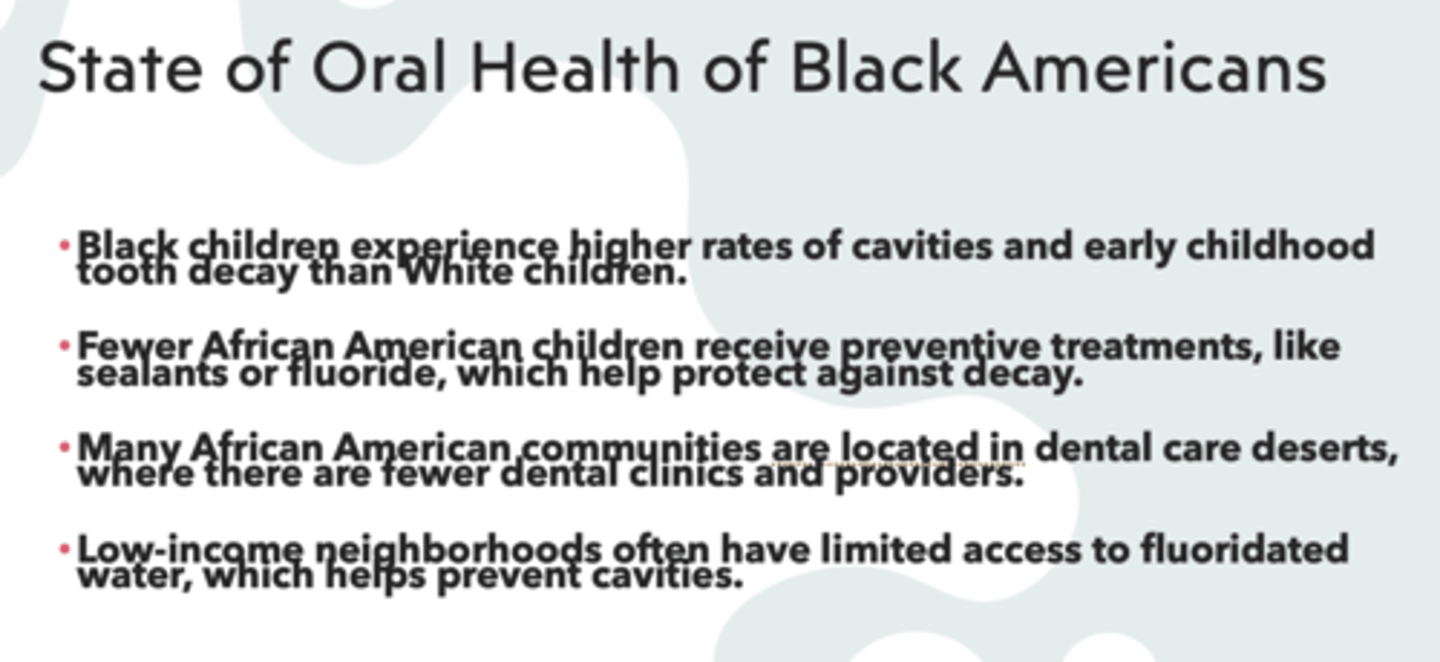
What are five barriers to oral healthcare in the African-American Community?
- Economic inequality
- Out-of-pocket costs
- Lack of employer-based insurance
- Access to Care
- Workforce Shortage

All of the following are solutions to barriers to oral healthcare in the African-American Community except for:
A. Expanding Medicaid dental coverage and affordable dental care programs.
B. Decreasing Black representation in dentistry through scholarships and mentorship programs.
C. Promoting community-based dental care programs in underserved areas.
D. Raising awareness about preventive oral health practices through education and outreach.
B. Decreasing Black representation in dentistry through scholarships and mentorship programs. (Should be INCREASING!)
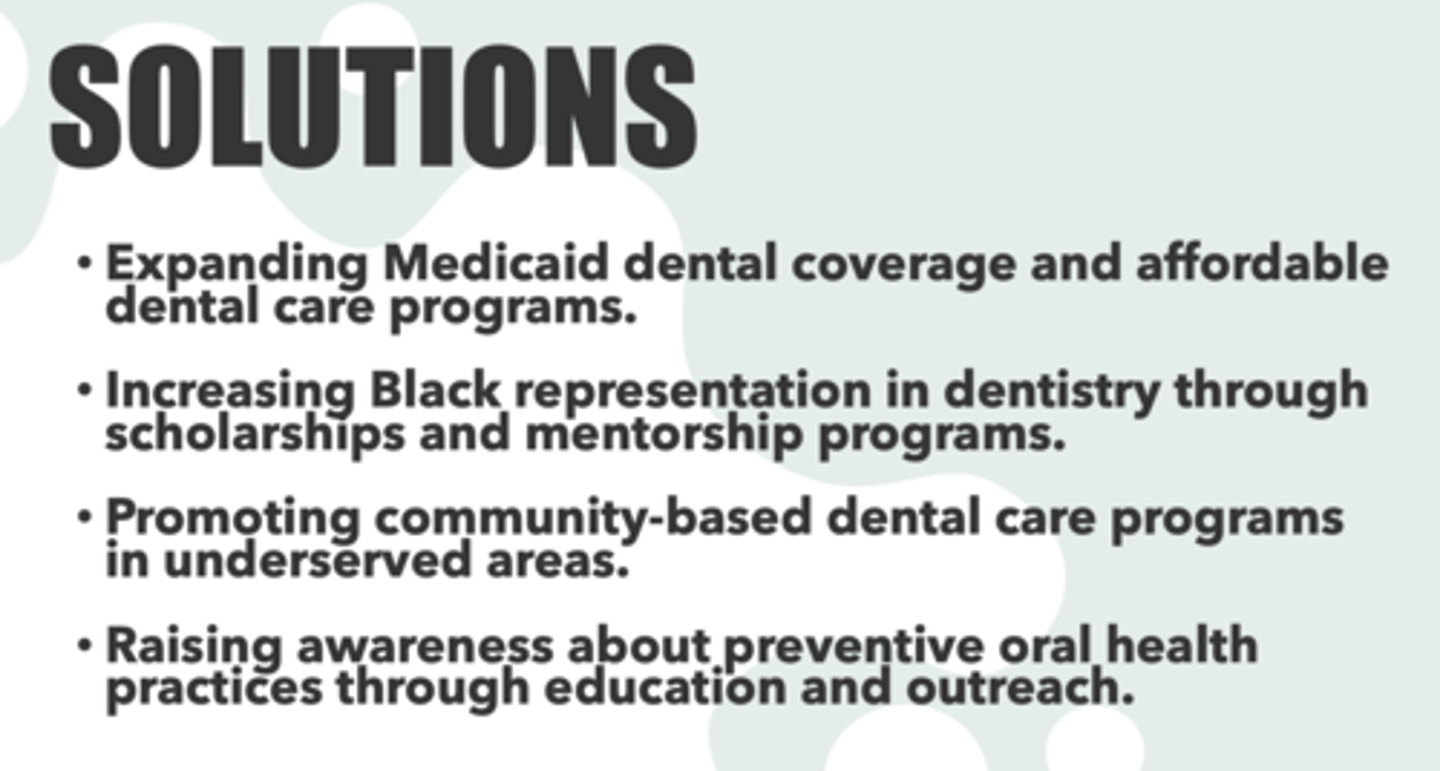
Define the following:
A system of structuring opportunity and assigning value based on the social interpretation of how one looks (which is what we call "race") that unfairly disadvantages some individuals and communities, unfairly advantages some individuals and communities and saps the strength of the whole society through a waste of human resources.
Racism (defined by Dr. Camara Jones)
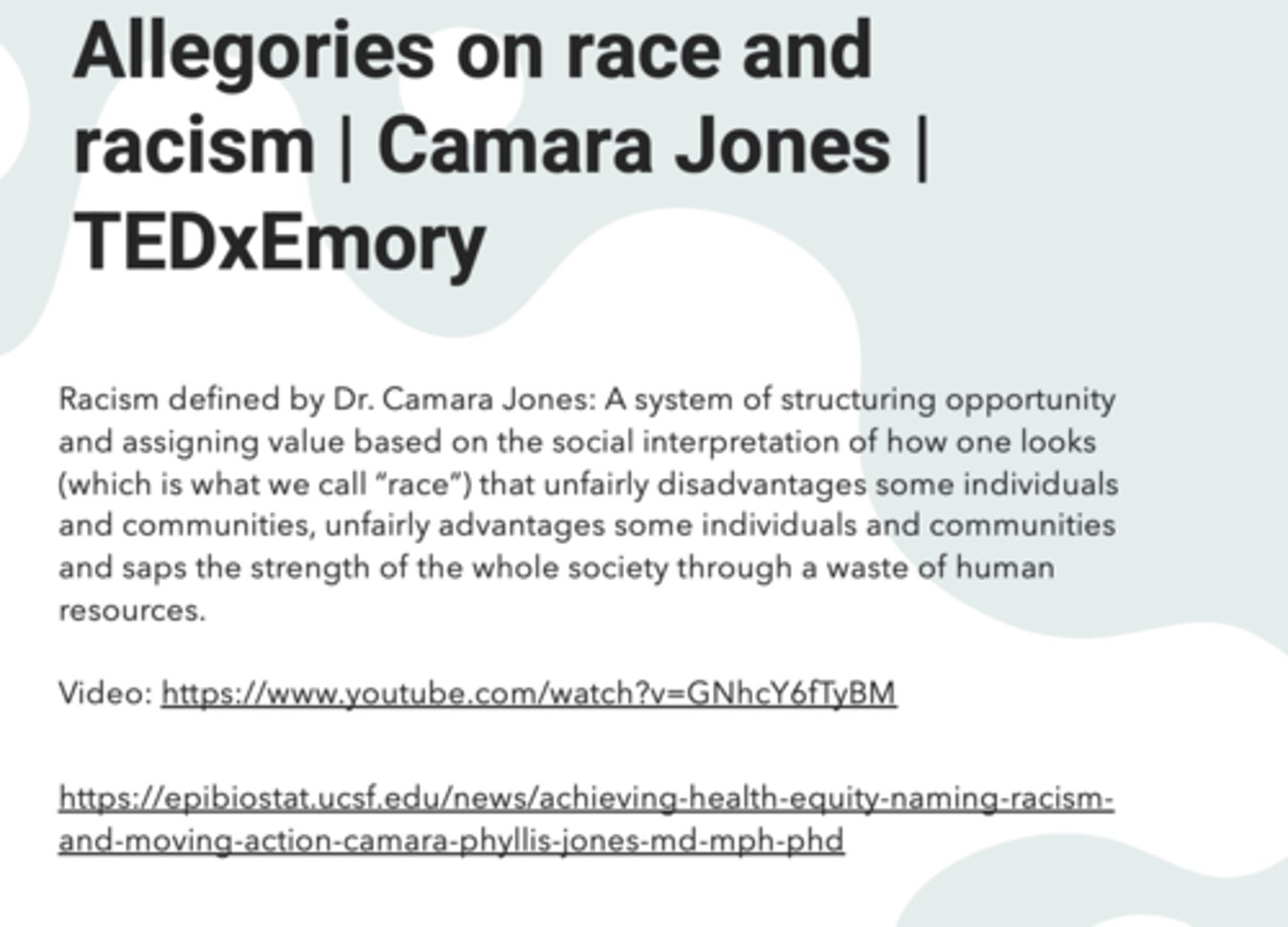
Define the following:
Economic, social and political institutions and processes of a society that create and reinforce racial discrimination
Structural racism

Define the following:
The relegation of people of color to inferior status and treatment based on unfounded beliefs about innate inferiority, as well as unjust treatment and oppression of people of color, whether intended or not
Racism

Define the following:
A term used to refer to African Americans, American Indians/Alaska Natives, Asian Americans, Latinos/Hispanics, and Native Hawaiians/other Pacific Islanders.
People of color
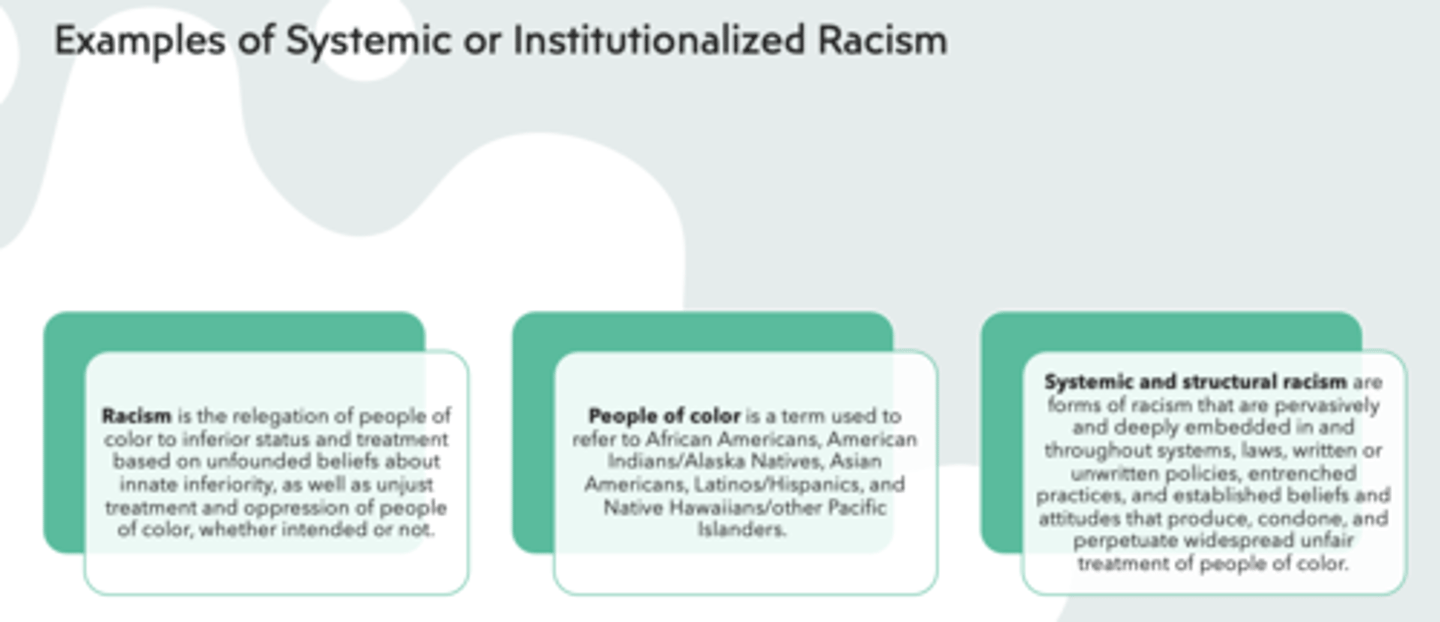
Define the following:
Forms of racism that are pervasively and deeply embedded in and throughout systems, laws, written or unwritten policies, entrenched practices, and established beliefs and attitudes that produce, condone, and perpetuate widespread unfair treatment of people of color.
Systemic and structural racism
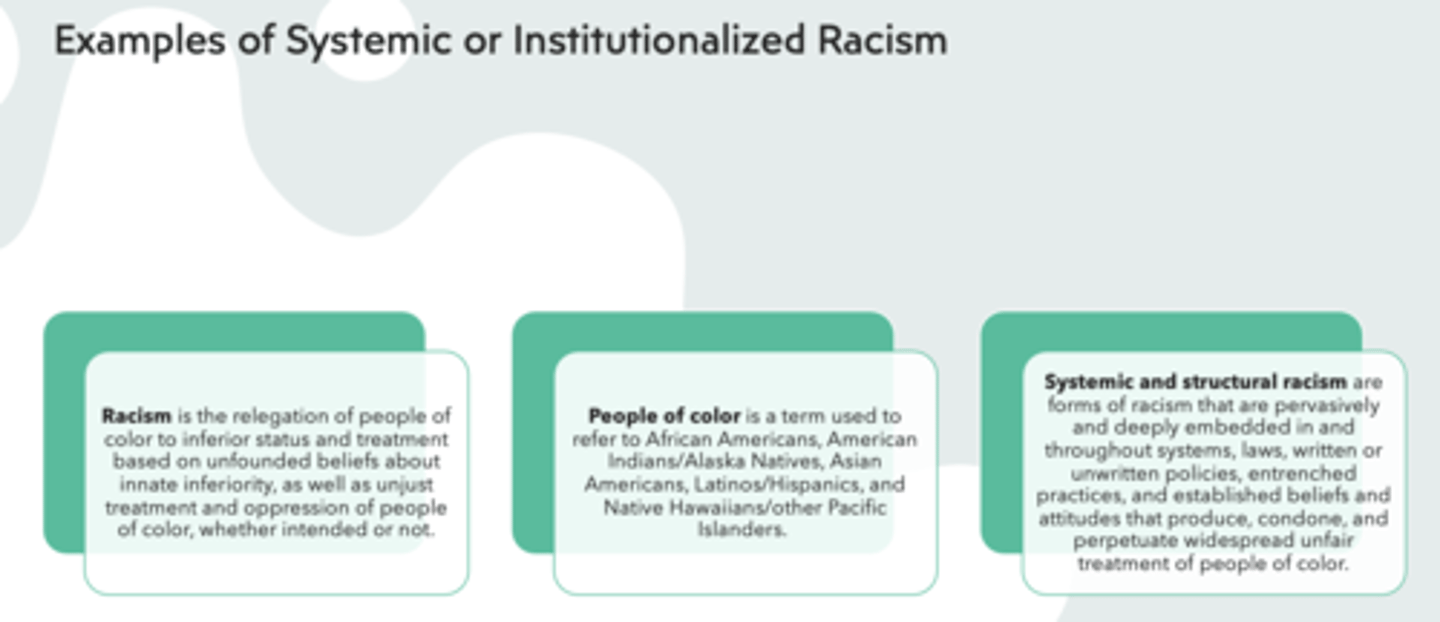
What is one of the primary goals of a health equity-based narrative?
To focus attention on inequitable systems, hierarchies, and institutional practices to reveal the sources of inequalities and the mechanisms that sustain them
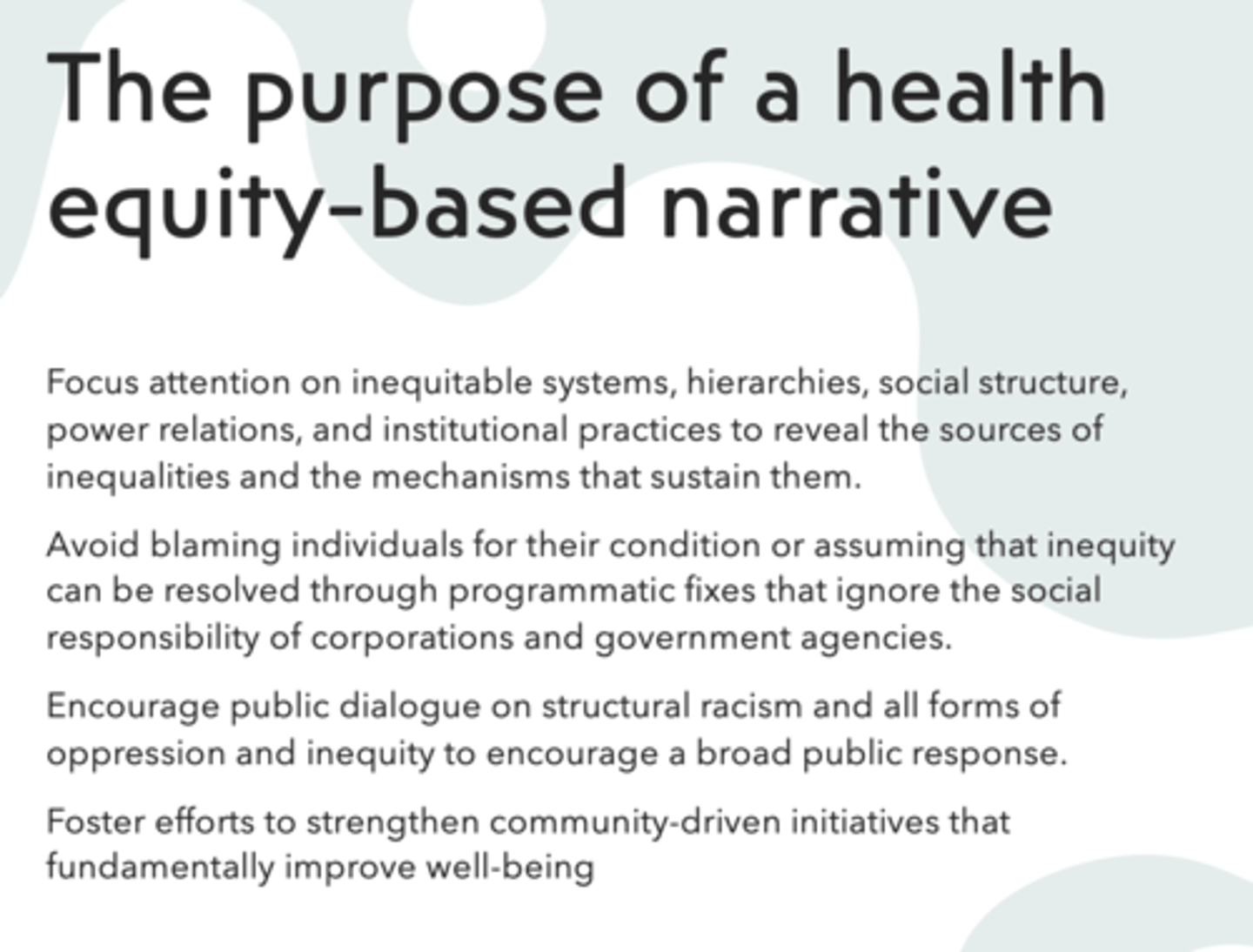
A health equity-based narrative avoids what?
Blaming individuals for their condition or assuming that inequity can be resolved through programmatic fixes that ignore the social responsibility of corporations and government agencies

Why does the narrative encourage public dialogue on structural racism and inequity?
To encourage a broad public response to oppression and inequity
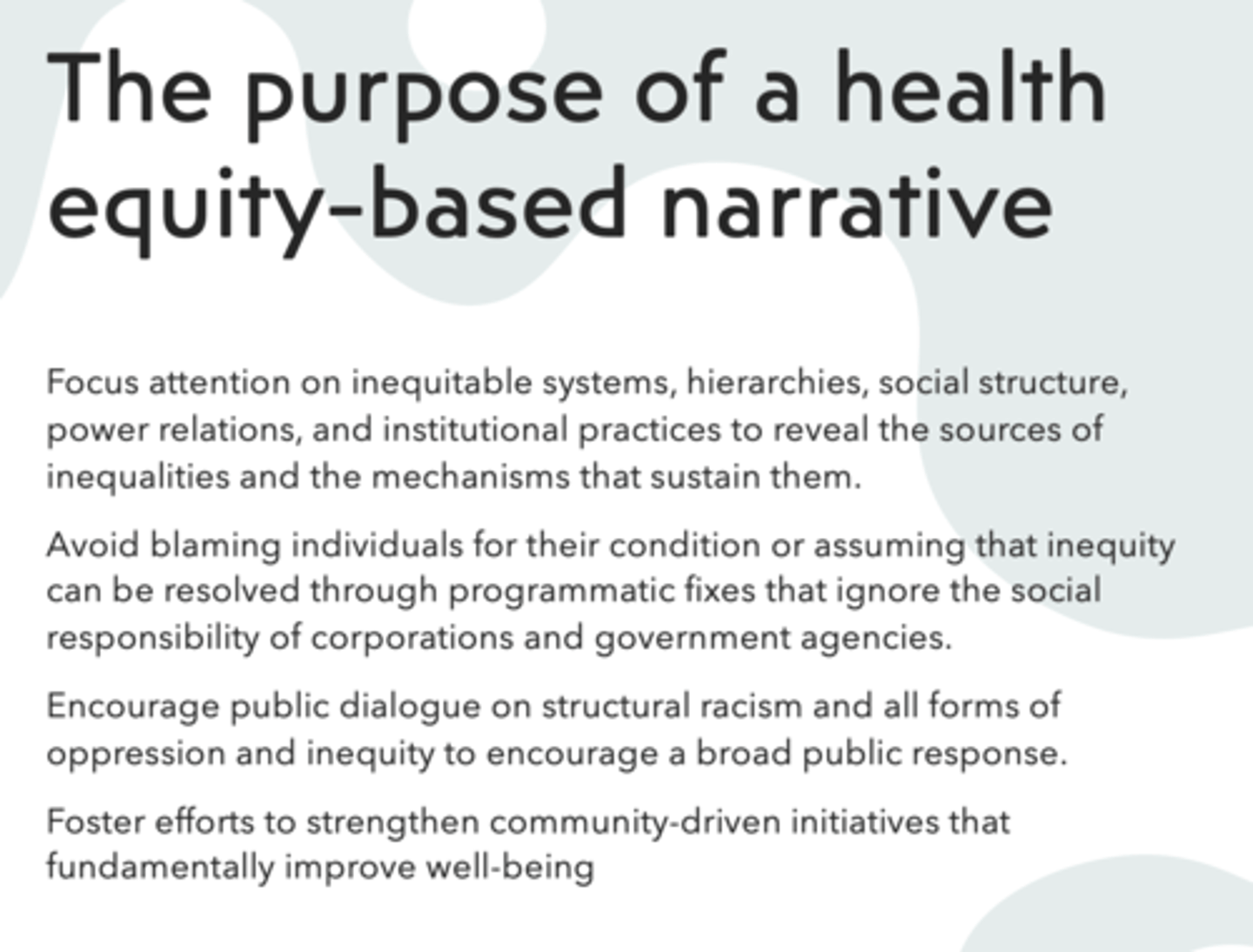
How does the health equity-based narrative suggest well-being can be fundamentally improved?
Through community-driven initiatives

Why should we avoid using terms like "vulnerable," "marginalized," or "high-risk" when describing populations?
They can be stigmatizing and they are vague and imply the problem is inherent to the group
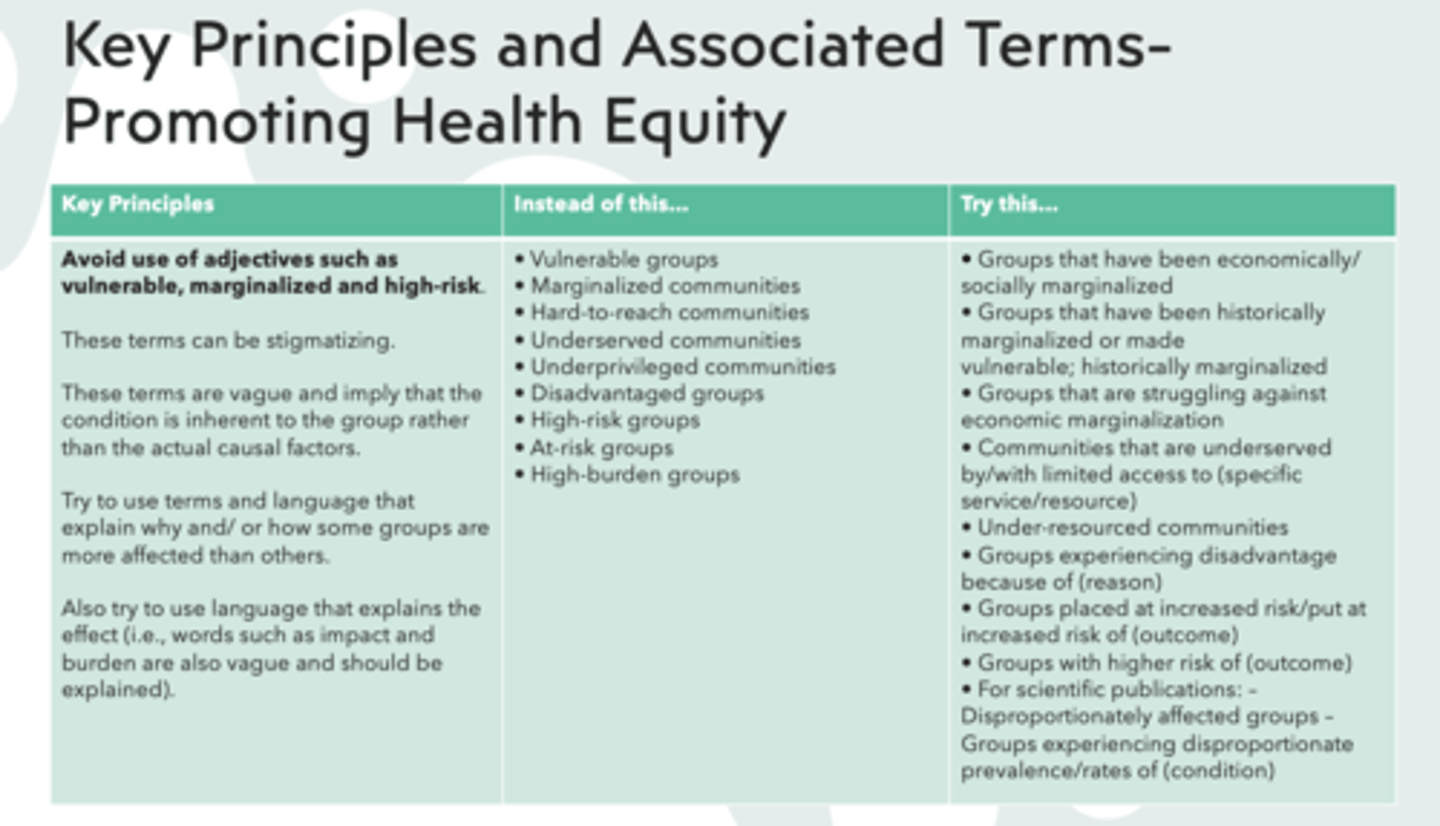
How can you use terms to promote health equity?
- Explain why and/ or how some groups are more affected than others.
- Use language that explains the effect (i.e., words such as impact and burden are also vague and should be explained).
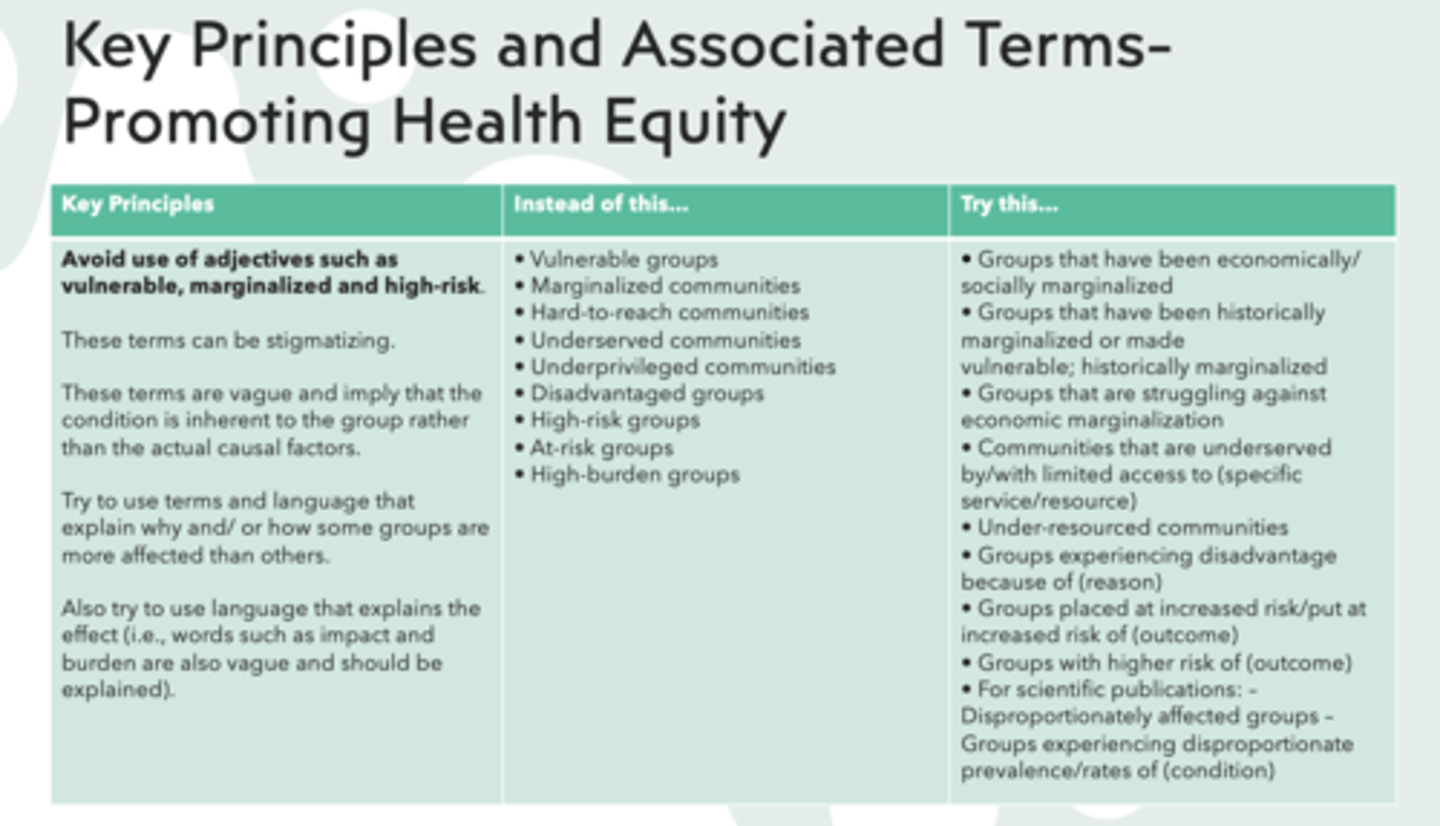
Instead of saying vulnerable groups, what should you say instead?
Groups that have been economically/ socially marginalized

Instead of saying marginalized communities, what should you say instead?
Groups that have been historically marginalized or made vulnerable; historically marginalized
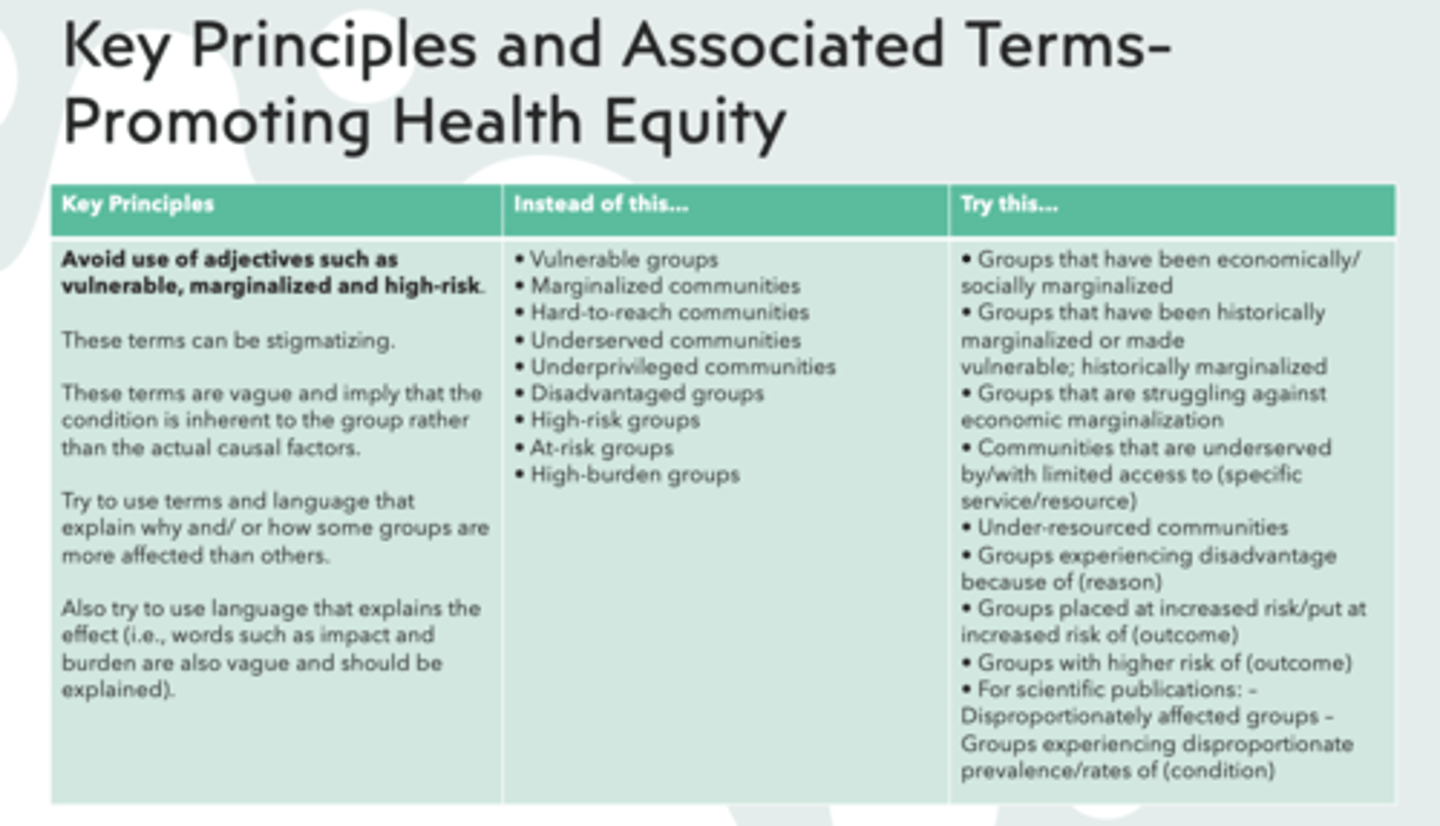
Instead of saying hard-to-reach communities, what should you say instead?
Groups that are struggling against economic marginalization
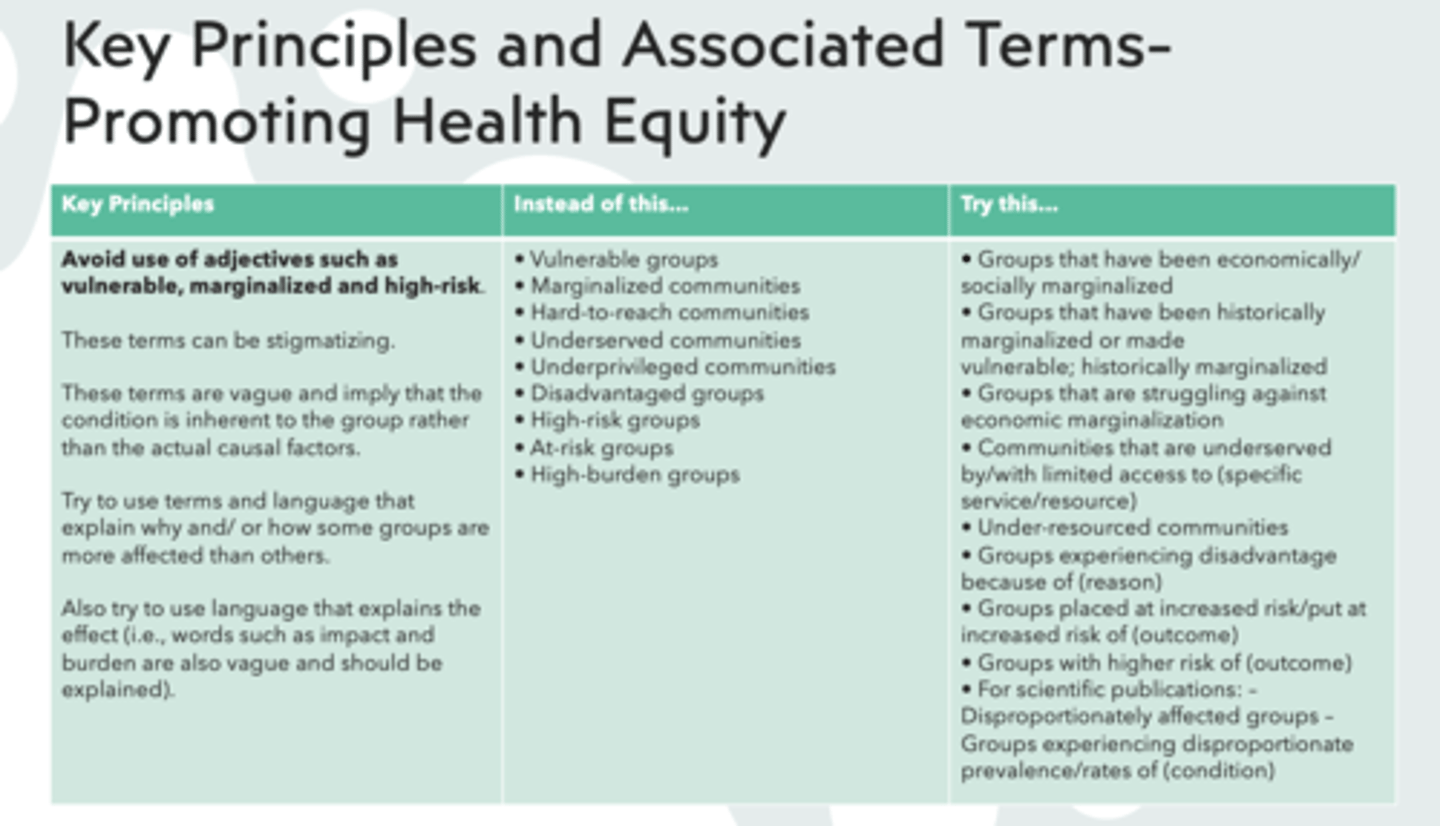
Instead of saying underserved communities, what should you say instead?
Communities that are underserved by/with limited access to (specific service/resource)
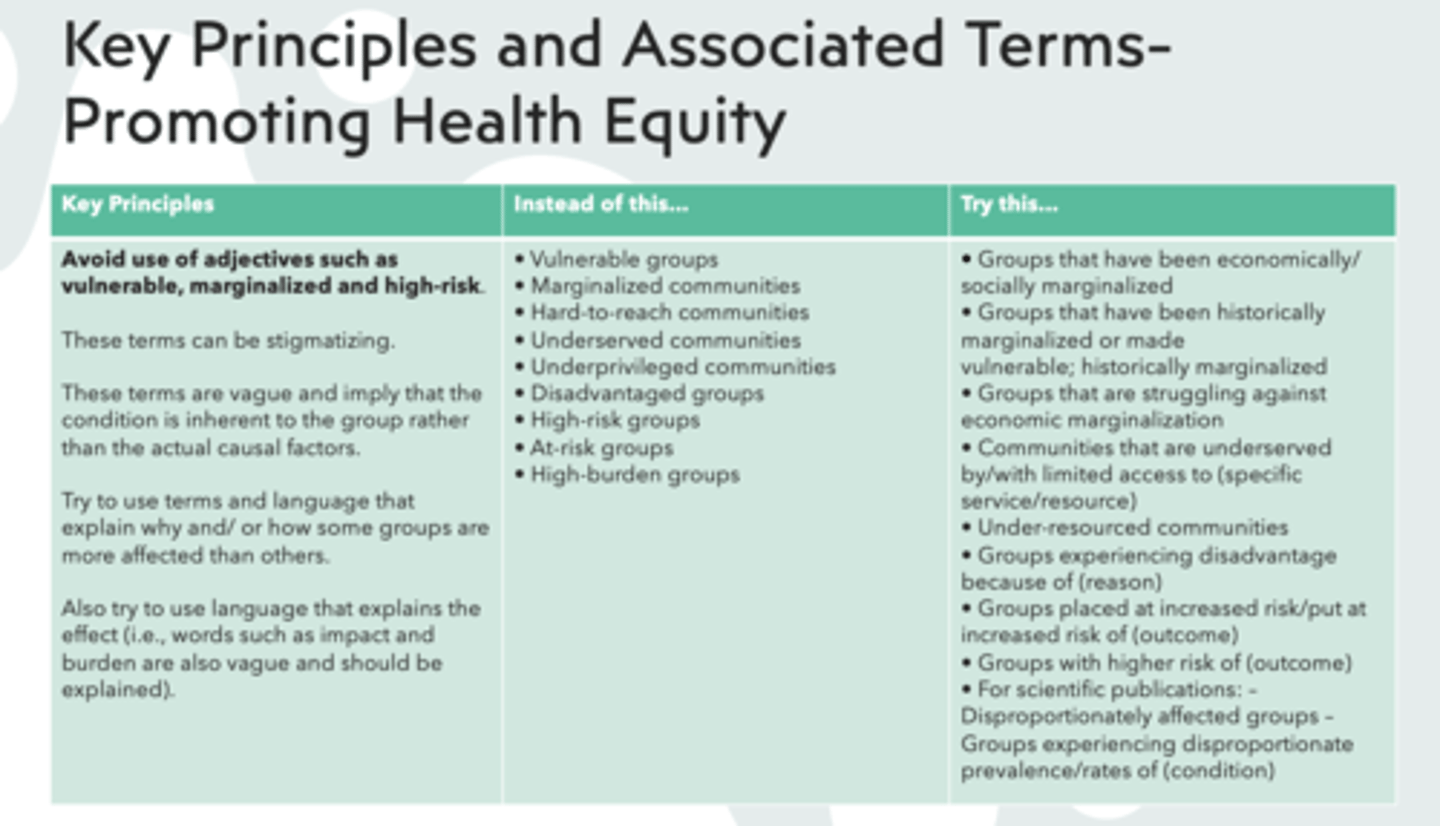
Instead of saying underprivileged communities, what should you say instead?
Under-resourced communities

Instead of saying disadvantaged groups, what should you say instead?
Groups experiencing disadvantage because of (reason)
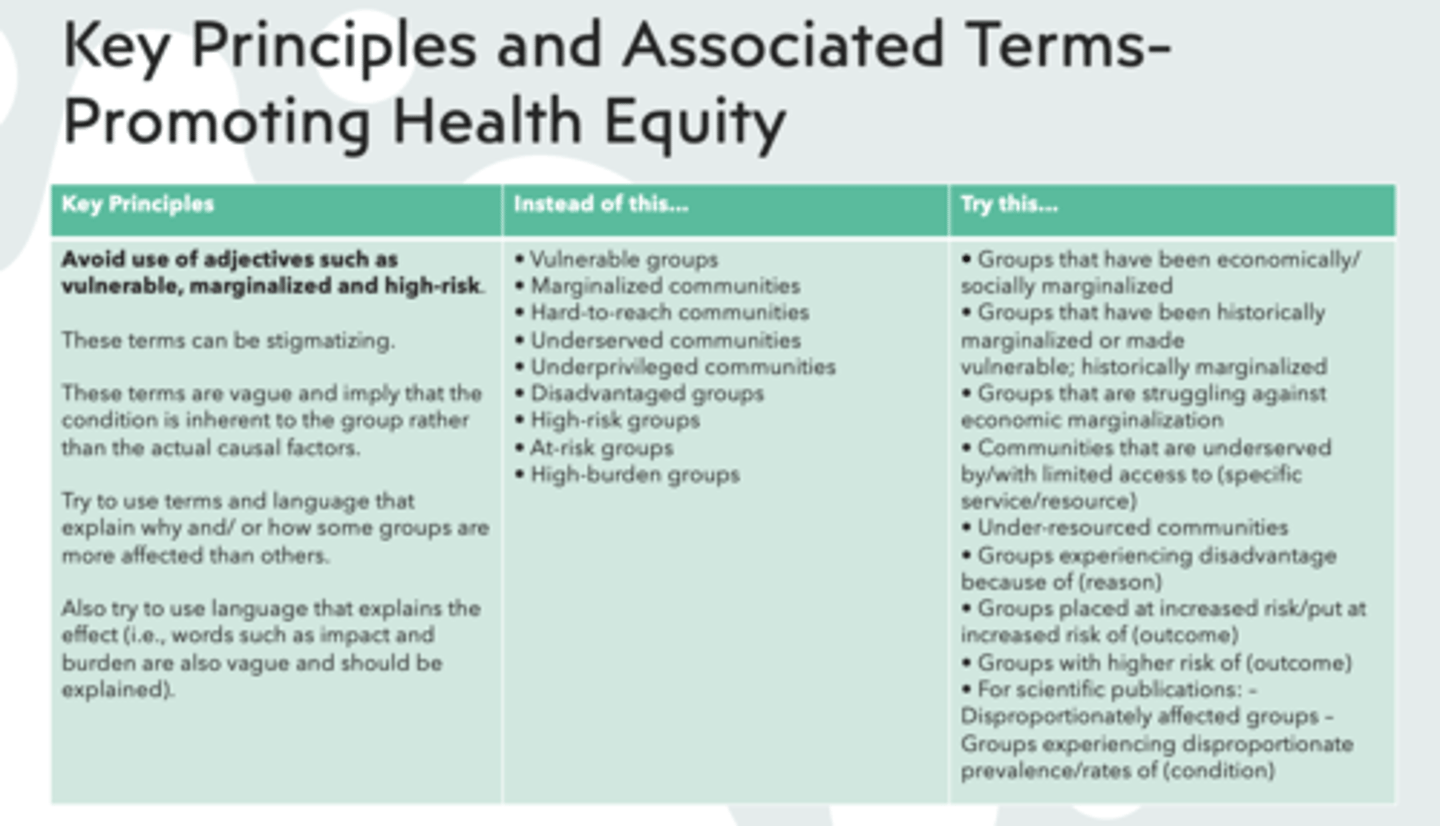
Instead of saying high-risk groups, what should you say instead?
Groups placed at increased risk/put at increased risk of (outcome)
